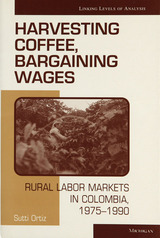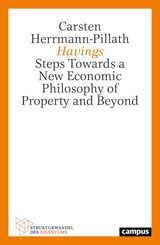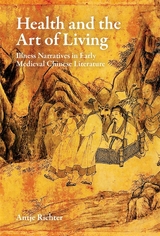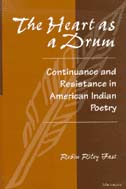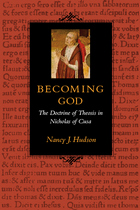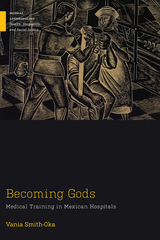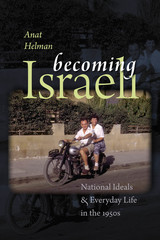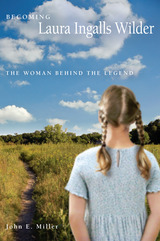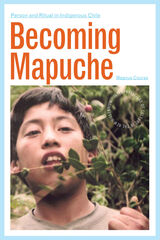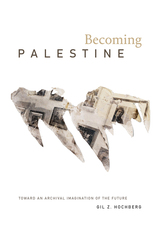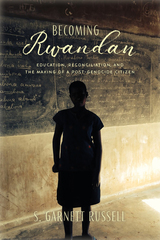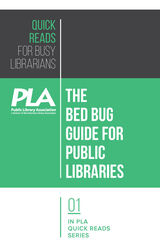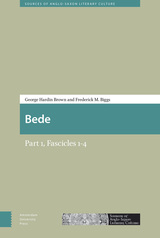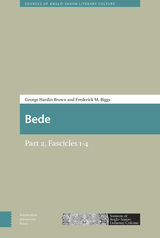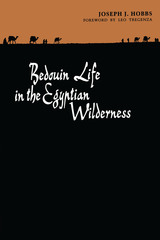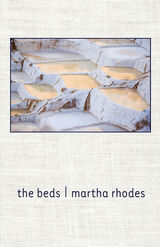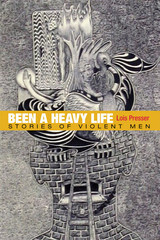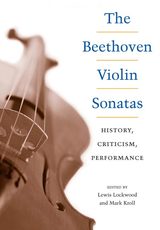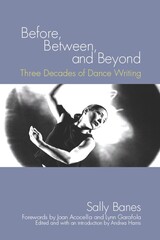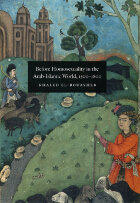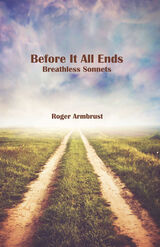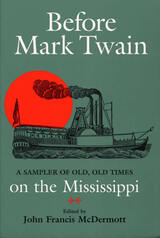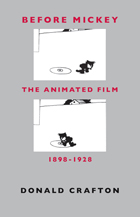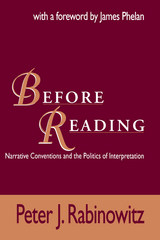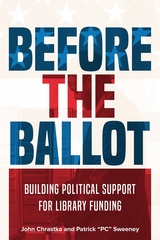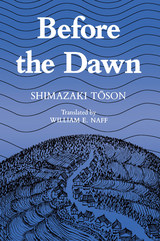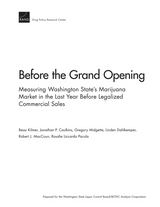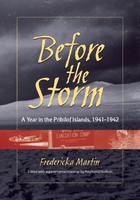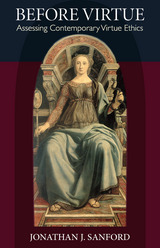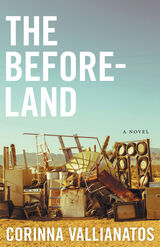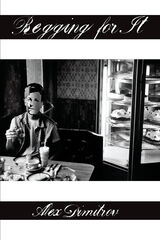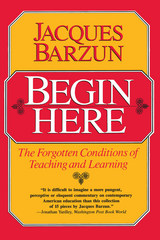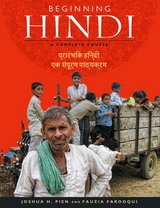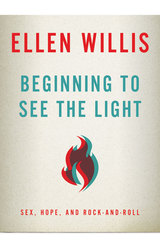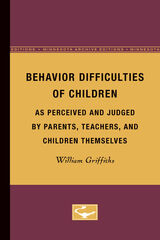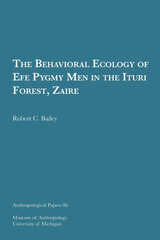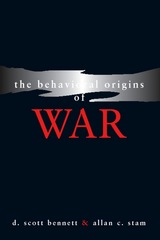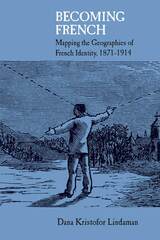 Becoming French: Mapping the Geographies of French Identity, 1871-1914
Dana Kristofor Lindaman
Northwestern University Press, 2016 Becoming French explores the geographical shift that occurs in French society during the first four decades of France's Third Republic government. Dana Kristofor Lindaman provides the historical context that led to the explosion of geographic interest at the end of the nineteenth century, exploring the ways that the work of the geographers Paul Vidal de la Blache and Élisée Reclus served as a conceptual basis for abstract notions of the nation such as la Patrie. Lindaman then uses Reclus's formulation of the earth as "une organisme terrestre" (terrestrial organism) to read Jules Verne's Voyage au centre de la terre (Journey to the Center of the Earth) as a journey to the center of the individual self. Finally, he traces the geographic narrative of G. Bruno's Tour de la France par deux enfants, in particular the way that Bruno's work incorporates the geographic thought of Vidal de la Blache, to discover the organic ties that bind readers through the shared experience of reading the text.
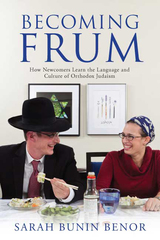 Becoming Frum: How Newcomers Learn the Language and Culture of Orthodox Judaism
Sarah Bunin Benor
Rutgers University Press, 2012 Winner, 2013 Sami Rohr Choice Award for Jewish Literature
When non-Orthodox Jews become frum (religious), they encounter much more than dietary laws and Sabbath prohibitions. They find themselves in the midst of a whole new culture, involving matchmakers, homemade gefilte fish, and Yiddish-influenced grammar. Becoming Frum explains how these newcomers learn Orthodox language and culture through their interactions with community veterans and other newcomers. Some take on as much as they can as quickly as they can, going beyond the norms of those raised in the community. Others maintain aspects of their pre-Orthodox selves, yielding unique combinations, like Matisyahu’s reggae music or Hebrew words and sing-song intonation used with American slang, as in “mamish (really) keepin’ it real.”
Sarah Bunin Benor brings insight into the phenomenon of adopting a new identity based on ethnographic and sociolinguistic research among men and women in an American Orthodox community. Her analysis is applicable to other situations of adult language socialization, such as students learning medical jargon or Canadians moving to Australia. Becoming Frum offers a scholarly and accessible look at the linguistic and cultural process of “becoming.”
Becoming God: The Doctrine of Theosis in Nicholas of Cusa
Nancy J. Hudson
Catholic University of America Press, 2007 The doctrine of theosis means a salvation that is the deification of the saved. The saved actually become God. This unusual doctrine lies at the heart of Nicholas of Cusa's (1401-1464) mystical metaphysics. It is here examined for the first time as a theme in its own right, along with its implications for Cusanus's doctrine of God, his theological anthropology, and his epistemology.
Becoming Gods: Medical Training in Mexican Hospitals
Vania Smith-Oka
Rutgers University Press, 2021 Through rich ethnographic narrative, Becoming Gods examines how a cohort of doctors-in-training in the Mexican city of Puebla learn to become doctors. Smith-Oka draws from compelling fieldwork, ethnography, and interviews with interns, residents, and doctors that tell the story of how medical trainees learn to wield new tools, language, and technology and how their white coat, stethoscope, and newfound technical, linguistic, and sensory skills lend them an authority that they cultivate with each practice, transforming their sense of self. Becoming Gods illustrates the messy, complex, and nuanced nature of medical training, where trainees not only have to acquire a monumental number of skills but do so against a backdrop of strict hospital hierarchy and a crumbling national medical system that deeply shape who they are.
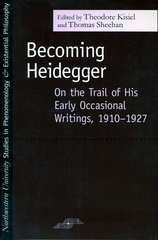 Becoming Heidegger: On the Trail of His Early Occasional Writings, 1910-1927
Theodore Kisiel
Northwestern University Press, 2007 In the decades since Martin Heidegger's death, many of his early writings--notes and talks, essays and reviews--have made it into print, but in such scattershot fashion and erratic translation as to mitigate their usefulness for understanding the development, direction, and ultimate shape of his work. This timely collection, edited by two preeminent Heidegger scholars, brings together in English translation the most philosophical of Heidegger's earliest occasional writings from 1910 to the end of 1927. These important philosophical documents fill out the context in which the early Heidegger wrote his major works and provide the background against which they appeared.
Accompanied by incisive commentary, these pieces from Heidegger's student days, his early Freiburg period, and the time of his Marburg lecture courses will contribute substantially to rethinking the making and meaning of Being and Time. The contents are of a depth and quality that make this volume the collection for those interested in Heidegger's work prior to his masterwork. The book will also serve those concerned with Heidegger's relation to such figures as Aristotle, Dilthey, Husserl, Jaspers, and Löwith, as well as scholars whose interests are more topically centered on questions of history, logic, religion, and truth. Important in their own right, these pieces will also prove particularly useful to students of Heidegger's thought and of twentieth-century philosophy in general.
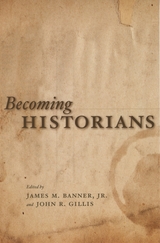 Becoming Historians
Edited by James M. Banner, Jr. and John R. Gillis
University of Chicago Press, 2009 In this unique collection, the memoirs of eleven historians provide a fascinating portrait of a formative generation of scholars. Born around the time of World War II, these influential historians came of age just before the upheavals of the 1960s and ’70s and helped to transform both their discipline and the broader world of American higher education. The self-inventions they thoughtfully chronicle led, in many cases, to the invention of new fields—including women’s and gender history, social history, and public history—that cleared paths in the academy and made the study of the past more capacious and broadly relevant. In these stories—skillfully compiled and introduced by James Banner and John Gillis—aspiring historians will find inspiration and guidance, experienced scholars will see reflections of their own dilemmas and struggles, and all readers will discover a rare account of how today’s seasoned historians embarked on their intellectual journeys.
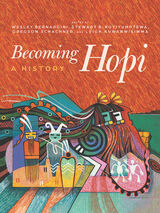 Becoming Hopi: A History
Edited by Wesley Bernardini, Stewart B. Koyiyumptewa, Gregson Schachner, and Leigh Kuwanwisiwma
University of Arizona Press, 2021 Becoming Hopi is a comprehensive look at the history of the people of the Hopi Mesas as it has never been told before. The Hopi Tribe is one of the most intensively studied Indigenous groups in the world. Most popular accounts of Hopi history romanticize Hopi society as “timeless.” The archaeological record and accounts from Hopi people paint a much more dynamic picture, full of migrations, gatherings, and dispersals of people; a search for the center place; and the struggle to reconcile different cultural and religious traditions. Becoming Hopi weaves together evidence from archaeology, oral tradition, historical records, and ethnography to reconstruct the full story of the Hopi Mesas, rejecting the colonial divide between “prehistory” and “history.”
The Hopi and their ancestors have lived on the Hopi Mesas for more than two thousand years, a testimony to sustainable agricultural practices that supported one of the largest populations in the Pueblo world. Becoming Hopi is a truly collaborative volume that integrates Indigenous voices with more than fifteen years of archaeological and ethnographic fieldwork. Accessible and colorful, this volume presents groundbreaking information about Ancestral Pueblo villages in the greater Hopi Mesas region, making it a fascinating resource for anyone who wants to learn about the rich and diverse history of the Hopi people and their enduring connection to the American Southwest.
Contributors: Lyle Balenquah, Wesley Bernardini, Katelyn J. Bishop, R. Kyle Bocinsky, T. J. Ferguson, Saul L. Hedquist, Maren P. Hopkins, Stewart B. Koyiyumptewa, Leigh Kuwanwisiwma, Mowana Lomaomvaya, Lee Wayne Lomayestewa, Joel Nicholas, Matthew Peeples, Gregson Schachner, R. J. Sinensky, Julie Solometo, Kellam Throgmorton, Trent Tu’tsi
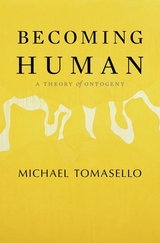 Becoming Human: A Theory of Ontogeny
Michael Tomasello
Harvard University Press, 2019 Winner of the William James Book Award
Winner of the Eleanor Maccoby Book Award
“A landmark in our understanding of human development.”
—Paul Harris, author of Trusting What You’re Told
“Magisterial…Makes an impressive argument that most distinctly human traits are established early in childhood and that the general chronology in which these traits appear can…be identified.”
—Wall Street Journal
Virtually all theories of how humans have become such a distinctive species focus on evolution. Becoming Human looks instead to development and reveals how those things that make us unique are constructed during the first seven years of a child’s life.
In this groundbreaking work, Michael Tomasello draws from three decades of experimental research with chimpanzees, bonobos, and children to propose a new framework for psychological growth between birth and seven years of age. He identifies eight pathways that differentiate humans from their primate relatives: social cognition, communication, cultural learning, cooperative thinking, collaboration, prosociality, social norms, and moral identity. In each of these, great apes possess rudimentary abilities, but the maturation of humans’ evolved capacities for shared intentionality transform these abilities into uniquely human cognition and sociality.
“How does human psychological growth run in the first seven years, in particular how does it instill ‘culture’ in us? …Most of all, how does the capacity for shared intentionality and self-regulation evolve in people? This is a very thoughtful and also important book.”
—Tyler Cowen, Marginal Revolution
“Theoretically daring and experimentally ingenious, Becoming Human squarely tackles the abiding question of what makes us human.”
—Susan Gelman
“Destined to become a classic. Anyone who is interested in cognitive science, child development, human evolution, or comparative psychology should read this book.”
—Andrew Meltzoff
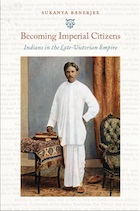 Becoming Imperial Citizens: Indians in the Late-Victorian Empire
Sukanya Banerjee
Duke University Press, 2010 In this remarkable account of imperial citizenship, Sukanya Banerjee investigates the ways that Indians formulated notions of citizenship in the British Empire from the late nineteenth century through the early twentieth. Tracing the affective, thematic, and imaginative tropes that underwrote Indian claims to formal equality prior to decolonization, she emphasizes the extralegal life of citizenship: the modes of self-representation it generates even before it is codified and the political claims it triggers because it is deferred. Banerjee theorizes modes of citizenship decoupled from the rights-conferring nation-state; in so doing, she provides a new frame for understanding the colonial subject, who is usually excluded from critical discussions of citizenship. Interpreting autobiography, fiction, election speeches, economic analyses, parliamentary documents, and government correspondence, Banerjee foregrounds the narrative logic sustaining the unprecedented claims to citizenship advanced by racialized colonial subjects. She focuses on the writings of figures such as Dadabhai Naoroji, known as the first Asian to be elected to the British Parliament; Surendranath Banerjea, among the earliest Indians admitted into the Indian Civil Service; Cornelia Sorabji, the first woman to study law in Oxford and the first woman lawyer in India; and Mohandas K. Gandhi, who lived in South Africa for nearly twenty-one years prior to his involvement in Indian nationalist politics. In her analysis of the unexpected registers through which they carved out a language of formal equality, Banerjee draws extensively from discussions in both late-colonial India and Victorian Britain on political economy, indentured labor, female professionalism, and bureaucratic modernity. Signaling the centrality of these discussions to the formulations of citizenship, Becoming Imperial Citizens discloses a vibrant transnational space of political action and subjecthood, and it sheds new light on the complex mutations of the category of citizenship.
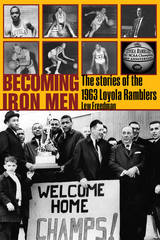 Becoming Iron Men: The Story of the 1963 Loyola Ramblers
Lew Freedman
Texas Tech University Press, 2014 The greatest untold story in college basketball history
Loyola University Chicago was ahead of its time when racial matters were forefront in a long overdue revolution in civil rights. The Ramblers of the 1962-1963 NCAA college basketball season were pioneers in race relations in sport, though most of the time they were simply playing the sport they loved.
When the NCAA tournament began in March, the Ramblers engaged in a series for the ages, daring to be the first NCAA Division I school to play five black athletes on the court at once and capturing the most prestigious title in college basketball at a time when states below the Mason-Dixon line still had laws on the books preventing black and white athletes from mixing even in pick-up games.
Records were set, rivals faced, and one of the most famous and significant contests in college basketball playoff history played out in what incidentally became a model showcase for race relations. Nearly every time the Ramblers took the court, the game was unique in its magnitude.
Relying significantly on exclusive interviews with surviving players, now in their seventies, Lew Freedman chronicles the entire journey, the adventure of the season that bound tight for a lifetime the group of men who lived through it.
Becoming Israeli: National Ideals and Everyday Life in the 1950s
Anat Helman
Brandeis University Press, 2014 With a light touch and many wonderful illustrations, historian Anat Helman investigates "life on the ground" in Israel during the first years of statehood. She looks at how citizens--natives of the land, longtime immigrants, and newcomers--coped with the state's efforts to turn an incredibly diverse group of people into a homogenous whole. She investigates the efforts to make Hebrew the lingua franca of Israel, the uses of humor, and the effects of a constant military presence, along with such familiar aspects of daily life as communal dining on the kibbutz, the nightmare of trying to board a bus, and moviegoing as a form of escapism. In the process Helman shows how ordinary people adapted to the standards and rules of the political and cultural elites and negotiated the chaos of early statehood.
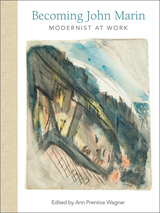 Becoming John Marin: Modernist at Work
Ann Prentice Wagner
University of Arkansas Press, 2018 John Marin was a major figure among the cutting-edge circle of American modernist artists who showed his work in Alfred Stieglitz’s New York galleries from 1909 until 1950. A new collection of the artist’s work at the Arkansas Arts Center, given by Marin’s daughter-in-law, forms the basis of this first book of essays and images to concentrate on Marin’s drawings in the context of Marin’s life, his watercolors, and his etchings. We follow Marin to his most famous subject matter: New York City and the coast of Maine. Foundational drawings and an unfinished watercolor of the towering Woolworth Building, still under construction when they were made in 1912, begin the story of a renowned group of watercolors first exhibited in 1913 at Alfred Stieglitz’s 291 Gallery and then at the ground-breaking 1913 Armory Show. Other images take us to lesser-known locales, such as the Ramapo Mountains in New York and New Jersey where Marin often painted when he couldn’t get to Maine. More obscure aspects of the artist’s career explored in this collection include portraits of friends and family, charming drawings of animals, and circus scenes. Becoming John Marin invites readers to look over this important artist’s shoulder as he created and honed the sketches he would interpret into completed watercolors and etchings, illustrating the evolution of his style and methods as he transformed from intuitive draftsman to innovative modernist watercolorist and etcher.
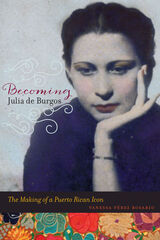 Becoming Julia de Burgos: The Making of a Puerto Rican Icon
Vanessa Perez Rosario
University of Illinois Press, 2014 While it is rare for a poet to become a cultural icon, Julia de Burgos has evoked feelings of bonding and identification in Puerto Ricans and Latinos in the United States for over half a century.
In the first book-length study written in English, Vanessa Pérez-Rosario examines poet and political activist Julia de Burgos's development as a writer, her experience of migration, and her legacy in New York City, the poet's home after 1940. Pérez-Rosario situates Julia de Burgos as part of a transitional generation that helps to bridge the historical divide between Puerto Rican nationalist writers of the 1930s and the Nuyorican writers of the 1970s. Becoming Julia de Burgos departs from the prevailing emphasis on the poet and intellectual as a nationalist writer to focus on her contributions to New York Latino/a literary and visual culture. It moves beyond the standard tragedy-centered narratives of de Burgos's life to place her within a nuanced historical understanding of Puerto Rico's peoples and culture to consider more carefully the complex history of the island and the diaspora. Pérez-Rosario unravels the cultural and political dynamics at work when contemporary Latina/o writers and artists in New York revise, reinvent, and riff off of Julia de Burgos as they imagine new possibilities for themselves and their communities.
Becoming Laura Ingalls Wilder: The Woman behind the Legend
John E. Miller
University of Missouri Press, 2005 Although generations of readers of the Little House books are familiar with Laura Ingalls Wilder’s early life up through her first years of marriage to Almanzo Wilder, few know about her adult years. Going beyond previous studies, Becoming Laura Ingalls Wilder focuses upon Wilder’s years in Missouri from 1894 to 1957. Utilizing her unpublished autobiography, letters, newspaper stories, and other documentary evidence, John E. Miller fills the gaps in Wilder’s autobiographical novels and describes her sixty-three years of living in Mansfield, Missouri. As a result, the process of personal development that culminated in Wilder’s writing of the novels that secured her reputation as one of America’s most popular children’s authors becomes evident.
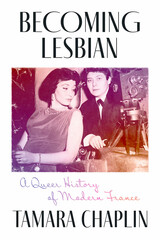 Becoming Lesbian: A Queer History of Modern France
Tamara Chaplin
University of Chicago Press, 2024 A landmark analysis of how a marginalized subculture used modern media to transform public attitudes toward sexual desire.
In Becoming Lesbian, historian Tamara Chaplin argues that the history of female same-sex intimacy is central to understanding the struggle to control the public sphere. This monumental study draws on undiscovered sources culled from cabaret culture, sexology, police files, radio, TV, photography, the Minitel (an early form of internet), and private letters, as well as over one hundred interviews filmed by the author. Becoming Lesbian demonstrates how women of diverse classes and races came to define themselves as lesbian and used public spaces and public media to exert claims on the world around them in ways that made possible new forms of gendered and sexual citizenship. Chaplin begins in the sapphic cabarets of interwar Paris. These venues, she shows, exploited female same-sex desire for profit while simultaneously launching an incipient queer female counterpublic. Refuting claims that World War II destroyed this female world, Chaplin reveals instead how prewar sapphic subcultures flourished in the postwar period, laying crucial groundwork for the politicization of lesbian identity into the twenty-first century.
Becoming Lesbian is filled with colorful vignettes about female cabaret owners, singers, TV personalities, writers, and activists, all brought to life to make larger points about rights, belonging, and citizenship. As a history of lesbianism, this book represents a major contribution to modern French history, queer studies, and genealogies of the media and its publics.
Becoming Mapuche: Person and Ritual in Indigenous Chile
Magnus Course
University of Illinois Press, 2011 Magnus Course blends convincing historical analysis with sophisticated contemporary theory in this superb ethnography of the Mapuche people of southern Chile. Based on many years of ethnographic fieldwork, Becoming Mapuche takes readers to the indigenous reserves where many Mapuche have been forced to live since the beginning of the twentieth century. In addition to accounts of the intimacies of everyday kinship and friendship, Course also offers the first complete ethnographic analyses of the major social events of contemporary rural Mapuche life--eluwün funerals, the ritual sport of palin, and the great ngillatun fertility ritual. The volume includes a glossary of terms in Mapudungun.
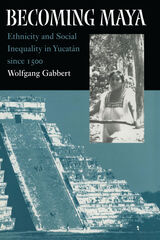 Becoming Maya: Ethnicity and Social Inequality in Yucatán since 1500
Wolfgang Gabbert
University of Arizona Press, 2004 In Mexico's Yucatán peninsula, it is commonly held that the population consists of two ethnic communities: Maya Indians and descendants of Spanish conquerors. As a result, the history of the region is usually seen in terms of conflict between conquerors and conquered that too often ignores the complexity of interaction between these groups and the complex nature of identity within them. Yet despite this prevailing view, most speakers of the Yucatec Maya language reject being considered Indian and refuse to identify themselves as Maya. Wolfgang Gabbert maintains that this situation can be understood only by examining the sweeping procession of history in the region. In Becoming Maya, he has skillfully interwoven history and ethnography to trace 500 years of Yucatec history, covering colonial politics, the rise of plantations, nineteenth-century caste wars, and modern reforms—always with an eye toward the complexities of ethnic categorization. According to Gabbert, class has served as a self-defining category as much as ethnicity in the Yucatán, and although we think of caste wars as struggles between Mayas and Mexicans, he shows that each side possessed a sufficiently complex ethnic makeup to rule out such pat observations. Through this overview, Gabbert reveals that Maya ethnicity is upheld primarily by outsiders who simply assume that an ethnic Maya consciousness has always existed among the Maya-speaking people. Yet even language has been a misleading criterion, since many people not considered Indian are native speakers of Yucatec. By not taking ethnicity for granted, he demonstrates that the Maya-speaking population has never been a self-conscious community and that the criteria employed by others in categorizing Mayas has changed over time. Grounded in field studies and archival research and boasting an exhaustive bibliography, Becoming Maya is the first English-language study that examines the roles played by ethnicity and social inequality in Yucatán history. By revealing the highly nuanced complexities that underlie common stereotypes, it offers new insights not only into Mesoamerican peoples but also into the nature of interethnic relations in general.
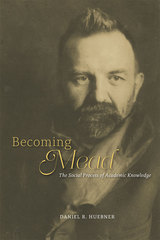 Becoming Mead: The Social Process of Academic Knowledge
Daniel R. Huebner
University of Chicago Press, 2014 George Herbert Mead is a foundational figure in sociology, best known for his book Mind, Self, and Society, which was put together after his death from course notes taken by stenographers and students and from unpublished manuscripts. Mead, however, never taught a course primarily housed in a sociology department, and he wrote about a wide variety of topics far outside of the concerns for which he is predominantly remembered—including experimental and comparative psychology, the history of science, and relativity theory. In short, he is known in a discipline in which he did not teach for a book he did not write.
In Becoming Mead, Daniel R. Huebner traces the ways in which knowledge has been produced by and about the famed American philosopher. Instead of treating Mead’s problematic reputation as a separate topic of study from his intellectual biography, Huebner considers both biography and reputation as social processes of knowledge production. He uses Mead as a case study and provides fresh new answers to critical questions in the social sciences, such as how authors come to be considered canonical in particular disciplines, how academics understand and use others’ works in their research, and how claims to authority and knowledge are made in scholarship. Becoming Mead provides a novel take on the history of sociology, placing it in critical dialogue with cultural sociology and the sociology of knowledge and intellectuals.
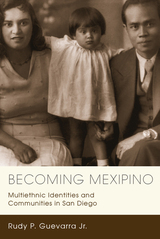 Becoming Mexipino: Multiethnic Identities and Communities in San Diego
Guevarra, Rudy P
Rutgers University Press, 2012 Becoming Mexipino is a social-historical interpretation of two ethnic groups, one Mexican, the other Filipino, whose paths led both groups to San Diego, California. Rudy Guevarra traces the earliest interactions of both groups with Spanish colonialism to illustrate how these historical ties and cultural bonds laid the foundation for what would become close interethnic relationships and communities in twentieth-century San Diego as well as in other locales throughout California and the Pacific West Coast.
Through racially restrictive covenants and other forms of discrimination, both groups, regardless of their differences, were confined to segregated living spaces along with African Americans, other Asian groups, and a few European immigrant clusters. Within these urban multiracial spaces, Mexicans and Filipinos coalesced to build a world of their own through family and kin networks, shared cultural practices, social organizations, and music and other forms of entertainment. They occupied the same living spaces, attended the same Catholic churches, and worked together creating labor cultures that reinforced their ties, often fostering marriages. Mexipino children, living simultaneously in two cultures, have forged a new identity for themselves. Their lives are the lens through which these two communities are examined, revealing the ways in which Mexicans and Filipinos interacted over generations to produce this distinct and instructive multiethnic experience. Using archival sources, oral histories, newspapers, and personal collections and photographs, Guevarra defines the niche that this particular group carved out for itself.
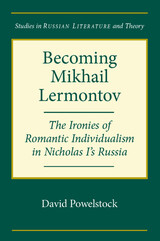 Becoming Mikhail Lermontov: The Ironies of Romantic Individualism in Nicholas I's Russia
David Powelstock
Northwestern University Press, 2011 Mikhail Lermontov (1814-1841) is one of Russia's most prominent poets--and one of its most puzzling. In this radically new interpretation, David Powelstock reveals how the seeming contradictions in Lermontov's life and works can be understood as manifestations of a coherent worldview.
By bringing to light Lermontov's operative version of Romantic individualism, Powelstock is able to make sense of the poet's relationship to "romantic irony," his highly modern concept of the reader (both real, and implied in the text), and his vexed passion for his predecessor Alexander Pushkin--a relationship that is almost always treated sentimentally, but is here given its true competitive edge. Furthermore, Powelstock offers the most persuasive account ever given of Lermontov's exceptionally odd treatment of, and success with, women--both in real life and in fiction--and of his cruel overlapping of these two planes.
Clarifying what has remained perplexing for so long, and correcting what has been misinterpreted, Powelstock's work illuminates Lermontov's views of dignity, death, love, nature, society, and ethics--and, finally, gives us an intellectual biography that is deeper and more subtle than any written before.
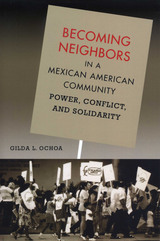 Becoming Neighbors in a Mexican American Community: Power, Conflict, and Solidarity
By Gilda L. Ochoa
University of Texas Press, 2004 On the surface, Mexican Americans and Mexican immigrants to the United States seem to share a common cultural identity but often make uneasy neighbors. Discrimination and assimilationist policies have influenced generations of Mexican Americans so that some now fear that the status they have gained by assimilating into American society will be jeopardized by Spanish-speaking newcomers. Other Mexican Americans, however, adopt a position of group solidarity and work to better the social conditions and educational opportunities of Mexican immigrants. Focusing on the Mexican-origin, working-class city of La Puente in Los Angeles County, California, this book examines Mexican Americans' everyday attitudes toward and interactions with Mexican immigrants—a topic that has so far received little serious study. Using in-depth interviews, participant observations, school board meeting minutes, and other historical documents, Gilda Ochoa investigates how Mexican Americans are negotiating their relationships with immigrants at an interpersonal level in the places where they shop, worship, learn, and raise their families. This research into daily lives highlights the centrality of women in the process of negotiating and building communities and sheds new light on identity formation and group mobilization in the U.S. and on educational issues, especially bilingual education. It also complements previous studies on the impact of immigration on the wages and employment opportunities of Mexican Americans.
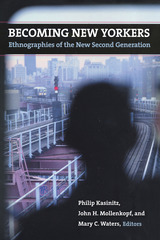 Becoming New Yorkers: Ethnographies of the New Second Generation
Philip Kasinitz
Russell Sage Foundation, 2004 More than half of New Yorkers under the age of eighteen are the children of immigrants. This second generation shares with previous waves of immigrant youth the experience of attempting to reconcile their cultural heritage with American society. In Becoming New Yorkers, noted social scientists Philip Kasinitz, John Mollenkopf, and Mary Waters bring together in-depth ethnographies of some of New York's largest immigrant populations to assess the experience of the new second generation and to explore the ways in which they are changing the fabric of American culture. Becoming New Yorkers looks at the experience of specific immigrant groups, with regard to education, jobs, and community life. Exploring immigrant education, Nancy López shows how teachers' low expectations of Dominican males often translate into lower graduation rates for boys than for girls. In the labor market, Dae Young Kim finds that Koreans, young and old alike, believe the second generation should use the opportunities provided by their parents' small business success to pursue less arduous, more rewarding work than their parents. Analyzing civic life, Amy Forester profiles how the high-ranking members of a predominantly black labor union, who came of age fighting for civil rights in the 1960s, adjust to an increasingly large Caribbean membership that sees the leaders not as pioneers but as the old-guard establishment. In a revealing look at how the second-generation views itself, Sherry Ann Butterfield and Aviva Zeltzer-Zubida point out that black West Indian and Russian Jewish immigrants often must choose whether to identify themselves alongside those with similar skin color or to differentiate themselves from both native blacks and whites based on their unique heritage. Like many other groups studied here, these two groups experience race as a fluid, situational category that matters in some contexts but is irrelevant in others. As immigrants move out of gateway cities and into the rest of the country, America will increasingly look like the multicultural society vividly described in Becoming New Yorkers. This insightful work paints a vibrant picture of the experience of second generation Americans as they adjust to American society and help to shape its future.
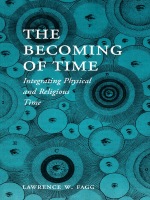 The Becoming of Time: Integrating Physical and Religious Time
Lawrence W. Fagg
Duke University Press, 2002 Now available in an updated edition: Integrating concepts of time derived from the physical sciences and world religions, The Becoming of Time examines various questions about time, including its origin, its relation to space and motion, its irreversible nature, the notion of timelessness, and the reality of the future. Lawrence W. Fagg contends that the use of spatial metaphors to describe time obscures its true character. He offers an alternative, non-spatial description of time by developing the concept of time as becoming. ”This lucid and wide-ranging study sets out to reconcile the objective and subjective perspectives in the investigation of the phenomenon of time. [Lawrence W. Fagg] . . . explores the wondrous subtleties of time that modern physics continues to reveal, but complements them with the rich insights of the spiritual perspectives on time that the world's major religions have to offer.”—Helga Nowotny, Former President, International Society for the Study of Time ”Lawrence W. Fagg has made a fundamental contribution to our reflection upon time. His work immediately takes its place as a basic text for students and researchers, from college to seminary and university levels.”—Philip Hefner, Director, Zygon Center for Religion and Science
Becoming Palestine: Toward an Archival Imagination of the Future
Gil Z. Hochberg
Duke University Press, 2021 In Becoming Palestine, Gil Z. Hochberg examines how contemporary Palestinian artists, filmmakers, dancers, and activists use the archive in order to radically imagine Palestine's future. She shows how artists such as Jumana Manna, Kamal Aljafari, Larissa Sansour, Farah Saleh, Basel Abbas, and Ruanne Abou-Rahme reimagine the archive, approaching it not through the desire to unearth hidden knowledge, but to sever the identification of the archive with the past. In their use of archaeology, musical traditions, and archival film and cinematic footage, these artists imagine a Palestinian future unbounded from colonial space and time. By urging readers to think about archives as a break from history rather than as history's repository, Hochberg presents a fundamental reconceptualization of the archive's liberatory potential.
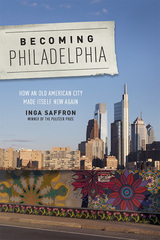 Becoming Philadelphia: How an Old American City Made Itself New Again
Inga Saffron
Rutgers University Press, 2020 Once dismissed as a rusting industrial has-been—the “Next Detroit”—Philadelphia has enjoyed an astonishing comeback in the 21st century. Over the past two decades, Inga Saffron has served as the premier chronicler of the city’s physical transformation as it emerged from a half century of decline. Through her Pulitzer Prize-winning columns on architecture and urbanism in the Philadelphia Inquirer, she has tracked the city’s revival on a weekly basis.
Becoming Philadelphia collects the best of Saffron’s work, plus a new introduction reflecting on the stunning changes the city has undergone. A fearless crusader who is also a seasoned reporter, Saffron ranges beyond the usual boundaries of architectural criticism to explore how big money and politics intersect with design, profoundly shaping our everyday experience of city life. Even as she celebrates Philadelphia’s resurgence, she considers how it finds itself grappling with the problems of success: gentrification, poverty, privatization, and the unequal distribution of public services.
What emerges in these 80 pieces is a remarkable narrative of a remarkable time. The proverbial first draft of history, these columns tell the story of how a great city shape-shifted before our very eyes.
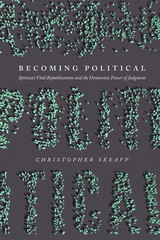 Becoming Political: Spinoza’s Vital Republicanism and the Democratic Power of Judgment
Christopher Skeaff
University of Chicago Press, 2018 In this pathbreaking work, Christopher Skeaff argues that a profoundly democratic conception of judgment is at the heart of Spinoza’s thought. Bridging Continental and Anglo-American scholarship, critical theory, and Spinoza studies, Becoming Political offers a historically sensitive, meticulous, and creative interpretation of Spinoza’s texts that reveals judgment as the communal element by which people generate power to resist domination and reconfigure the terms of their political association. If, for Spinoza, judging is the activity which makes a people powerful, it is because it enables them to contest the project of ruling and demonstrate the political possibility of being equally free to articulate the terms of their association. This proposition differs from a predominant contemporary line of argument that treats the people’s judgment as a vehicle of sovereignty—a means of defining and refining the common will. By recuperating in Spinoza’s thought a “vital republicanism,” Skeaff illuminates a line of political thinking that decouples democracy from the majoritarian aspiration to rule and aligns it instead with the project of becoming free and equal judges of common affairs. As such, this decoupling raises questions that ordinarily go unasked: what calls for political judgment, and who is to judge? In Spinoza’s vital republicanism, the political potential of life and law finds an affirmative relationship that signals the way toward a new constitutionalism and jurisprudence of the common.
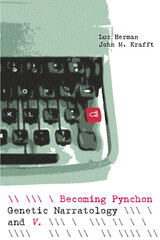 Becoming Pynchon: Genetic Narratology and V.
Luc Herman and John M. Krafft
Ohio State University Press, 2023 The 1963 publication of Thomas Pynchon’s V. changed the landscape of American fiction. Becoming Pynchon: Genetic Narratology and V. offers a detailed examination of the dramatic transformations that took place as Pynchon’s foundational novel went from typescript to published work. Luc Herman and John M. Krafft develop and deploy a rich theory of genetic narratology to examine the performance of genre in the novel. Pushing back against the current dominance of cognitive narratology, they discuss focalization, character construction, and evocation of consciousness as clues to Pynchon’s developing narratology of historical fiction. Their theoretical interventions offer an important and timely corrective to the field of narratology with a method that brings the author back into the analytical frame. Herman and Krafft use as their guide the typescript of V. that surfaced in 2001, when it was acquired by the Harry Ransom Humanities Research Center, as well as Pynchon’s editorial correspondence with Corlies Smith, his first editor at J. B. Lippincott. Becoming Pynchon assembles a comprehensive and unequaled picture of Pynchon’s writing process that will appeal both to Pynchonians and to postmodernism scholars more broadly.
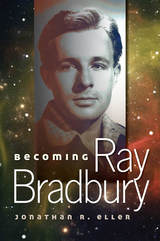 Becoming Ray Bradbury
Jonathan R. Eller
University of Illinois Press, 2013 Becoming Ray Bradbury chronicles the making of an iconic American writer by exploring Ray Bradbury's childhood and early years of his long life in fiction, film, television, radio, and theater. Jonathan R. Eller measures the impact of the authors, artists, illustrators, and filmmakers who stimulated Bradbury's imagination throughout his first three decades. Unprecedented access to Bradbury's personal papers and other private collections provides insight into his emerging talent through his unpublished correspondence, his rare but often insightful notes on writing, and his interactions with those who mentored him during those early years. Beginning with his childhood in Waukegan, Illinois, and Los Angeles, this biography follows Bradbury's development from avid reader to maturing author, making a living writing for the genre pulps and mainstream magazines. Eller illuminates the sources of Bradbury's growing interest in the human mind, the human condition, and the ambiguities of life and death--themes that became increasingly apparent in his early fiction. Bradbury's correspondence documents his frustrating encounters with the major trade publishing houses and his earliest unpublished reflections on the nature of authorship. Eller traces the sources of Bradbury's very conscious decisions, following the sudden success of The Martian Chronicles and The Illustrated Man, to voice controversial political statements in his fiction. Eller also elucidates the complex creative motivations that yielded Fahrenheit 451. Becoming Ray Bradbury reveals Bradbury's emotional world as it matured through his explorations of cinema and art, his interactions with agents and editors, his reading discoveries, and the invaluable reading suggestions of older writers. These largely unexplored elements of his life pave the way to a deeper understanding of his more public achievements, providing a biography of the mind, the story of Bradbury's self-education and the emerging sense of authorship at the heart of his boundless creativity.
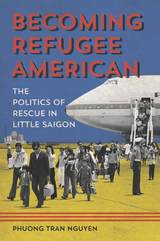 Becoming Refugee American: The Politics of Rescue in Little Saigon
Phuong Nguyen
University of Illinois Press, 2017 Vietnamese refugees fleeing the fall of South Vietnam faced a paradox. The same guilt-ridden America that only reluctantly accepted them expected, and rewarded, expressions of gratitude for their rescue. Meanwhile, their status as refugees—as opposed to willing immigrants—profoundly influenced their cultural identity. Phuong Tran Nguyen examines the phenomenon of refugee nationalism among Vietnamese Americans in Southern California. Here, the residents of Little Saigon keep alive nostalgia for the old regime and, by extension, their claim to a lost statehood. Their refugee nationalism is less a refusal to assimilate than a mode of becoming, in essence, a distinct group of refugee Americans. Nguyen examines the factors that encouraged them to adopt this identity. His analysis also moves beyond the familiar rescue narrative to chart the intimate yet contentious relationship these Vietnamese Americans have with their adopted homeland. Nguyen sets their plight within the context of the Cold War, an era when Americans sought to atone for broken promises but also saw themselves as providing a sanctuary for people everywhere fleeing communism.
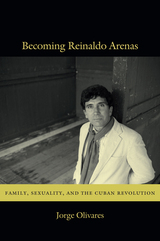 Becoming Reinaldo Arenas: Family, Sexuality, and The Cuban Revolution
Jorge Olivares
Duke University Press, 2013 Becoming Reinaldo Arenas explores the life and work of the Cuban writer Reinaldo Arenas (1943–1990), who emerged on the Latin American cultural scene in the 1960s and quickly achieved literary fame. Yet as a political dissident and an openly gay man, Arenas also experienced discrimination and persecution; he produced much of his work amid political controversy and precarious living conditions. In 1980, having survived ostracism and incarceration in Cuba, he arrived in the United States during the Mariel boatlift. Ten years later, after struggling with poverty and AIDS in New York, Arenas committed suicide. Through insightful close readings of a selection of Arenas's works, including unpublished manuscripts and correspondence, Olivares examines the writer's personal, political, and artistic trajectory, focusing on his portrayals of family, sexuality, exile, and nostalgia. He documents Arenas's critical engagement with cultural and political developments in revolutionary Cuba and investigates the ways in which Arenas challenged literary and national norms. Olivares's analysis shows how Arenas drew on his life experiences to offer revealing perspectives on the Cuban Revolution, the struggles of Cuban exiles, and the politics of sexuality.
Becoming Rwandan: Education, Reconciliation, and the Making of a Post-Genocide Citizen
S. Garnett Russell
Rutgers University Press, 2020 In the aftermath of the genocide, the Rwandan government has attempted to use the education system in order to sustain peace and shape a new generation of Rwandans. Their hope is to create a generation focused on a unified and patriotic future rather than the ethnically divisive past. Yet, the government’s efforts to manipulate global models around citizenship, human rights, and reconciliation to serve its national goals have had mixed results, with new tensions emerging across social groups. Becoming Rwandan argues that although the Rwandan government utilizes global discourses in national policy documents, the way in which teachers and students engage with these global models distorts the intention of the government, resulting in unintended consequences and undermining a sustainable peace.
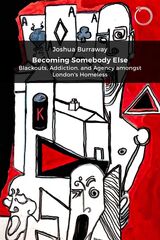 Becoming Somebody Else: Blackouts, Addiction, and Agency amongst London's Homeless
Joshua Burraway
HAU, 2025 A study of homelessness and addiction exploring the void of drug-induced blackout and its impact on identity and time.
What does it mean to exist outside the normative temporality of life, of housed living, and, ultimately, of selfhood? Becoming Somebody Else takes up this question, offering a window into the fragmented and chaotic lives of people experiencing homelessness in urban London as they drink and drug themselves into blackout in post-austerity Britain. A state of being where time, body, agency, and self collapse into a memoryless abyss, the blackout is a prism into how human beings make and unmake their selfhood in the wake of social suffering and personal trauma. Attending to the words and histories of several individuals, Joshua Burraway knits together structural, psychological, and phenomenological approaches to understand the ways in which memory, agency, and selfhood are sites of struggle and belonging, and in doing so, suggests new ways of thinking about addiction, homelessness, and therapeutic possibility.
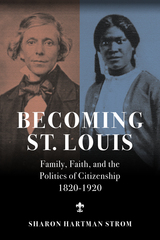 Becoming St. Louis: Family, Faith, and the Politics of Citizenship, 1820-1920
Sharon Hartman Strom
University of Illinois Press, 2025 St. Louis was the pivot of the free states and slave states and the border of the settled East and frontier West. Sharon Hartman Strom draws on disparate and previously untapped sources to weave the personal and public lives of women and both free and enslaved African Americans into city history. Strom’s analysis shows how the embrace of Protestantism by people of color sparked a vigorous antislavery movement. During the Civil War, several prominent citizens served in the Lincoln cabinet and Congress while Missouri’s decision to remain in the Union allowed the city to find its own ways to end slavery and grant citizenship to African Americans. Years later, biracial movements to advance equality collapsed when the East St. Louis race riot of 1917 affirmed that racist attitudes and structures still dominated the region. Illuminating and nuanced, Becoming St. Louis offers a diverse social and political history of the city during a transformative era.
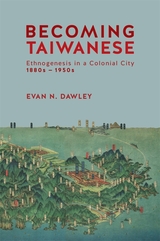 Becoming Taiwanese: Ethnogenesis in a Colonial City, 1880s to 1950s
Evan N. Dawley
Harvard University Press, 2019 What does it mean to be Taiwanese? This question sits at the heart of Taiwan’s modern history and its place in the world. In contrast to the prevailing scholarly focus on Taiwan after 1987, Becoming Taiwanese examines the important first era in the history of Taiwanese identity construction during the early twentieth century, in the place that served as the crucible for the formation of new identities: the northern port city of Jilong (Keelung).
Part colonial urban social history, part exploration of the relationship between modern ethnicity and nationalism, Becoming Taiwanese offers new insights into ethnic identity formation. Evan Dawley examines how people from China’s southeastern coast became rooted in Taiwan; how the transfer to Japanese colonial rule established new contexts and relationships that promoted the formation of distinct urban, ethnic, and national identities; and how the so-called retrocession to China replicated earlier patterns and reinforced those same identities. Based on original research in Taiwan and Japan, and focused on the settings and practices of social organizations, religion, and social welfare, as well as the local elites who served as community gatekeepers, Becoming Taiwanese fundamentally challenges our understanding of what it means to be Taiwanese.
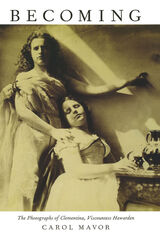 Becoming: The Photographs of Clementina, Viscountess Hawarden
Carol Mavor
Duke University Press, 1999 Clementina, Viscountess Hawarden (1822–1865) produced over eight hundred photographs during her all-too-brief life. Most of these were portraits of her adolescent daughters. By whisking away the furniture and bric-a-brac common in scenes of upper-class homes of the Victorian period, Lady Hawarden transformed the sitting room of her London residence into a photographic studio—a private space for taking surprising photos of her daughters in fancy dress. In Carol Mavor’s hands, these pictures become windows into Victorian culture, eroticism, mother-daughter relationships, and intimacy. With drama, wit, and verve, Lady Hawarden’s girls, becoming women, entwine each other, their mirrored reflections and select feminine objects (an Indian traveling cabinet, a Gothic-style desk, a shell-covered box) as homoerotic partners. The resulting mise-en-scène is secretive, private, delicious, and arguably queer—a girltopia ripe with maternality and adolescent flirtation, as touching as it is erotic. Luxuriating in the photographs’ interpretive possibilities, Mavor makes illuminating connections between Hawarden and other artists and writers, including Vermeer, Christina Rossetti, George Eliot, Lewis Carroll, and twentieth-century photographers Sally Mann and Francesca Woodman. Weaving psychoanalytic theory and other photographic analyses into her work, Mavor contemplates the experience of the photograph and considers the relationship of Hawarden’s works to the concept of the female fetish, to voyeurism, mirrors and lenses, and twins and doubling. Under the spell of Roland Barthes, Mavor’s voice unveils the peculiarities of the erotic in Lady Hawarden’s images through a writerly approach that remembers and rewrites adolescence as sustained desire. In turn autobiographical, theoretical, historical, and analytical, Mavor’s study caresses these mysteriously ripped and scissored images into fables of sapphic love and the real magic of photography.
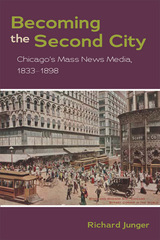 Becoming the Second City: Chicago's Mass News Media, 1833-1898
Richard Junger
University of Illinois Press, 2010 Becoming the Second City examines the development of Chicago's press and analyzes coverage of key events in its history to call attention to the media's impact in shaping the city's cultural and historical landscape. In concise, extensively documented prose, Richard Junger illustrates how nineteenth century newspapers acted as accelerants that boosted Chicago's growth in its early history by continually making and remaking the city's image for the public. Junger argues that the press was directly involved in Chicago's race to become the nation's most populous city, a feat it briefly accomplished during the mid-1890s before the incorporation of Greater New York City irrevocably recast Chicago as the "Second City." The book is populated with a colorful cast of influential figures in the history of Chicago and in the development of journalism. Junger draws on newspapers, personal papers, and other primary sources to piece together a lively portrait of the evolving character of Chicago in the nineteenth century. Highlighting the newspaper industry's involvement in the business and social life of Chicago, Junger casts newspaper editors and reporters as critical intermediaries between the elite and the larger public and revisits key events and issues including the Haymarket Square bombing, the 1871 fire, the Pullman Strike, and the World's Columbian Exposition in 1893.
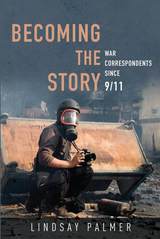 Becoming the Story: War Correspondents since 9/11
Lindsay Palmer
University of Illinois Press, 2018 The September 11 attacks produced great changes in journalism and the lives of the people who practiced it. Foreign reporters felt surrounded by the hate of American colleagues for "the enemy." Americans in combat areas became literal targets of anti–U.S. sentiment. Behind the lines, editors and bureau chiefs scrambled to reorient priorities while feeling the pressure of sending others into danger. Becoming the Story examines the transformation of war reporting in the decade after 9/11. Lindsay Palmer delves into times when print or television correspondents themselves received intense public scrutiny because of an incident associated with the work of war reporting. Such instances include Daniel Pearl’s kidnapping and murder; Bob Woodruff’s near-fatal injury in Iraq; the expulsions of Maziar Bahari and Nazila Fathi from Iran in 2009; the sexual assault of Lara Logan; and Marie Colvin’s 2012 death in Syria. Merging analysis with in-depth interviews of Woodruff and others, Palmer shows what these events say about how post-9/11 conflicts transformed the day-to-day labor of reporting. But they also illuminate how journalists’ work became entangled with issues ranging from digitization processes to unprecedented hostility from all sides to the political logic of the War on Terror.
 Becoming the Tupamaros: Solidarity and Transnational Revolutionaries in Uruguay and the United States
Lindsey Churchill
Vanderbilt University Press, 2013 In Becoming the Tupamaros, Lindsey Churchill explores an alternative narrative of US-Latin American relations by challenging long-held assumptions about the nature of revolutionary movements like the Uruguayan Tupamaros group. A violent and innovative organization, the Tupamaros demonstrated that Latin American guerrilla groups during the Cold War did more than take sides in a battle of Soviet and US ideologies. Rather, they digested information and techniques without discrimination, creating a homegrown and unique form of revolution.
Churchill examines the relationship between state repression and revolutionary resistance, the transnational connections between the Uruguayan Tupamaro revolutionaries and leftist groups in the US, and issues of gender and sexuality within these movements. Angela Davis and Eldridge Cleaver, for example, became symbols of resistance in both the United States and Uruguay. and while much of the Uruguayan left and many other revolutionary groups in Latin America focused on motherhood as inspiring women's politics, the Tupamaros disdained traditional constructions of femininity for female combatants. Ultimately, Becoming the Tupamaros revises our understanding of what makes a Movement truly revolutionary.
 Becoming the Voinovich School: A History of Ohio University’s Voinovich School of Leadership and Public Service
R. Gregory Browning, Ph.D.
Ohio University Press The evolution of a university-based public service model that integrates leadership, applied research, and regional engagement in Appalachian Ohio Becoming the Voinovich School chronicles the evolution of Ohio University’s Voinovich School of Leadership and Public Service, a pioneering institution that blends academic rigor with hands-on public engagement. Founded on the vision of political scientist Mark Weinberg and inspired by the leadership philosophy of former US senator and Ohio governor George V. Voinovich, the school has become a national model for university-based public service. From its modest beginnings in 1976—when Weinberg was hired to build a public administration program from scratch—the school has grown into a dynamic “do tank” serving the Appalachian Ohio region and beyond. Early initiatives like the Institute for Local Government Administration and Rural Development laid the groundwork for a new kind of academic center: one that connects faculty expertise with real-world problem-solving. Through applied research, GIS analysis, leadership training, and program evaluation, the school has become a trusted convener and catalyst for change. The Voinovich School’s mission spans five key sectors: economic development, community development, education and child wellness, environmental restoration, and health and well-being. Its work is rooted in a commitment to empowering communities, especially those facing the economic and health challenges of postindustrial Appalachia. By pairing grant-funded projects with experiential education, the school has created opportunities for students to engage directly with pressing public issues while building leadership capacity across the region. In 2007, the center was formally renamed the Voinovich School, reflecting its expanded scope and growing impact. Over the next decade, it launched new graduate programs, raised its national ranking, and became the educational partner for the Ohio Economic Development Institute. Today, the school continues to leverage state and federal funding, private-sector partnerships, and alumni networks to address complex challenges with innovative, community-driven solutions. This book offers a compelling account of how one university unit transformed public service education—and how its legacy continues to shape leadership and policy in and beyond Ohio.
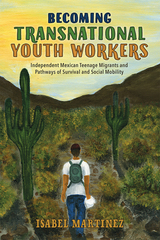 Becoming Transnational Youth Workers: Independent Mexican Teenage Migrants and Pathways of Survival and Social Mobility
Isabel Martinez
Rutgers University Press, 2018 Becoming Transnational Youth Workers contests mainstream notions of adolescence with its study of a previously under-documented cross-section of Mexican immigrant youth. Preceding the latest wave of Central American children and teenagers now fleeing violence in their homelands, Isabel Martinez examines a group of unaccompanied Mexican teenage minors who emigrated to New York City in the early 2000s. As one of the consequences of intractable poverty in their homeland, these emigrant youth exhibit levels of agency and competence not usually assigned to children and teenage minors, and disrupt mainstream notions of what practices are appropriate at their ages. Leaving school and family in Mexico and financially supporting not only themselves through their work in New York City, but also their families back home, these youths are independent teenage migrants who, upon migration, wish to assume or resume autonomy and agency rather than dependence. This book also explores community and family understandings about survival and social mobility in an era of extreme global economic inequality.
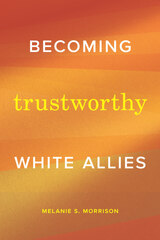 Becoming Trustworthy White Allies
Melanie S. Morrison
Duke University Press, 2025 In Becoming Trustworthy White Allies, longtime antiracist facilitator Melanie S. Morrison outlines the actions white people must undertake to become partners in the work of racial justice. In this collection of essays, lectures, and real-life stories, Morrison addresses how white people can navigate the obstacles to becoming an ally so that they can step up with courage, humility, and consistency to participate in BIPOC-led organizations while helping move other white people to greater antiracist awareness and action. Morrison describes the required steps toward allyship: moving through shame and guilt, nurturing truth-telling relationships of support and accountability, challenging practices and policies that protect white privilege, moving out of social segregation, working from a place of self-love, and staying on the antiracist journey. Now, as always, it is imperative that white people commit to doing the deep work and learning required to become lifelong trustworthy allies.
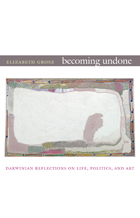 Becoming Undone: Darwinian Reflections on Life, Politics, and Art
Elizabeth Grosz
Duke University Press, 2011 In Becoming Undone, Elizabeth Grosz addresses three related concepts—life, politics, and art—by exploring the implications of Charles Darwin’s account of the evolution of species. Challenging characterizations of Darwin’s work as a form of genetic determinism, Grosz shows that his writing reveals an insistence on the difference between natural selection and sexual selection, the principles that regulate survival and attractiveness, respectively. Sexual selection complicates natural selection by introducing aesthetic factors and the expression of individual will, desire, or pleasure. Grosz explores how Darwin’s theory of sexual selection transforms philosophy, our understanding of humanity in its male and female forms, our ideas of political relations, and our concepts of art. Connecting the naturalist’s work to the writings of Bergson, Deleuze, and Irigaray, she outlines a postmodern Darwinism that understands all of life as forms of competing and coordinating modes of openness. Although feminists have been suspicious of the concepts of nature and biology central to Darwin’s work, Grosz proposes that his writings are a rich resource for developing a more politicized, radical, and far-reaching feminist understanding of matter, nature, biology, time, and becoming.
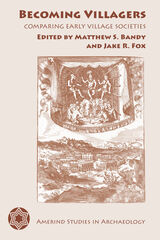 Becoming Villagers: Comparing Early Village Societies
Edited by Matthew S. Bandy and Jake R. Fox
University of Arizona Press, 2010 The shift from mobile hunting and gathering to more sedentary, usually agricultural, lifeways was one of the most significant milestones in the prehistory of humanity. This transformation was spurred by an alignment of social and ecological forces, pressures, and adaptations, and it took place in broadly comparable ways in many prehistoric settings. Based on a Society for American Archaeology symposium and subsequent Amerind Advanced Seminar in 2006, Becoming Villagers examines this transformation at various places and times across the globe by focusing not on the origins of agriculture and village life but rather on their consequences. The goal of the volume is to identify regularities in the ways that societies developed in the centuries and millennia following a transition to village life. Using cases that range from China to Bolivia and from the Near East to the American Southwest, leading archaeologists situate their specific areas of specialization in a broad comparative context. They consider the forces acting to divide and fragment early villages and the social technologies and practices by which those obstacles were, in some cases, overcome. Finally, the volume examines the long-term historical trajectories of these early village societies. This transformative collection makes a powerful case for a renewed and invigorated archaeological focus on large-scale comparative studies. It will be an essential read for anyone interested not only in early village societies but also in the ways in which archaeology relates to anthropology, other social sciences, and history. CONTENTS: - “Becoming Villagers: The Evolution of Early Village Societies,” Matthew S. Bandy and Jake R. Fox
- “Population Growth, Village Fissioning, and Alternative Early Village Trajectories,” Matthew S. Bandy
- “A Scale Model of Seven Hundred Years of Farming Settlements in Southwestern Colorado,” Timothy A. Kohler and Mark D. Varien
- “‘Great Expectations,’ or the Inevitable Collapse of the Early Neolithic in the Near East,” Nigel Goring-Morris and Anna Belfer-Cohen
- “‘Ritualization’ in Early Village Society: The Case of the Lake Titicaca Basin Formative,” Amanda B. Cohen
- “The Sacred and the Secular Revisited: The Essential Tensions of Early Village Society in the Southeastern United States,” Thomas Pluckhahn
- “Substantial Structures, Few People, and the Question of Early Villages in the Mimbres Region of the North American Southwest,” Patricia A. Gilman
- “Sea Changes in Stable Communities: What Do Small Changes in Practices at Catalhoyuk and Chiripa Imply about Community Making?” Christine A. Hastorf
- “The Emergence of Early Villages in the American Southwest: Cultural Issues and Historical Perspectives,” Richard H. Wilshusen and James M. Potter
- “A Persistent Early Village Settlement System on the Bolivian Southern Altiplano,” Jake R. Fox
- “First Towns in the Americas: Searching for Agriculture, Population Growth, and Other Enabling Conditions,” John E. Clark, Jon L. Gibson, and James Zeidler
- “The Evolution of Early Yangshao Period Village Organization in the Middle Reaches of Northern China's Yellow River Valley,” Christian E. Peterson and Gideon Shelach
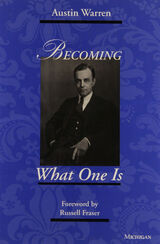 Becoming What One Is
Austin Warren
University of Michigan Press, 1995 The late Austin Warren was one of the most distinguished literary scholars of the twentieth century, well known as a biographer, literary critic, and teacher. He retired from the University of Michigan English Department in 1968 after twenty years on the faculty. Warren's memoir ends at age forty, because, as he explains in the preface, the most interesting part of anyone's life is the formative years. He begins with his childhood in Massachusetts and education at Wesleyan, Harvard, and Princeton, and ends with reflections on the problems of integrating his profession, teaching, with his vocation, writing. The journey in between is extraordinary, a re-creation of the scholar's search for identity, religion, wisdom, and a new vision of the role of a teacher. Warren "forged his soul when others weren't looking," writes Russell Fraser in his foreword to the book. He grew up on a lonely New England farm, went to a school where he learned to hate even Shakespeare, and entered college without enthusiasm. But the history of his education, as is often the case, was one first of rescue by inspiring mentors, then of outgrowing those mentors, and finally of forging a vision of his own. By the 1930s he had shaken up classrooms by abandoning formal lectures and become an inspiration in his own right. A singular personality who never stopped searching for meaningful spirituality and a wider intellectual world, Austin Warren was among the most important scholars of the twentieth century. His memoirs of "becoming" are an elegant and absorbing chronicle.
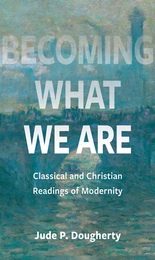 Becoming What We Are: Classical and Christian Readings of Modernity
Jude P. Dougherty
Catholic University of America Press, 2023 Becoming What We Are is a collection of essays and reviews written in the last decade by the late Jude Dougherty, which covey a perspective on contemporary events and literature, written from a classical and Christian perspective. These essays convey a worldview much in need of restating when, according to Dougherty, Western society seems to have lost its bearings, in its legislative assemblies and in its judicial systems as well. Dougherty writes as a philosopher, specifically as one who has devoted most of his life to the study of metaphysics.
In these pages Dougherty examines the Jacobians, the empirical world of Hume, Locke and Hobbes, and Kant, the metaphysics of Plato, Aristotle, the Stoics and Aquinas that opens one to God and provides on with a moral compass, and critiques the work of Karl Marx, Sigmund Freud and John Dewey.
Becoming What We Are spends some time inquiring into the character of a few great men viz. George Washington, Charles De Gaulle and Moses Maimonides. Dougherty draws upon and shows respect for numerous contemporary authors who are engaged in research and analysis similar to his. The intent is, with the aid of others to restate some ancient but neglected truths. But more than that to show that true science is possible, that nature and human nature yield to human enquiry, that science is not to be confused with description and prediction.
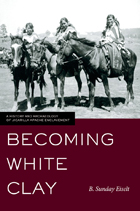 Becoming White Clay: A History and Archaeology of Jicarilla Apache Enclavement
B. Sunday Eiselt
University of Utah Press, 2012 The story of one of the longest-lived and most successful nomadic enclaves in North America provides a rare glimpse into the material expressions of Apache self-determination and survival. For nearly 200 years the Jicarilla Apache of New Mexico thrived in the interstices of Pueblo and Spanish settlements following their expulsion from the Plains. Critical to their success was their ability to extend key aspects of Plains-Pueblo exchange to Indian and mixed-blood communities on the fringes of colonial rule. More than other nomadic tribes, the Jicarilla played an enormous role in holding together the social fabric of New Mexican villages after the fall of the Spanish Empire.
This comprehensive study by Sunday Eiselt begins with the great Athapaskan migration out of Canada during prehis-toric times and ends with the forced settlement of the Jicarilla on the Dulce reservation in the 1880s. Eiselt combines archaeological and ethnohistorical data in an examination of Jicarilla strategies for self-preservation. She reveals the ideological and political imperatives of “belonging” that shaped their interactions with local communities and the state and that enabled them to avoid reservation life well into the 1880s. Throughout their long history, Jicarilla identity remained intact, distinctive, and discernable even as life on the reservation disrupted the intimate connections that once existed with their Hispanic and Pueblo neighbors.
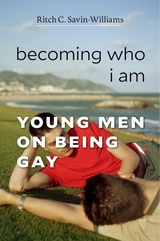 Becoming Who I Am: Young Men on Being Gay
Ritch C. Savin-Williams
Harvard University Press, 2016 Proud, happy, grateful—gay youth describe their lives in terms that would have seemed surprising only a generation ago. Yet many adults, including parents, seem skeptical about this sea change in perceptions and attitudes. Even in an age of growing tolerance, coming out as gay is supposed to involve a crisis or struggle. This is the kind of thinking, say the young men at the heart of this book, that needs to change.
Becoming Who I Am is an astute exploration of identity and sexuality as told by today’s generation of gay young men. Through a series of in-depth interviews with teenagers and men in their early 20s, Ritch Savin-Williams reflects on how the life stories recorded here fulfill the promise of an affirmative, thriving gay identity outlined in his earlier book, The New Gay Teenager. He offers a contemporary perspective on gay lives viewed across key milestones: from dawning awareness of same-sex attraction to first sexual encounters; from the uncertainty and exhilaration of coming out to family and friends to the forming of adult romantic relationships; from insights into what it means to be gay today to musings on what the future may hold. The voices hail from diverse ethnic and socioeconomic backgrounds, but as gay men they share basic experiences in common, conveyed here with honesty, humor, and joy.
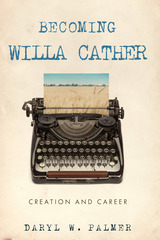 Becoming Willa Cather: Creation and Career
Daryl W. Palmer
University of Nevada Press, 2019 From the girl in Red Cloud who oversaw the construction of a miniature town called Sandy Point in her backyard, to the New Woman on a bicycle, celebrating art and castigating political abuse in Lincoln newspapers, to the aspiring novelist in New York City, committed to creation and career, Daryl W. Palmer’s groundbreaking literary biography offers a provocative new look at Willa Cather’s evolution as a writer.
Willa Cather has long been admired for O Pioneers! (1913), Song of the Lark (1915), and My Ántonia (1918)—the “prairie novels” about the lives of early Nebraska pioneers that launched her career. Thanks in part to these masterpieces, she is often viewed as a representative of pioneer life on the Great Plains, a controversial innovator in American modernism, and a compelling figure in the literary history of LGBTQ America. A century later, scholars acknowledge Cather’s place in the canon of American literature and continue to explore her relationship with the West.
Drawing on original archival research and paying unprecedented attention to Cather’s early short stories, Palmer demonstrates that the relationship with Nebraska in the years leading up to O Pioneers! is more dynamic than critics and scholars thought. Readers will encounter a surprisingly bold young author whose youth in Nebraska served as a kind of laboratory for her future writing career. Becoming Willa Cather changes the way we think about Cather, a brilliant and ambitious author who embraced experimentation in life and art, intent on reimagining the American West.
Bed
Elizabeth Metzger
Tupelo Press, 2021 The poems in Bed, many written during prolonged bed rest, examine how life’s interruptions—illness or new motherhood, loss or lust—can lead us to intimate revelations with others and with our selves. We spend much of our lives in bed—it is a border, a boundary, a haven, and a trap—and the poems in Bed confront and question the very limits of body and mind. In dream and waking, in sickness and sex, in marriage and birth, in grief and death, the bed is a space that can either mark time or transcend it, a place of perpetual becoming and reinvention. Here is a body trying to remember pleasure amidst the material of suffering, a language trying to keep up with a love that begins before speech. The bed in Bed is often an absent center—a missing mind—around which intimacy must dance. Maybe it is the wanted child. Maybe it is the mourned self. Maybe it is your mind these poems must be tucked into to be kept or come alive.
 A Bed Called Home: Life In The Migrant Labour Hostels of Cape Town
Mamphela Ramphele
Ohio University Press, 1993 In the last three years the migrant labor hostels of South Africa, particularly those in the Transvaal, have gained international notoriety as theaters of violence. For many years they were hidden from public view and neglected by the white authorities. Now, it seems, hostel dwellers may have chosen physical violence to draw attention to the structural violence of their appalling conditions of life. Yet we should not lose sight of the fact that the majority of hostel dwellers are peace-loving people who have over the years developed creative strategies to cope with their impoverished and degrading environment.
In this challenging study, Dr. Mamphela Ramphele documents the life of the hostel dwellers of Cape Town, for whom a bed is literally a home for both themselves and their families. Elaborating the concept of space in its many dimensions—not just physical, but political, ideological, social, and economic as well—she emphasizes the constraints exerted on hostel dwellers by the limited spaces they inhabit. At the same time, she argues that within these constraints people have managed to find room for manoeuvre, and in her book explores the emancipatory possibilities of their environment.
The text is illustrated with a number of black-and-white photographs taken by Roger Meintjes in the townships and hostels.
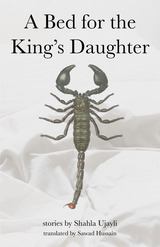 A Bed for the King's Daughter
Stories by Shahla Ujayli; translated by Sawad Hussain
University of Texas Press, 2020 A groundbreaking collection of experimental short fiction by award-winning Syrian author and Booker International Prize for Arabic Fiction nominee Shahla Ujayli, A Bed for the King’s Daughter uses surrealism and irony to examine such themes as women’s agency, the decline of collective life and imagination under modernity, and the effects of social and political corruption on daily life. In “The Memoir of Cinderella’s Shoes,” Cinderella uses her famous glass slipper as a weapon in order to take justice into her own hands. In “Tell Me About Surrealism,” an art history professor’s writing assignment reveals the slipperiness of storytelling, and in “Merry Christmas,” the realities of apartheid interfere with one family’s celebration. Through twenty-two short stories, Ujayli animates—with brevity and inventiveness—themes relevant to both the particularities of life in the Arab world and life outside it.
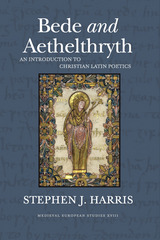 Bede and Aethelthryth: An Introduction to Christian Latin Poetics
Stephen J. Harris
West Virginia University Press, 2016 Bede and Aethelthryth asks why Christians in Britain around the year 700 enjoyed Latin poetry. What did they see in it? What did they get from it? This book attempts to reconstruct the horizon of expectation of a highly learned, Latin-speaking nun as she encounters a fifty-line poem by the Venerable Bede, the Hymn to Aethelthryth. The reconstruction is hypothetical and derived from grammatical manuals, learned commentaries from the early medieval period (especially Servius’s commentary on Virgil), and a wide variety of aesthetic observations by classical and medieval readers. The first four chapters describe basic expectations of a reader of Christian Latin poetry. The fifth chapter places the Hymn in its context within Bede’s Ecclesiastical History. A few pages after Bede records his hymn, Caedmon will recite his own hymn under the watchful eye of Whitby’s Abbess Hild, who was a friend of Aethelthryth. Both hymns are attempts to reform the lyric traditions of pagan Rome and pagan Anglo-Saxon England in the light of Christian teaching. The last three chapters contain a line-by-line commentary on Bede’s alphabetic, epanaleptic elegy.
Bede: Part 1
Edited by George Hardin Brown and Frederick Biggs
Amsterdam University Press, 2017 Bede is the inaugural volume in the Sources of Anglo-Saxon Literary Culture series, which seeks to comprehensively map British literary culture from 500 to 1100 CE. This volume presents four texts, or fascicles, dedicated to the Venerable Bede (d. 735), theologian and author of the Historia ecclesiastica gentis Anglorum. Articles provide a wealth of information on Bede through manuscript evidence, medieval library catalogs, citations, and quotations. Using discussions of source relationships, the entries weigh and consider different interpretations of Bede’s works and suggest possibilities for future research. Part of an exciting new reference series, this book“and those that follow“will be indispensable to anyone interested in the history and literature of the period.
Bede: Part 2
Edited by George Hardin Brown and Frederick M. Biggs
Amsterdam University Press, 2018 This newest volume in a long-running work of mapping the sources of Anglo-Saxon literary culture in England from 500 to 1100 CE takes up one of the most important authors of the period, the eighth-century monk-scholar known as the Venerable Bede. Bede is best known as the author of the Historia ecclesiastica gentis Anglorum, which is one of the key sources for our historical and cultural knowledge of the period; this collection covers that and more, drawing on manuscript evidence, medieval library catalogues, Anglo-Latin and Old English versions, citations, quotations, and more, putting Bede and his work in the context of his period.
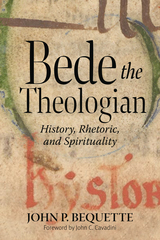 Bede the Theologian: History, Rhetoric, and Spirituality
John P. Bequette
Catholic University of America Press, 2022 Revered by contemporaries and posterity for both his sanctity and his scholarship, Bede (672-735) is a pivotal figure in the history of the Church. Known primarily as an historian for his Ecclesiastical History of the English People, Bede was also an accomplished pedagogue, hagiographer, and biblical scholar. Bede the Theologian: History, Rhetoric, and Spirituality takes a fresh look at this classic Christian thinker, exploring the gamut of Bede’s literary corpus. The book investigates key themes, including Bede’s understanding of the theological significance of time, his conception of the relationship between the temporal and eternal orders within history, his theological use of rhetoric, his foray into narrative theology, and his spirituality.
The purpose of this volume is to introduce the reader to principal theological themes in Bede’s thought. Bequette’s thesis is that Bede was a theologian writing in continuity with the Christian tradition and yet making creative, original contributions to that tradition for the sake of his contemporaries, both in the monastery and in the culture at large. The method involves a close reading and analysis of key texts within Bede’s corpus of writings. These texts include the Ecclesiastical History of the English People, the Life of St Cuthbert, and several of Bede’s biblical commentaries (On the Tabernacle, On the Temple) his homilies, and didactic treatises (On the Reckoning of Time, Concerning Figures and Tropes in Sacred Scripture). Bede the Theologian: History, Rhetoric, and Spirituality constitutes a scholarly study of Bede’s thought as an integral whole, identifying key themes and ideas that pervade his writings. Thus, it can serve as an introduction to Bede’s thought for non-specialists in the areas of theology, religious studies, and other areas of the humanities.
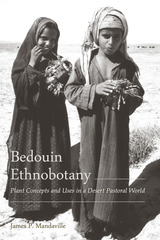 Bedouin Ethnobotany: Plant Concepts and Uses in a Desert Pastoral World
James P. Mandaville
University of Arizona Press, 2011 A Bedouin asking a fellow tribesman about grazing conditions in other parts of the country says first simply, “Fih hayah?” or “Is there life?” A desert Arab’s knowledge of the sparse vegetation is tied directly to his life and livelihood.
Bedouin Ethnobotany offers the first detailed study of plant uses among the Najdi Arabic–speaking tribal peoples of eastern Saudi Arabia. It also makes a major contribution to the larger project of ethnobotany by describing aspects of a nomadic peoples’ conceptual relationships with the plants of their homeland.
The modern theoretical basis for studies of the folk classification and nomenclature of plants was developed from accounts of peoples who were small-scale agriculturists and, to a lesser extent, hunter-gatherers. This book fills a major gap by extending such study into the world of the nomadic pastoralist and exploring the extent to which these patterns are valid for another major subsistence type. James P. Mandaville, an Arabic speaker who lived in Saudi Arabia for many years, focuses first on the role of plants in Bedouin life, explaining their uses for livestock forage, firewood, medicinals, food, and dyestuffs, and examining other practical purposes. He then explicates the conceptual and linguistic aspects of his subject, applying the theory developed by Brent Berlin and others to a previously unstudied population. Mandaville also looks at the long history of Bedouin plant nomenclature, finding that very little has changed among the names and classifications in nearly eleven centuries.
This volume includes a CD-ROM featuring more than 340 color images of the people, the terrain, and nearly all of the plants mentioned in the text as well as an audio file of a traditional Bedouin song and its translation and analysis.
An essential volume for anyone interested in the interaction between human culture and plant life, Bedouin Ethnobotany will stand as a definitive source for years to come.
Bedouin Life in the Egyptian Wilderness
By Joseph J. Hobbs
University of Texas Press, 1992 Between the Nile River and the Red Sea, in the northern half of Egypt's Eastern Desert, live the Bedouins of the Ma'aza tribe. Joseph Hobbs lived with the Khushmaan Ma'aza clan for almost two years, gathering information for a study of traditional Bedouin life and culture. The resulting work, Bedouin Life in the Egyptian Wilderness, is the first modern ethnographic portrait of the Ma'aza Bedouins.
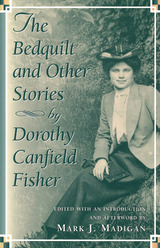 The Bedquilt and Other Stories: By Dorothy Canfield Fisher
Edited, Intro, & Afterword by Mark J. Madigan
University of Missouri Press, 1997 Dorothy Canfield Fisher, the prolific author of more than forty books, including translations, juveniles, and nonfiction, as well as novels and short-story collections, was one of the most popular and engaging American writers of the first half of the twentieth century. Although her work has been unduly neglected for several decades, it is currently enjoying a revival of critical attention. This colorful collection ranges in subject from New Englanders to the Basques of France to the struggles of African Americans to gain equal rights. Through her stories, many of which received literary awards, Fisher examined the complexities of modern life in the United States and abroad. In addition to her writing, Fisher had a lifelong involvement in charitable work and social causes--so much so that Eleanor Roosevelt called her one of the most influential women of her time. As one of the earliest and most assertive members of the Book-of-the-Month Club selection committee, Fisher helped define literary taste in America for more than two decades. Mark J. Madigan discusses Fisher's extraordinary life and work in an Introduction and Afterword. Because of Fisher's rare ability to distinguish enduring concerns from merely topical issues, her work will provide lasting pleasure for generations of readers to come.
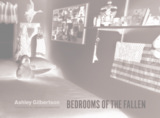 Bedrooms of the Fallen
Ashley Gilbertson
University of Chicago Press, 2014 For more than a decade, the United States has been fighting wars so far from the public eye as to risk being forgotten, the struggles and sacrifices of its volunteer soldiers almost ignored. Photographer and writer Ashley Gilbertson has been working to prevent that. His dramatic photographs of the Iraq war for the New York Times and his book Whiskey Tango Foxtrot took readers into the mayhem of Baghdad, Ramadi, Samarra, and Fallujah. But with Bedrooms of the Fallen, Gilbertson reminds us that the wars in Afghanistan and Iraq have also reached deep into homes far from the noise of battle, down quiet streets and country roads—the homes of family and friends who bear their grief out of view.
The book’s wide-format black-and-white images depict the bedrooms of forty fallen soldiers—the equivalent of a single platoon—from the United States, Canada, and several European nations. Left intact by families of the deceased, the bedrooms are a heartbreaking reminder of lives cut short: we see high school diplomas and pictures from prom, sports medals and souvenirs, and markers of the idealism that carried them to war, like images of the Twin Towers and Osama Bin Laden. A moving essay by Gilbertson describes his encounters with the families who preserve these private memorials to their loved ones, and shares what he has learned from them about war and loss.
Bedrooms of the Fallen is a masterpiece of documentary photography, and an unforgettable reckoning with the human cost of war.
The Beds
Martha Rhodes
Autumn House Press, 2012 In The Beds, award-winning poet Martha Rhodes skillfully navigates a tonally complex terrain. Rhodes’ fourth collection mixes form and free-verse, specifically using the rondelet’s tight, obsessive repetition as a means to harness and modulate frenetic content.
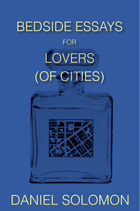 Bedside Essays for Lovers (of Cities)
Daniel Solomon
Island Press, 2012 In this provocative collection of essays, renowned architect Daniel Solomon delves into the complexities of what makes a city vibrant. Acknowledging that a city is not a static thing, he argues we need to pay more attention to nurturing what he calls “continuous cities.” In such a city, he says, “new buildings, new institutions, and new technologies don’t rip apart the old and wreck it. They accommodate, they act with respect, and they add vibrant new chapters to history without eradicating it.” Continuity, he explains, is the way to promote sustainability— and contrary to what the advocates of “modern architecture” claim, he insists that honoring the traditional ways of city building still provides a solid foundation for places to grow, evolve, be modern.
However fond you are of your city, or however much you feel it needs improvement, this short collection of essays offers an enticing vision of the future. All of our cities have a past worth examining, a richness of experience that can shape the future in wonderful, surprising ways. Solomon’s prose is thought-provoking and inspiring, well worth keeping close by wherever you do your reading—be it your bedside, couch, a park, or on the metro.
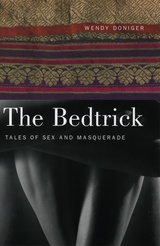 The Bedtrick: Tales of Sex and Masquerade
Wendy Doniger
University of Chicago Press, 2000 "Somehow I woke up one day and found myself in bed with a stranger." Meant literally or figuratively, this statement describes one of the best-known plots in world mythology and popular storytelling. In a tour that runs from Shakespeare to Hollywood and from Abraham Lincoln to Casanova, the erudite and irrepressible Wendy Doniger shows us the variety, danger, and allure of the "bedtrick," or what it means to wake up with a stranger.
The Bedtrick brings together hundreds of stories from all over the world, from the earliest recorded Hindu and Hebrew texts to the latest item in the Weekly World News, to show the hilariously convoluted sexual scrapes that people manage to get themselves into and out of. Here you will find wives who accidentally commit adultery with their own husbands. You will read Lincoln's truly terrible poem about a bedtrick. You will learn that in Hong Kong the film The Crying Game was retitled Oh No! My Girlfriend Has a Penis. And that President Clinton was not the first man to be identified by an idiosyncratic organ.
At the bottom of these wonderful stories, ancient myths, and historical anecdotes lie the dynamics of sex and gender, power and identity. Why can't people tell the difference in the dark? Can love always tell the difference between one lover and another? And what kind of truth does sex tell? Funny, sexy, and engaging, The Bedtrick is a masterful work of energetic storytelling and dazzling scholarship. Give it to your spouse and your lover.
 Bee Time: Lessons from the Hive
Mark L. Winston
Harvard University Press, 2014 Being among bees is a full-body experience, Mark Winston writes—from the low hum of tens of thousands of insects and the pungent smell of honey and beeswax, to the sight of workers flying back and forth between flowers and the hive. The experience of an apiary slows our sense of time, heightens our awareness, and inspires awe. Bee Time presents Winston’s reflections on three decades spent studying these creatures, and on the lessons they can teach about how humans might better interact with one another and the natural world.
Like us, honeybees represent a pinnacle of animal sociality. How they submerge individual needs into the colony collective provides a lens through which to ponder human societies. Winston explains how bees process information, structure work, and communicate, and examines how corporate boardrooms are using bee societies as a model to improve collaboration. He investigates how bees have altered our understanding of agricultural ecosystems and how urban planners are looking to bees in designing more nature-friendly cities.
The relationship between bees and people has not always been benign. Bee populations are diminishing due to human impact, and we cannot afford to ignore what the demise of bees tells us about our own tenuous affiliation with nature. Toxic interactions between pesticides and bee diseases have been particularly harmful, foreshadowing similar effects of pesticides on human health. There is much to learn from bees in how they respond to these challenges. In sustaining their societies, bees teach us ways to sustain our own.
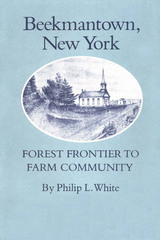 Beekmantown, New York: Forest Frontier to Farm Community
By Philip L. White
University of Texas Press, 1979 This volume reports in detail how a particular portion of the American wilderness developed into a settled farming community. To fully comprehend the history of the American people in the early national period, an understanding of this transformation from forest to community—and the pattern of life within such communities where the vast majority of the people live—is essential. Three major conclusions emerge from Philip L. White's study of Beekmantown, New York. First, the economic advantages of the frontier attracted a first generation of settlers relatively high in social and economic status, but the disappearance of frontier conditions brought a second generation of settlers appreciably lower in status. Second, White rejects the romantic notion that the frontier fostered equality and argues instead that the frontier's economic opportunities fostered inequality. Finally, in contrast to revisionist arguments, he affirms that in Beekmantown the Jacksonian period does indeed warrant characterization as the era of the "common man." This book represents a model in community history: the narrative is full of human interest; the scholarship is prodigious; the applications are universal.
Been a Heavy Life: Stories of Violent Men
Lois Presser
University of Illinois Press, 2007 In this groundbreaking work, Lois Presser investigates the life stories of men who have perpetrated violence. She applies insights from across the academy to in-depth interviews with men who shared their accounts of how they became the people we most fear--those who rape, murder, assault, and rob, often repeatedly. Been a Heavy Life provides the discipline of criminology with two crucial frameworks: one for critically evaluating the construction of offenders’ own stories, and one for grasping the cultural meta-narratives that legitimize violence. For social scientists generally, this book offers a vivid demonstration of just how dynamic and contingent self-narratives are.
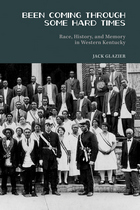 Been Coming through Some Hard Times: Race, History, and Memory in Western Kentucky
Jack Glazier
University of Tennessee Press, 2013 “This book is a unique study of race and racism across two centuries in the hinterland of the upper South. Its implications are at once depressingly familiar and distinctly fresh.” —W. Fitzhugh Brundage, author of Lynching in the New South: Georgia and Virginia, 1880–1930
From the earliest days when slaves were brought to western Kentucky, the descendants of both slaves and slave owners in Hopkinsville, Kentucky, have continued to inhabit the same social and historic space. Part ethnography and part historical narrative, Been Coming through Some Hard Times offers a penetrating look at this southern town and the surrounding counties, delving particularly into the ways in which its inhabitants have remembered and publicly represented race relations in their community.
Neither Deep South nor Appalachian, this western Kentucky borderland presented unique opportunities for African American communities and also deep, lasting tensions with powerful whites. Glazier conducted fieldwork in Hopkinsville for some ten months, examining historical evidence, oral histories, and the racialized hierarchy found in the final resting places of black and white citizens. His analysis shows how structural inequality continues to prevail in Hopkinsville. The book’s ethnographic vignettes of worship services, school policy disputes, segregated cemeteries, a “dressing like our ancestors” day at an elementary school, and black family reunions poignantly illustrate the ongoing debate over the public control of memory. Ultimately, the book critiques the lethargy of white Americans who still fail to recognize the persistence of white privilege and therefore stunt the development of a truly multicultural society.
Glazier’s personal investment in this subject is clear. Been Coming through Some Hard Times began as an exploration of the life of James Bass, an African American who settled in Hopkinsville in 1890 and whose daughter, Idella Bass, cared for Glazier as a child. Her remarkable life profoundly influenced Glazier and led him to investigate her family’s roots in the town. This personal dimension makes Glazier’s ethnohistorical account especially nuanced and moving. Here is a uniquely revealing look at how the racial injustices of the past impinge quietly but insidiously upon the present in a distinctive, understudied region.
JACK GLAZIER is a professor of anthropology at Oberlin College. He is the author of Dispersing the Ghetto: The Relocation of Jewish Immigrants across America and Land and the Uses of Tradition among the Mbeere of Kenya.
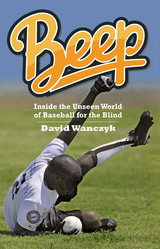 Beep: Inside the Unseen World of Baseball for the Blind
David Wanczyk
Ohio University Press, 2018 In Beep, David Wanczyk illuminates the sport of blind baseball to show us a remarkable version of America’s pastime. With balls tricked out to squeal three times per second, and with bases that buzz, this game of baseball for the blind is both innovative and intense. And when the best beep baseball team in America, the Austin Blackhawks, takes on its international rival, Taiwan Homerun, no one’s thinking about disability. What we find are athletes playing their hearts out for a championship. Wanczyk follows teams around the world and even joins them on the field to produce a riveting inside narrative about the game and its players. Can Ethan Johnston, kidnapped and intentionally blinded as a child in Ethiopia, find a new home in beep baseball, and a spot on the all-star team? Will Taiwan’s rookie MVP Ching-kai Chen—whose superhuman feats on the field have left some veterans suspicious—keep up his incredible play? And can Austin’s Lupe Perez harness his competitive fire and lead his team to a long-awaited victory in the beep baseball world series? Beep is the first book about blind baseball.
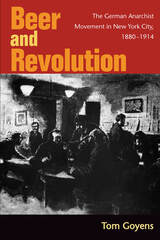 Beer and Revolution: The German Anarchist Movement in New York City, 1880-1914
Tom Goyens
University of Illinois Press, 2007 Understanding an infamous political movement's grounding in festivity and defiance Beer and Revolution examines the rollicking life and times of German immigrant anarchists in New York City from 1880 to 1914. Offering a new approach to an often misunderstood political movement, Tom Goyens puts a human face on anarchism and reveals a dedication less to bombs than to beer halls and saloons where political meetings, public lectures, discussion circles, fundraising events, and theater groups were held. Goyens brings to life the fascinating relationship between social space and politics by examining how the intersection of political ideals, entertainment, and social activism embodied anarchism not as an abstract idea, but as a chosen lifestyle for thousands of women and men. He shows how anarchist social gatherings were themselves events of defiance and resistance that aimed at establishing anarchism as an alternative lifestyle through the combination of German working-class conviviality and a dedication to the principle that coercive authority was not only unnecessary, but actually damaging to full and free human development as well. Goyens also explores the broader circumstances in both the United States and Germany that served as catalysts for the emergence of anarchism in urban America and how anarchist activism was hampered by police surveillance, ethnic insularity, and a widening gulf between the anarchists' message and the majority of American workers.
 Beer, Brats, and Cheese: A Wisconsin Road Trip
Heather Kerrigan
University of Wisconsin Press, 2025 Although Wisconsin foodways contain much more than beer, brats, and cheese, these remain at the pinnacle of the state’s fame—and rightly so. If you live in Wisconsin—or have simply visited—you know it’s hard to imagine tailgating, graduating, or celebrating without the Big Three.
To thoroughly research this book, Heather Kerrigan undertook a twenty-six-hundred-mile road trip crisscrossing the Badger State, seeking the hidden gems that locals frequent. She visited Wisconsin’s best restaurants, creameries, breweries, butcher shops, and cheesemongers. In Beer, Brats, and Cheese, Kerrigan highlights the innovative flavors and unexpected delights found in these spots. Great beer isn’t made only in Milwaukee, Sheboygan doesn’t have a lock on the best bratwurst, and excellent cheeses don’t just come from Monroe County. In fact, there are towns large and small, from the far north to the Illinois border, from Door County to the Mississippi River, that contribute to the state’s amazing culinary experiences.
Whether you’re planning a bite-by-bite day trip or simply looking for a great place to eat or drink near home, this guide has you covered.
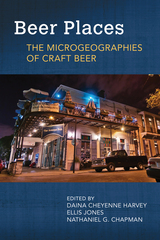 Beer Places: The Microgeographies of Craft Beer
Daina Cheyenne Harvey
University of Arkansas Press, 2023 Beer Places is, most essentially, a road map for craft beer, taking readers to various locales to discover the beverage’s deep connections to place. At another level, Beer Places is an academic analysis of these geographical ties. Collected into sections that address authenticity and revitalization, politics and economics, and collectivity and collaboration, this book blends new research with a series of “postcards”: informal conversations and first-person dispatches from the field that transport readers to the spots where pints are shared, networks forged, and spaces defined.
With insight from social scientists, beer bloggers, travel writers, and food entrepreneurs who recount their experiences of taprooms, breweries, and bottle shops from North Carolina to Zimbabwe, Beer Places reveals differences in the craft beer scene across multiple geographies. Situating craft beer as an emerging and important component of food studies, the essays in this volume attest to the singular power of craft beer to connect people and places.
Be’erot Yitzhak: Studies in Memory of Isadore Twersky
Jay M. Harris
Harvard University Press, 2005 Professor Isadore Twersky was one of the giants of the field of Jewish Studies. Among his many accomplishments was the supervision of over thirty-five dissertations in Jewish Studies, ranging chronologically from the tenth century to the twentieth, and geographically from the Middle East to the Mediterranean world and on to northern Europe, east and west. In this memorial volume, many of his students pay homage to their late teacher in the only way he would have appreciated: they have produced a collection of essays that show his and their remarkable range of interests and talents. The result is an important collection of original scholarship on a wide range of topics in Jewish Studies.
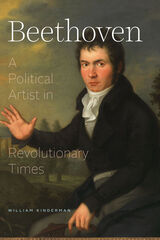 Beethoven: A Political Artist in Revolutionary Times
William Kinderman
University of Chicago Press, 2021 We have long regarded Beethoven as a great composer, but we rarely appreciate that he was also an eminently political artist. This book unveils the role of politics in his oeuvre, elucidating how the inherently political nature of Beethoven’s music explains its power and endurance.
William Kinderman presents Beethoven as a civically engaged thinker faced with severe challenges. The composer lived through many tumultuous events—the French Revolution, the rise and fall of Napoleon Bonaparte, and the Congress of Vienna among them. Previous studies of Beethoven have emphasized the importance of his personal suffering and inner struggles; Kinderman instead establishes that musical tensions in works such as the Eroica, the Appassionata, and his final piano sonata in C minor reflect Beethoven’s attitudes toward the political turbulence of the era. Written for the 250th anniversary of his birth, Beethoven takes stock of the composer’s legacy, showing how his idealism and zeal for resistance have ensured that masterpieces such as the Ninth Symphony continue to inspire activists around the globe. Kinderman considers how the Fifth Symphony helped galvanize resistance to fascism, how the Sixth has energized the environmental movement, and how Beethoven’s civic engagement continues to inspire in politically perilous times. Uncertain times call for ardent responses, and, as Kinderman convincingly affirms, Beethoven’s music is more relevant today than ever before.
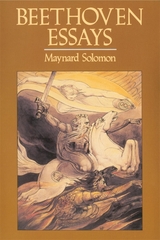 Beethoven Essays
Maynard Solomon
Harvard University Press, 1988 Maynard Solomon is the author of a classic biography of Beethoven which has become a standard work throughout the world, having been translated into seven languages. In Beethoven Essays, he continues his exploration of Beethoven’s inner life, visionary outlook, and creativity, in a series of profound studies of this colossal figure of our civilization.
Solomon deftly fuses a variety of investigative approaches, from rigorous historical and ideological studies to imaginative musical and psychoanalytic speculations. Thus, after closely documenting Beethoven’s birth and illegitimacy fantasies, his “Family Romance,” and his pretense of nobility, Solomon offers extraordinary interpretations of the composer’s dreams, deafness, and obsessive relationship to his nephew. And, following his detailed uncovering of a complex network of recurrent patterns in the Ninth Symphony, he considers the narrative and mythic implications of Beethoven’s formal design.
Solomon examines the broad patterns of Beethoven’s creative evolution and processes of composition, the radical modernism of his music, and his intellectual, religious, and utopian strivings. A separate section on the “Immortal Beloved” includes the fullest biography of Antonia Brentano yet published. Closing the volume is Solomon’s translation and annotated edition of Beethoven’s Tagebuch, the moving, intimate diary that the composer kept during the critical period that culminated in his last style. Here, as throughout Beethoven Essays, Solomon offers scholarship that is at the cutting edge of Beethoven research.
 Beethoven Essays: Studies in Honor of Elliot Forbes
Lewis Lockwood
Harvard University Press, 1984 Significant new insights into Beethoven's life and style are offered in this volume in honor of Elliot Forbes, whose revision of Thayer's Life of Beethoven is the standard modern edition of that classic. Essays by James Webster, Martin Staehelin, Alan Tyson, Maynard Solomon, and Michael Ochs look carefully at aspects of Beethoven's career and also deal with Thayer and his work as biographer. Studies of individual works include Edward T. Cone's completion of an unfinished cadenza for the First Piano Concerto and Geoffrey Block's look at sources for the Second Piano Concerto. Sieghard Brandenburg provides an essay on the scherzo of the Fifth Symphony based on an exhaustive scrutiny of its sources. Christopher Reynolds writes on the Violin Sonata Op. 30, no. 1. J. Merrill Knapp contributes an article on the Mass in C major, Op. 86, and Robert Winter discusses the origins of the Missa solemnis, Op. 123.
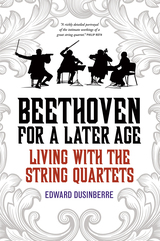 Beethoven for a Later Age: Living with the String Quartets
Edward Dusinberre
University of Chicago Press, 2016 Beethoven’s sixteen string quartets are some of the most extraordinary and challenging pieces of music ever written. Originally composed and performed between 1798 and 1826, they have inspired artists of all kinds—not only musicians—and have been subject to endless reinterpretation. But what is it like to personally take up the challenge of these compositions, not only as a musician, but as a member of a quartet, where each player has ideas about style and expression? To answer this question, Edward Dusinberre, first violinist of the renowned Takács Quartet, offers a rare peek inside the workings of his ensemble, while providing an insightful history of the compositions and their performance.
Founded in Hungary in 1975 and now based in Boulder, Colorado, the Takács is one of the world’s preeminent string quartets, and performances of Beethoven have been at the center of their work together for over forty years. Using the history of both the Takács Quartet and the Beethoven quartets as a foundation, Beethoven for a Later Age provides a backstage look at the daily life of a quartet, showing the necessary creative tension between individual and group and how four people can at the same time forge a lasting artistic connection and enjoy making music together over decades. The key, Dusinberre reveals, to a quartet crafting its own sound is in balancing continuity with change and experimentation—a theme that lies at the heart of Beethoven’s remarkable compositions. In an accessible style, suitable for novices and chamber music enthusiasts alike, Dusinberre illuminates the variety and contradictions of Beethoven's quartets, which were composed against the turbulent backdrop of the Napoleonic Wars and their aftermath, and he brings the technical aspects of the music to life.
Beethoven for a Later Age vividly shows that creative engagement with Beethoven’s radical and brilliant quartets continues to be as stimulating now as it was for its first performers and audiences. Musicians and music lovers will be intrigued by Dusinberre’s exploration of the close collaboration at the heart of any great performance.
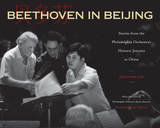 Beethoven in Beijing: Stories from the Philadelphia Orchestra's Historic Journey to China
Jennifer Lin
Temple University Press, 2022 In 1973, Western music was banned in the People’s Republic of China. But in a remarkable breakthrough cultural exchange, the Philadelphia Orchestra conducted a tour of closed-off China, becoming the first American orchestra to visit the communist nation. Jennifer Lin’s Beethoven in Beijing provides a fabulous photo-rich oral history of this boundary-breaking series of concerts the orchestra performed under famed conductor Eugene Ormandy. Lin draws from interviews, personal diaries, and news accounts to give voice to the American and Chinese musicians, diplomats, journalists, and others who participated in and witnessed this historic event. Beethoven in Beijing is filled with glorious images as well as anecdotes ranging from amusing sidewalk Frisbee sessions and acupuncture treatments for sore musicians to a tense encounter involving Madame Mao dictating which symphony was to be played at a concert. A companion volume to the film of the same name, Beethoven in Beijing shows how this 1973 tour came at the dawn of a resurgence of interest in classical music in China—now a vital source of revenue for touring orchestras.
 Beethoven: Studies in the Creative Processes
Lewis Lockwood
Harvard University Press, 1992 It is well known that Mozart developed his works in his head and then simply transcribed them onto paper, while Beethoven labored assiduously over sketches and drafts--"his first ideas," in Stephen Spender's words, "of a clumsiness which makes scholars marvel at how he could, at the end, have developed from them such miraculous results." Indeed Beethoven's extensive sketchbooks (which total over 8,000 pages) and the autograph manuscripts, covering several stages of development, reveal the composer systematically exploring and evolving his musical ideas.
Through close investigation of individual works, Lewis Lockwood traces the creative process as it emerges in Beethoven's sketches and manuscripts. Four studies address the composition of the Eroica Symphony from various viewpoints. The chamber works discussed include the Cello Sonata in A Major, Opus 69 (of which the entire autograph manuscript of the first movement is published here in facsimile), the string quartet Opus 59 No. 1, and the Cavatina of the later quartet Opus 130. Lockwood's lucid analysis enhances our understanding of Beethoven's musical strategies and stylistic developments as well as the compositional process itself In a final chapter the author outlines the importance of Beethoven's autographs for the modern performer.
The Beethoven Violin Sonatas: History, Criticism, Performance
Edited by Lewis Lockwood and Mark Kroll
University of Illinois Press, 2004 Beethoven's ten violin sonatas have long been cornerstones of the chamber music repertoire. The "Spring" and "Kreutzer" sonatas are the best known of these works, which stand at the pinnacle of music for violin and piano.
Lewis Lockwood and Mark Kroll's volume The Beethoven Violin Sonatas is the first scholarly book in English devoted exclusively to the Beethoven sonatas, and deals with them in unprecedented depth. It presents seven critical and historical essays by some of the most important American and European Beethoven specialists of our time. The authors examine the sonatas within the history of the genre, the social and cultural context in which they were written, their significance within Beethoven's life and works, and the issues they raise regarding performance practices of the period.
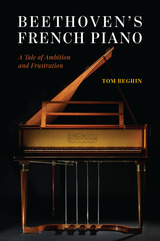 Beethoven's French Piano: A Tale of Ambition and Frustration
Tom Beghin
University of Chicago Press, 2022 Using a replica of Beethoven’s Erard piano, scholar and performer Tom Beghin launches a striking reinterpretation of a key period of Beethoven’s work.
In 1803 Beethoven acquired a French piano from the Erard Frères workshop in Paris. The composer was “so enchanted with it,” one visitor reported, “that he regards all the pianos made here as rubbish by comparison.” While Beethoven loved its sound, the touch of the French keyboard was much heavier than that of the Viennese pianos he had been used to. Hoping to overcome this drawback, he commissioned a local technician to undertake a series of revisions, with ultimately disappointing results. Beethoven set aside the Erard piano for good in 1810.
Beethoven’s French Piano returns the reader to this period of Beethoven’s enthusiasm for all things French. What traces of the Erard’s presence can be found in piano sonatas like his “Waldstein” and “Appassionata”? To answer this question, Tom Beghin worked with a team of historians and musicians to commission the making of an accurate replica of the Erard piano. As both a scholar and a recording artist, Beghin is uniquely positioned to guide us through this key period of Beethoven’s work. Whether buried in archives, investigating the output of the French pianists who so fascinated Beethoven, or seated at the keyboard of his Erard, Beghin thinks and feels his way into the mind of the composer, bringing startling new insights into some of the best-known piano compositions of all time.
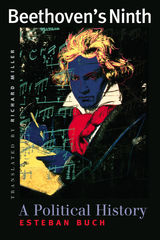 Beethoven's Ninth: A Political History
Esteban Buch
University of Chicago Press, 2003 Who hasn't been stirred by the strains of Beethoven's Ninth Symphony? That's a good question, claims Esteban Buch. German nationalists and French republicans, communists and Catholics have all, in the course of history, embraced the piece. It was performed under the direction of Leonard Bernstein at a concert to mark the fall of the Berlin Wall, yet it also serves as a ghastly and ironic leitmotif in Stanley Kubrick's A Clockwork Orange. Hitler celebrated his birthdays with it, and the government of Rhodesia made it their anthem. And played in German concentration camps by the imprisoned, it also figured prominently at Mitterand's 1981 investiture.
In his remarkable history of one of the most popular symphonic works of the modern period, Buch traces such complex and contradictory uses—and abuses—of Beethoven's Ninth Symphony since its premier in 1824. Buch shows that Beethoven consciously drew on the tradition of European political music, with its mix of sacred and profane, military and religious themes, when he composed his symphony. But while Beethoven obviously had his own political aspirations for the piece—he wanted it to make a statement about ideal power—he could not have had any idea of the antithetical political uses, nationalist and universalist, to which the Ninth Symphony has been put since its creation. Buch shows us how the symphony has been "deployed" throughout nearly two centuries, and in the course of this exploration offers what was described by one French reviewer as "a fundamental examination of the moral value of art." Sensitive and fascinating, this account of the tangled political existence of a symphony is a rare book that shows the life of an artwork through time, shifted and realigned with the currents of history.
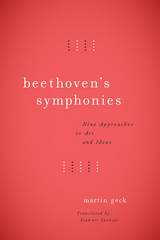 Beethoven's Symphonies: Nine Approaches to Art and Ideas
Martin Geck
University of Chicago Press, 2017 In the years spanning from 1800 to 1824, Ludwig van Beethoven completed nine symphonies, now considered among the greatest masterpieces of Western music. Yet despite the fact that this time period, located in the wake of the Enlightenment and at the peak of romanticism, was one of rich intellectual exploration and social change, the influence of such threads of thought on Beethoven’s work has until now remained hidden beneath the surface of the notes. Beethoven’s Symphonies presents a fresh look at the great composer’s approach and the ideas that moved him, offering a lively account of the major themes unifying his radically diverse output.
Martin Geck opens the book with an enthralling series of cultural, political, and musical motifs that run throughout the symphonies. A leading theme is Beethoven’s intense intellectual and emotional engagement with the figure of Napoleon, an engagement that survived even Beethoven’s disappointment with Napoleon’s decision to be crowned emperor in 1804. Geck also delves into the unique ways in which Beethoven approached beginnings and finales in his symphonies, as well as his innovative use of particular instruments. He then turns to the individual symphonies, tracing elements—a pitch, a chord, a musical theme—that offer a new way of thinking about each work and will make even the most devoted fans of Beethoven admire the symphonies anew.
Offering refreshingly inventive readings of the work of one of history’s greatest composers, this book shapes a fascinating picture of the symphonies as a cohesive oeuvre and of Beethoven as a master symphonist.
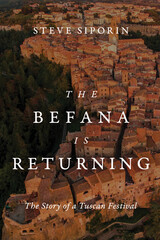 The Befana Is Returning: The Story of a Tuscan Festival
Steve Siporin
University of Wisconsin Press, 2022 On the night of January 5, in certain areas of southern Tuscany, a costumed, singing troupe of characters visits residents’ homes, expecting to be fed and feted in a folk custom that has recurred in the region for centuries. This is the Befanata, a mumming tradition centered in Tuscany, whose main character—the Befana—is a kindly old woman or grandmotherly witch who delivers toys, candies, and gifts. Part of the Christmas season, the Befana is familiar in some form in much of Italy, but very little has been written about her, despite sustained interest in European mumming traditions in general.
The Pigitliano Befanata is distinct in its emphasis on song and strong in its richly symbolic use of food, which is not only consumed at each home but is also carried away as a gift. The characters who make up the squad are unique to the Italian practice. They always include the Befana and her husband, the Befano, but other members of the befanotti vary from place to place over time. Siporin combines fieldwork and archival evidence to introduce the Befanata and its historical and social contexts: what it is, what it means, and how it feels. The Befana Is Returning is a deeply researched, deftly insightful presentation of this living tradition that adds a large missing piece to the array of contemporary ethnographic scholarship on mumming.
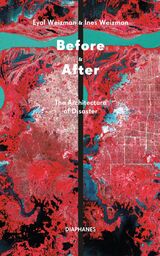 Before & After: The Architecture of Disaster
Eyal Weizman and Ines Weizman
Diaphanes, 2025 A study of the history of before-and-after images of catastrophes, bombed-out cities, and large-scale political transformations.
Catastrophes, bombed-out cities, large-scale political transformations: “Image complexes” of humanitarian and ecological upheaval document the world as a sequence of catastrophes. But who decides how events are presented, determines the resolution of our visual worlds, and controls the circulation or censorship of images?
Eyal and Ines Weizman trace the history of the before-and-after image from nineteenth-century photography to contemporary satellite images and discover a gap that not only conceals the devastating event: it is the human subject itself that is in danger of disappearing from the images. Does humanitarian work, the documentation and reconstruction of war crimes, in which people’s fates and rights should be at the center of attention, paradoxically enter a post-human phase? How can the gap between images become a site of critical counter-reading rather than a symbol of erasure?
In the context of their current research, Eyal and Ines Weizman discuss the history, present, and future of the paradigm of the before-and-after image in an exclusive conversation with Marie Glassl.
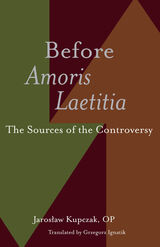 Before Amoris Laetitia: The Sources of the Controversy
Jaroslaw Kupczak
Catholic University of America Press, 2021 The publication of Pope Francis’ post-synodal apostolic exhortation, Amoris Laetitia started the most important theological debate in the Catholic Church since the end of the Second Vatican Council. The cardinals, bishops, theologians, priests, lay Catholics found themselves on the opposite sides of this crucial and complicated discussion. This book attempts to shed some light on this debate by tracing its genealogy.
Since Amoris Laetitia is a post-synodal document, the large part of the book is devoted to the theological analysis of the two Synods of Bishops convoked by Pope Francis in the first years of his pontificate: the extraordinary in October 2014 and the ordinary that took place a year later. The main topics for the two synods were determined, however, in the speech given by Cardinal Walter Kasper during the cardinals consistory in February 2014 whose main aim was to prepare the possibility of admitting divorced persons who live in second unions to Holy Communion. The arguments of Cardinal Kasper are presented in the first chapter of the book and confronted with the most significant statements of the Magisterium of the Church on the issue of admittance to the Holy Communion.
This book is a study at the intersection of Church history, the history of theology, and systematic theology: dogmatic and moral. Kupczak is interested in the chronology of the events connected to the two synods on the family but in the context of theological problems discussed therein: the theological significance of contemporary cultural changes; the relation of the Church to the world; the understanding of the indissolubility of the sacramental marriage and the Eucharist; the methods of ethically assessing human acts, particularly the concept of so-called intrinsically evil acts (intrinsece malum); and the relation of conscience to the general moral norm. The non-partisan ambition of this book is to serve as a “road map”— a help in navigation for the reader in the complicated discussions leading to publication of Amoris Laetitia.
The uniqueness of this book consists in combining the historical analysis of the events leading to the publication of Amoris Laetitia with research of the theological discussion that ensued. Since Amoris Laetitia is a post-synodal exhortation, this book rests on the assumption that crucial for its understanding is a thorough analysis of its genealogy. Only in the light of this historical and theological perspective the debates surrounding Amoris Laetitia may be understood.
 Before and After an Oil Spill: The Arthur Kill
Burger, Joanna
Rutgers University Press, 1994 In January 1990, the New York Harbor suffered a major oil spill when an underwater pipe at an Exxon refinery leaked into the Arthur Kill, the fifteen-mile strait that runs between New Jersey and Staten Island. The waterway is home to herons and egrets, fiddler crabs and sea turtles, and a favorite place for recreational fishing, bird-watching, hiking, and boating. It is also lined with refineries and a busy corridor for oil tankers. Because this industrial activity posed such an imposing threat to the fragile ecosystem, biologists had been monitoring the region’s water, soil, vegetation, and wildlife for some time before the oil spill. Thus, we have before -and-after data about the habitat—the only oil spill anywhere for which this is true.
This unique book discusses the human consequences of the oil spill as well as providing detailed studies of its effects on the plants and animals of the Arthur Kill. Biologists, environmentalists, lawyers, and officials worldwide will find this book an essential guide to dealing with—and possibly preventing—future environmental disasters.
The contributors areJohn Brzorad, Angela Christini, Keith Cooper, Lynn Frink, Michael Gochfeld, Paul Hauge, Gordon Johnson, Alan D. Maccarone, Katherine Parsons, Carolyn Summers, Robert Tucker.
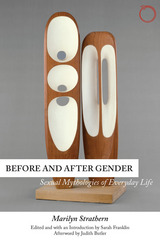 Before and After Gender: Sexual Mythologies of Everyday Life
Marilyn Strathern
HAU, 2016 Written in the early 1970s amidst widespread debate over the causes of gender inequality, Marilyn Strathern’s Before and After Gender was intended as a widely accessible analysis of gender as a powerful cultural code and sex as a defining mythology. But when the series for which it was written unexpectedly folded, the manuscript went into storage, where it remained for more than four decades. This book finally brings it to light, giving the long-lost feminist work—accompanied here by an afterword from Judith Butler—an overdue spot in feminist history.
Strathern incisively engages some of the leading feminist thinkers of the time, including Shulamith Firestone, Simone de Beauvoir, Ann Oakley, and Kate Millett. Building with characteristic precision toward a bold conclusion in which she argues that we underestimate the materializing grammars of sex and gender at our own peril, she offers a powerful challenge to the intransigent mythologies of sex that still plague contemporary society. The result is a sweeping display of Strathern’s vivid critical thought and an important contribution to feminist studies that has gone unpublished for far too long.
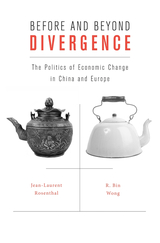 Before and Beyond Divergence: The Politics of Economic Change in China and Europe
Jean-Laurent Rosenthal and R. Bin Wong
Harvard University Press, 2011 China has reemerged as a powerhouse in the global economy, reviving a classic question in economic history: why did sustained economic growth arise in Europe rather than in China?
Many favor cultural and environmental explanations of the nineteenth-century economic divergence between Europe and the rest of the world. This book, the product of over twenty years of research, takes a sharply different tack. It argues that political differences which crystallized well before 1800 were responsible both for China’s early and more recent prosperity and for Europe’s difficulties after the fall of the Roman Empire and during early industrialization.
Rosenthal and Wong show that relative prices matter to how economies evolve; institutions can have a large effect on relative prices; and the spatial scale of polities can affect the choices of institutions in the long run. Their historical perspective on institutional change has surprising implications for understanding modern transformations in China and Europe and for future expectations. It also yields insights in comparative economic history, essential to any larger social science account of modern world history.
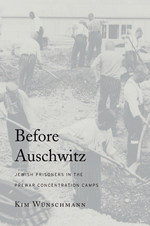 Before Auschwitz: Jewish Prisoners in the Prewar Concentration Camps
Kim Wünschmann
Harvard University Press, 2015 Winner of the Yad Vashem International Book Prize for Holocaust Research
Auschwitz—the largest and most notorious of Hitler’s concentration camps—was founded in 1940, but the Nazis had been detaining Jews in camps ever since they came to power in 1933. Before Auschwitz unearths the little-known origins of the concentration camp system in the years before World War II and reveals the instrumental role of these extralegal detention sites in the development of Nazi policies toward Jews and in plans to create a racially pure Third Reich.
Investigating more than a dozen camps, from the infamous Dachau, Buchenwald, and Sachsenhausen to less familiar sites, Kim Wünschmann uncovers a process of terror meant to identify and isolate German Jews in the period from 1933 to 1939. The concentration camp system was essential to a regime then testing the limits of its power and seeking to capture the hearts and minds of the German public. Propagandized by the Nazis as enemies of the state, Jews were often targeted for arbitrary arrest and then routinely subjected to the harshest treatment and most punishing labor assignments in the camps. Some of them were murdered. Over time, shocking accounts of camp life filtered into the German population, sending a message that Jews were different from true Germans: they were portrayed as dangerous to associate with and fair game for acts of intimidation and violence.
Drawing on a wide range of previously unexplored archives, Before Auschwitz explains how the concentration camps evolved into a universally recognized symbol of Nazi terror and Jewish persecution during the Holocaust.
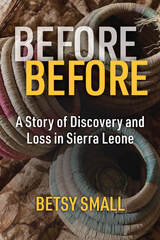 Before Before: A Story of Discovery and Loss in Sierra Leone
Betsy Small
University of Michigan Press, 2025 Sierra Leone is often sensationalized as a place of extreme violence and suffering—of blood diamonds, child soldiers, war amputations, and Ebola and now the highly addictive drug Kush. Before Before captures daily life in a different country, one Betsy Small first encountered as a Peace Corps worker between 1984–1987, and then rediscovered when she returned decades later with her daughter. Living in Tokpombu, a remote community of forty rice-farming families, the author faced struggles that changed her forever and witnessed the growing tensions in this rainforest village—between the young and old, between the traditions of oral history and honoring the ancestors valued by the elders and the siren call of the illicit diamond mines faced by the youth.
Before Before offers a rare portrait of everyday people, with particular focus on the lives of women and girls, before the brutal war of 1991 tore the country apart. Through Small’s account of immersion in another world as she witnessed injustice and was welcomed as a friend, readers are invited to explore the shared ground of our humanity.
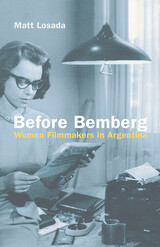 Before Bemberg: Women Filmmakers in Argentina
Matt Losada
Rutgers University Press, 2020 Before Bemberg: Argentine Women Filmmakers calls into question the historiography of Argentine women filmmakers that has centered on María Luisa Bemberg to the exclusion of her predecessors. Its introductory discussion of the abundant initial participation by women in film production in the 1910s is followed by an account of their exclusion from creative roles in the studio cinema, which was only altered by the opportunities opened by a boom in short filmmaking in the 1960s. The book then discusses in depth the six sound features directed by women before 1980, which, despite their trailblazing explorations of the perspectives of female characters, daring denunciations of authoritarianism and censorship, and modernizing formal invention, have been forgotten by Argentine film history. Looking at the work and roles of Eva Landeck, Vlasta Lah, María Herminia Avellaneda and María Elena Walsh and Maria Bemberg, the book recognizes these filmmakers’ contributions at a significant moment in which movements to eliminate gender-based oppression and violence in Argentina and elsewhere are surging. Watch some of the films discussed in the book with English subtitles (https://www.youtube.com/channel/UCF_6F4am5024rklIWwExUVA?view_as=subscriber).
Before, Between, and Beyond: Three Decades of Dance Writing
Sally Banes; Edited and with an introduction by Andrea Harris
University of Wisconsin Press, 2007 Sally Banes has been a preeminent critic and scholar of American contemporary dance, and Before, Between, Beyond spans more than thirty years of her prolific work. Beginning with her first published review and including previously unpublished papers, this collection presents some of her finest works on dance and other artistic forms. It concludes with her most recent research on Geroge Balanchine's dancing elephants. In each piece, Banes's detailed eye and sensual prose strike a rare balance between description, context, and opinion, delineating the American artistic scene with remarkable grace. With contextualizing essays by dance scholars Andrea Harris, Joan Acocella, and Lynn Garafola, this is a compelling, insightful indispensable summation of Banes's critical career.
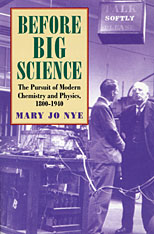 Before Big Science: The Pursuit of Modern Chemistry and Physics, 1800-1940
Mary Jo Nye
Harvard University Press, 1996 Today's vast multinational scientific monoliths bear little resemblance to the modest laboratories of the early nineteenth century. Yet early in the nineteenth century--when heat and electricity were still counted among the elements--changes were already under way that would revolutionize chemistry and physics into the "big science" of the late twentieth century, expanding tiny, makeshift laboratories into bustling research institutes and replacing the scientific amateurs and generalist savants of the early Victorian era with the professional specialists of contemporary physical science.
Mary Jo Nye traces the social and intellectual history of the physical sciences from the early 1800s to the beginning of the Second World War, examining the sweeping transformation of scientific institutions and professions during the period and the groundbreaking experiments that fueled that change, from the earliest investigations of molecular chemistry and field dynamics to the revolutionary breakthroughs of quantum mechanics, relativity theory, and nuclear science.
 Before Birth: Prenatal Testing for Genetic Disease
Elena Nightingale and Melissa Goodman
Harvard University Press, 1990 Information on prenatal testing abounds, but few books are addressed to prospective parents in need of practical guidance. In this comprehensive and sensitive account, Elena Nightingale and Melissa Goodman offer remarkably clear answers to the set of bewildering questions generated by the concerns of parenthood.
Prospective parents are given the guidance needed to make informed choices about whether or not to undergo testing and, if they elect to do so, how best to use the results. As humans, we are recipients of a rich genetic heritage. Each human cell contains 46 chromosomes with a total of 50,000 to 100,000 genes distributed among them. Such richness carries immense possibilities for error when gene replication occurs; it is therefore not surprising that gene disorders such as Down syndrome, Huntington's disease, and neural tube defects pose a major public health problem. Rapid development of sophisticated new techniques has vastly increased our ability to diagnose genetic disorders during the prenatal period. For example, the amniotic fluid sampled in the middle trimester can be tested for such biochemical abnormalities as Tay-Sachs disease. The advent of more recent techniques, such as sampling the cells of the villi of the chorion (a procedure that can be carried out in the first trimester), employing gene probes, and using ultrasonographic detection, has advanced the diagnosis of genetic disorders faster than most researchers would have thought possible.
Nightingale and Goodman carefully explain the practicalities of this potentially confusing array of prenatal tests: how they are performed, what they reveal, and what their limitations are. The book concludes with a thoughtful consideration of the economic, ethical, and legal issues related to prenatal screening. Although primarily intended to assist prospective parents, this volume is also of interest to health care providers, public health officials, and policymakers who struggle with these difficult decisions.
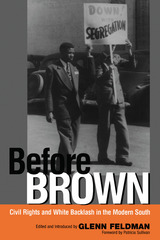 Before Brown: Civil Rights and White Backlash in the Modern South
Glenn Feldman
University of Alabama Press, 2004 Details the ferment in civil rights that took place across the South before the momentous Brown vs. Board of Education decision in 1954
This collection refutes the notion that the movement began with the Supreme Court decision, and suggests, rather, that the movement originated in the 1930s and earlier, spurred by the Great Depression and, later, World War II—events that would radically shape the course of politics in the South and the nation into the next century. This work explores the growth of the movement through its various manifestations—the activities of politicians, civil rights leaders, religious figures, labor unionists, and grass-roots activists—throughout the 1940s and 1950s. It discusses the critical leadership roles played by women and offers a new perspective on the relationship between the NAACP and the Communist Party. Before Brown shows clearly that, as the drive toward racial equality advanced and national political attitudes shifted, the validity of white supremacy came increasingly into question. Institutionalized racism in the South had always offered white citizens material advantages by preserving their economic superiority and making them feel part of a privileged class. When these rewards were threatened by the civil rights movement, a white backlash occurred.
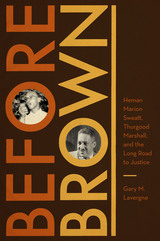 Before Brown: Heman Marion Sweatt, Thurgood Marshall, and the Long Road to Justice
By Gary M. Lavergne
University of Texas Press, 2010 Winner, Coral Horton Tullis Memorial Prize for Best Book on Texas History, Texas State Historical Association, 2010
Carr P. Collins Award, Texas Institute of Letters, 2011 On February 26, 1946, an African American from Houston applied for admission to the University of Texas School of Law. Although he met all of the school's academic qualifications, Heman Marion Sweatt was denied admission because he was black. He challenged the university's decision in court, and the resulting case, Sweatt v. Painter, went to the U.S. Supreme Court, which ruled in Sweatt's favor. The Sweatt case paved the way for the landmark Brown v. Board of Education of Topeka rulings that finally opened the doors to higher education for all African Americans and desegregated public education in the United States. In this engrossing, well-researched book, Gary M. Lavergne tells the fascinating story of Heman Sweatt's struggle for justice and how it became a milestone for the civil rights movement. He reveals that Sweatt was a central player in a master plan conceived by the National Association for the Advancement of Colored People (NAACP) for ending racial segregation in the United States. Lavergne masterfully describes how the NAACP used the Sweatt case to practically invalidate the "separate but equal" doctrine that had undergirded segregated education for decades. He also shows how the Sweatt case advanced the career of Thurgood Marshall, whose advocacy of Sweatt taught him valuable lessons that he used to win the Brown v. Board of Education case in 1954 and ultimately led to his becoming the first black Associate Justice of the Supreme Court.
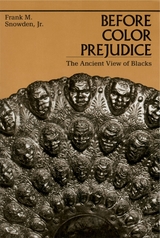 Before Color Prejudice: The Ancient View of Blacks
Frank M. Snowden
Harvard University Press, 1983 In this richly illustrated account of black–white contacts from the Pharaohs to the Caesars, Frank Snowden demonstrates that the ancients did not discriminate against blacks because of their color.
For three thousand years Mediterranean whites intermittently came in contact with African blacks in commerce and war, and left a record of these encounters in art and in written documents. The blacks—most commonly known as Kushites, Ethiopians, or Nubians—were redoubtable warriors and commanded the respect of their white adversaries. The overall view of blacks was highly favorable. In science, philosophy, and religion color was not the basis of theories concerning inferior peoples. And early Christianity saw in the black man a dramatic symbol of its catholic mission.
This book sheds light on the reasons for the absence in antiquity of virulent color prejudice and for the difference in attitudes of whites toward blacks in ancient and modern societies.
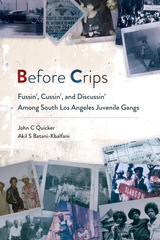 Before Crips: Fussin', Cussin', and Discussin' among South Los Angeles Juvenile Gangs
John C. Quicker and Akil S. Batani-Khalfani
Temple University Press, 2022 This groundbreaking book opens the door on the missing record of South Los Angeles juvenile gangs. It is the result of the unique friendship that developed between John Quicker and Akil Batani-Khalfani, aka Bird, who collaborated to show how structural marginality transformed hang-out street groups of non-White juveniles into gangs, paving the way for the rise of the infamous Crips and Bloods. Before Crips uses a macro historical analysis to sort through political and economic factors to explain the nature of gang creation. The authors mine a critical archive, using direct interviews with original gang members as well as theory and literature reviews, to contextualize gang life and gang formation. They discuss (and fuss and cuss about) topics ranging from the criminal economy and conceptions of masculinity to racial and gendered politics and views of violence. Their insider/outsider approach not only illuminates gang values and organization, but what they did and why, and how they grew in a backdrop of inequality and police brutality that came to a head with the 1965 Watts Rebellion. Providing an essential understanding of early South Los Angeles gang life, Before Crips explains what has remained constant, what has changed, and the roots of the violence that continues.
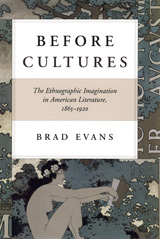 Before Cultures: The Ethnographic Imagination in American Literature, 1865-1920
Brad Evans
University of Chicago Press, 2005 The term culture in its anthropological sense did not enter the American lexicon with force until after 1910—more than a century after Herder began to use it in Germany and another thirty years after E. B. Tylor and Franz Boas made it the object of anthropological attention. Before Cultures explores this delay in the development of the culture concept and its relation to the description of difference in late nineteenth-century America.
In this work, Brad Evans weaves together the histories of American literature and anthropology. His study brings alive not only the regionalist and ethnographic fiction of the time but also revives a range of neglected materials, including the Zuni sketchbooks of anthropologist Frank Hamilton Cushing; popular magazines such as Century Illustrated Monthly, which published Cushing's articles alongside Henry James's; the debate between Joel Chandler Harris, author/collector of the Uncle Remus folktales, and John Wesley Powell, perhaps the most important American anthropologist of the time; and Du Bois's polemics against the culture concept as it was being developed in the early twentieth century.
Written with clarity and grace, Before Cultures will be of value to students of American literature, history, and anthropology alike.
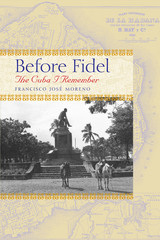 Before Fidel: The Cuba I Remember
By Francisco José Moreno
University of Texas Press, 2007 Before Fidel Castro seized power, Cuba was an ebullient and chaotic society in a permanent state of turmoil, combining a raucous tropical nature with the evils of arbitrary and corrupt government. Yet this fascinating period in Cuban history has been largely forgotten or misrepresented, even though it set the stage for Castro's dramatic takeover in 1959. To reclaim the Cuba that he knew—and add color and detail to the historical record—distinguished political scientist Francisco José Moreno here offers his recollections of the Cuba in which he came of age personally and politically. Moreno takes us into the little-known world of privileged, upper-middle-class, white Cubans of the 1930s through the 1950s. His vivid depictions of life in the family and on the streets capture the distinctive rhythms of Cuban society and the dynamics between parents and children, men and women, and people of different races and classes. The heart of the book describes Moreno's political awakening, which culminated during his student years at the University of Havana. Moreno gives a detailed, insider's account of the anti-Batista movement, including the Ortodoxos and the Triple A. He recaptures the idealism and naiveté of the movement, as well as its ultimate ineffectiveness as it fell before the juggernaut of the Castro Revolution. His own disillusionment and wrenching decision to leave Cuba rather than accept a commission in Castro's army poignantly closes the book.
 Before Grenfell: Fire, Safety and Deregulation in Twentieth-Century Britain
Shane Ewen
University of London Press, 2023 An account of the systemic failures that led to the Grenfell tower fire.
The 2017 Grenfell tower fire in London was a “slow disaster,” the product of a long accumulation of faults and errors that resulted from erroneous assumptions and organizational and governmental decision-making. This book offers a critical perspective on the systematic failures that lead to one of the greatest tragedies in Britain in our time.
Before Grenfell is a poignant and timely analysis of risk, fire, and safety in postwar Britain. Tracing the evolution of state housing policy in relation to multistory housing since the mid-1950s, the book adds to a burgeoning history of the British experience of fire and safety in high-rises and investigates a latent housing crisis in contemporary Britain against a backdrop of increasingly deregulated urban building development. Drawing on public inquiries, newspaper accounts, and oral histories, Shane Ewen details other avoidable disasters, including the Ronan Point tower block explosion in 1968, the Summerland leisure center fire in 1972, and the Bradford City Football Club fire in 1985. The book closes with a powerful chapter on fire safety campaigners, including survivor groups, who are seeking justice for the victims of fire disasters. Before Grenfell aims to exert pressure on policy-makers to act on the lessons of fatal disasters in order to both prevent future casualties and establish a legacy for those who lost their lives.
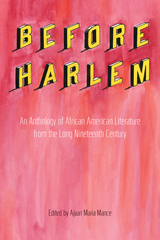 Before Harlem: An Anthology of African American Literature from the Long Nineteenth Century
Ajuan Maria Mance
University of Tennessee Press, 2016 Despite important recovery and authentication efforts during the last twenty-five years, the vast majority of nineteenth-century African American writers and their work remain unknown to today’s readers. Moreover, the most widely used anthologies of black writing have established a canon based largely on current interests and priorities. Seeking to establish a broader perspective, this collection brings together a wealth of autobiographical writings, fiction, poetry, speeches, sermons, essays, and journalism that better portrays the intellectual and cultural debates, social and political struggles, and community publications and institutions that nurtured black writers from the early 1800s to the eve of the Harlem Renaissance.
As editor Ajuan Mance notes, previous collections have focused mainly on writing that found a significant audience among white readers. Consequently, authors whose work appeared in African American–owned publications for a primarily black audience—such as Solomon G. Brown, Henrietta Cordelia Ray, and T. Thomas Fortune—have faded from memory. Even figures as celebrated as Frederick Douglass and Paul Laurence Dunbar are today much better known for their “cross-racial” writings than for the larger bodies of work they produced for a mostly African American readership. There has also been a tendency in modern canon making, especially in the genre of autobiography, to stress antebellum writing rather than writings produced after the Civil War and Reconstruction. Similarly, religious writings—despite the centrality of the church in the everyday lives of black readers and the interconnectedness of black spiritual and intellectual life—have not received the emphasis they deserve.
Filling those critical gaps with a selection of 143 works by 65 writers, Before Harlem presents as never before an in-depth picture of the literary, aesthetic, and intellectual landscape of nineteenth-century African America and will be a valuable resource for a new generation of readers.
Ajuan Maria Mance is a professor of English at Mills College in Oakland, California. She is the author of Inventing Black Women: African American Poets and Self-Representation, which was named a Choice Outstanding Academic Title. Her articles have appeared in the Journal of African American Studies, Callaloo, and several edited collections.
Before Homosexuality in the Arab-Islamic World, 1500-1800
Khaled El-Rouayheb
University of Chicago Press, 2005 Attitudes toward homosexuality in the pre-modern Arab-Islamic world are commonly depicted as schizophrenic—visible and tolerated on one hand, prohibited by Islam on the other. Khaled El-Rouayheb argues that this apparent paradox is based on the anachronistic assumption that homosexuality is a timeless, self-evident fact to which a particular culture reacts with some degree of tolerance or intolerance. Drawing on poetry, biographical literature, medicine, dream interpretation, and Islamic texts, he shows that the culture of the period lacked the concept of homosexuality.
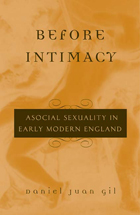 Before Intimacy: Asocial Sexuality in Early Modern England
Daniel Juan Gil
University of Minnesota Press, 2006 Before the eighteenth-century rise of the ideology of intimacy, sexuality was defined not by social affiliations but by bodies. In Before Intimacy, Daniel Juan Gil examines sixteenth-century English literary concepts of sexuality that frame erotic ties as neither bound by social customs nor transgressive of them, but rather as “loopholes” in people’s experiences and associations.
Engaging the poems of Wyatt, Sidney’s Astrophil and Stella, Spenser’s Amoretti and The Faerie Queene, and Shakespeare’s Troilus and Cressida and the Sonnets, Gil demonstrates how sexuality was conceived as a relationship system inhabited by men and women interchangeably—set apart from the “norm” and not institutionalized in a private or domestic realm. Going beyond the sodomy-as-transgression analytic, he asserts the existence of socially inconsequential sexual bonds while recognizing the pleasurable effects of violating the supposed traditional modes of bonding and ideals of universal humanity and social hierarchy.
Celebrating the ability of corporeal emotions to interpret connections between people who share nothing in terms of societal structure, Before Intimacy shows how these works of early modern literature provide a discourse of sexuality that strives to understand status differences in erotic contexts and thereby question key assumptions of modernity.
Daniel Juan Gil is assistant professor of English at TCU.
Before It All Ends: Breathless Sonnets
Roger Armbrust
Parkhurst Brothers, Inc., 2022 Armbrust writes sonnets on a variety of themes, primarily addressed to his muse and his lovers. Since 1979, when his first book of poetry went to press, he continues to write, as if he opens a vein to pour his own blood onto the page to do it.
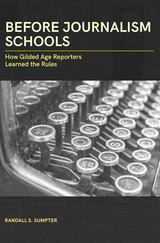 Before Journalism Schools: How Gilded Age Reporters Learned the Rules
Randall S. Sumpter
University of Missouri Press, 2018 Randall Sumpter questions the dominant notion that reporters entering the field in the late nineteenth century relied on an informal apprenticeship system to learn the rules of journalism. Drawing from the experiences of more than fifty reporters, he argues that cub reporters could and did access multiple sources of instruction, including autobiographies and memoirs of journalists, fiction, guidebooks, and trade magazines. Arguments for “professional journalism” did not resonate with the workaday journalists examined here. These news workers were more concerned with following a personal rather than a professional code of ethics, and implemented their own work rules. Some of those rules governed “delinquent” behavior. While scholars have traced some of the connections between beginning journalists and learning opportunities, Sumpter shows that much more can be discovered, with implications for understanding the development of journalistic professionalism and present-day instances of journalistic behavior.
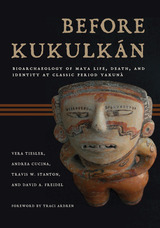 Before Kukulkán: Bioarchaeology of Maya Life, Death, and Identity at Classic Period Yaxuná
Vera Tiesler, Andrea Cucina, Travis W. Stanton, and David A. Freidel; Foreword by Traci Ardren
University of Arizona Press, 2017 This volume illuminates human lifeways in the northern Maya lowlands prior to the rise of Chichén Itzá. This period and area have been poorly understood on their own terms, obscured by scholarly focus on the central lowland Maya kingdoms. Before Kukulkán is anchored in three decades of interdisciplinary research at the Classic Maya capital of Yaxuná, located at a contentious crossroads of the northern Maya lowlands.
Using bioarchaeology, mortuary archaeology, and culturally sensitive mainstream archaeology, the authors create an in-depth regional understanding while also laying out broader ways of learning about the Maya past. Part 1 examines ancient lifeways among the Maya at Yaxuná, while part 2 explores different meanings of dying and cycling at the settlement and beyond: ancestral practices, royal entombment and desecration, and human sacrifice. The authors close with a discussion of the last years of occupation at Yaxuná and the role of Chichén Itzá in the abandonment of this urban center.
Before Kukulkán provides a cohesive synthesis of the evolving roles and collective identities of locals and foreigners at the settlement and their involvement in the region’s trajectory. Theoretically informed and contextualized discussions offer unique glimpses of everyday life and death in the socially fluid Maya city. These findings, in conjunction with other documented series of skeletal remains from this region, provide a nuanced picture of the social and biocultural dynamics that operated successfully for centuries before the arrival of the Itzá.
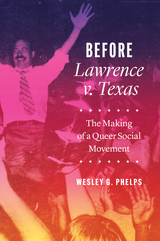 Before Lawrence v. Texas: The Making of a Queer Social Movement
Wesley G. Phelps
University of Texas Press, 2022 2024 Coral Horton Tullis Memorial Prize, Texas State Historical Association
2024 Award of Merit, The Philosophical Society of Texas Nonfiction Book Prize The grassroots queer activism and legal challenges that led to a landmark Supreme Court decision in favor of gay and lesbian equality. In 2003 the US Supreme Court overturned anti-sodomy laws across the country, ruling in Lawrence v. Texas that the Constitution protects private consensual sex between adults. To some, the decision seemed to come like lightning from above, altering the landscape of America’s sexual politics all at once. In actuality, many years of work and organizing led up to the legal case, and the landmark ruling might never have happened were it not for the passionate struggle of Texans who rejected their state’s discriminatory laws. Before Lawrence v. Texas tells the story of the long, troubled, and ultimately hopeful road to constitutional change. Wesley G. Phelps describes the achievements, setbacks, and unlikely alliances along the way. Over the course of decades, and at great risk to themselves, gay and lesbian Texans and their supporters launched political campaigns and legal challenges, laying the groundwork for Lawrence. Phelps shares the personal experiences of the people and couples who contributed to the legal strategy that ultimately overturned the state’s discriminatory law. Even when their individual court cases were unsuccessful, justice seekers and activists collectively influenced public opinion by insisting that their voices be heard. Nine Supreme Court justices ruled, but it was grassroots politics that vindicated the ideal of equality under the law.
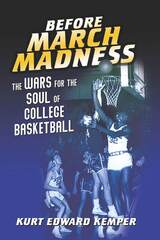 Before March Madness: The Wars for the Soul of College Basketball
Kurt Edward Kemper
University of Illinois Press, 2020 Big money NCAA basketball had its origins in a many-sided conflict of visions and agendas. On one side stood large schools focused on a commercialized game that privileged wins and profits. Opposing them was a tenuous alliance of liberal arts colleges, historically black colleges, and regional state universities, and the competing interests of the NAIA, each with distinct interests of their own. Kurt Edward Kemper tells the dramatic story of the clashes that shook college basketball at mid-century—and how the repercussions continue to influence college sports to the present day. Taking readers inside the competing factions, he details why historically black colleges and regional schools came to embrace commercialization. As he shows, the NCAA's strategy of co-opting its opponents gave each group just enough just enough to play along—while the victory of the big-time athletics model handed the organization the power to seize control of college sports. An innovative history of an overlooked era, Before March Madness looks at how promises, power, and money laid the groundwork for an American sports institution.
Before Mickey: The Animated Film 1898-1928
Donald Crafton
University of Chicago Press, 1993 An engaging account of the largely forgotten world of early animated films from Hollywood and beyond
This witty and fascinating study reminds us that there was animation before Disney: about thirty years of creativity and experimentation flourishing in such extraordinary work as Gertiethe Dinosaur and Felix the Cat. Before Mickey, the first in-depth history of animation from the turn of the century until the debut of Disney, includes accounts of mechanical ingenuity, marketing, and art. Donald Crafton is equally adept at explaining techniques of sketching and camera work, evoking characteristic styles of such pioneering animators as Winsor McCay and Ladislas Starevitch, placing work in its social and economic context, and unraveling the aesthetic impact of specific cartoons.
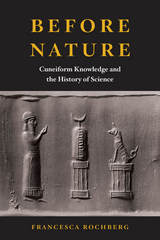 Before Nature: Cuneiform Knowledge and the History of Science
Francesca Rochberg
University of Chicago Press, 2016 In the modern West, we take for granted that what we call the “natural world” confronts us all and always has—but Before Nature explores that almost unimaginable time when there was no such conception of “nature”—no word, reference, or sense for it.
Before the concept of nature formed over the long history of European philosophy and science, our ancestors in ancient Assyria and Babylonia developed an inquiry into the world in a way that is kindred to our modern science. With Before Nature, Francesca Rochberg explores that Assyro-Babylonian knowledge tradition and shows how it relates to the entire history of science. From a modern, Western perspective, a world not conceived somehow within the framework of physical nature is difficult—if not impossible—to imagine. Yet, as Rochberg lays out, ancient investigations of regularity and irregularity, norms and anomalies clearly established an axis of knowledge between the knower and an intelligible, ordered world. Rochberg is the first scholar to make a case for how exactly we can understand cuneiform knowledge, observation, prediction, and explanation in relation to science—without recourse to later ideas of nature. Systematically examining the whole of Mesopotamian science with a distinctive historical and methodological approach, Before Nature will open up surprising new pathways for studying the history of science.
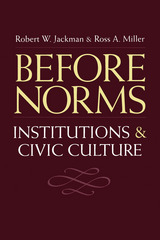 Before Norms: Institutions and Civic Culture
Robert W. Jackman and Ross A. Miller
University of Michigan Press, 2005
The potato famines of the nineteenth century were long attributed to Irish indolence. The Stalinist system was blamed on a Russian proclivity for autocracy. Muslim men have been accused of an inclination to terrorism. Is political behavior really the result of cultural upbringing, or does the vast range of human political action stem more from institutional and structural constraints?
This important new book carefully examines the role of institutions and civic culture in the establishment of political norms. Jackman and Miller methodically refute the Weberian cultural theory of politics and build in its place a persuasive case for the ways in which institutions shape the political behavior of ordinary citizens. Their rigorous examination of grassroots electoral participation reveals no evidence for even a residual effect of cultural values on political behavior, but instead provides consistent support for the institutional view. Before Norms speaks to urgent debates among political scientists and sociologists over the origins of individual political behavior.
Robert W. Jackman is Professor of Political Science at the University of California, Davis. Ross A. Miller is Associate Professor of Political Science at Santa Clara University.
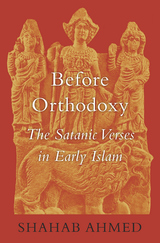 Before Orthodoxy: The Satanic Verses in Early Islam
Shahab Ahmed
Harvard University Press, 2017 One of the most controversial episodes in the life of the Prophet Muhammad concerns an incident in which he allegedly mistook words suggested by Satan as divine revelation. Known as the Satanic verses, these praises to the pagan deities contradict the Islamic belief that Allah is one and absolute. Muslims today—of all sects—deny that the incident of the Satanic verses took place. But as Shahab Ahmed explains, Muslims did not always hold this view.
Before Orthodoxy wrestles with the question of how religions establish truth—especially religions such as Islam that lack a centralized authority to codify beliefs. Taking the now universally rejected incident of the Satanic verses as a case study in the formation of Islamic orthodoxy, Ahmed shows that early Muslims, circa 632 to 800 CE, held the exact opposite belief. For them, the Satanic verses were an established fact in the history of the Prophet. Ahmed offers a detailed account of the attitudes of Muslims to the Satanic verses in the first two centuries of Islam and traces the chains of transmission in the historical reports known as riwāyah.
Touching directly on the nature of Muhammad’s prophetic visions, the interpretation of the Satanic verses incident is a question of profound importance in Islam, one that plays a role in defining the limits of what Muslims may legitimately say and do—issues crucial to understanding the contemporary Islamic world.
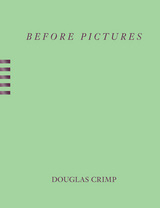 Before Pictures
Douglas Crimp
University of Chicago Press, 2016 Douglas Crimp is the rare art critic whose work profoundly influenced a generation of artists. He is best known for his work with the “Pictures Generation”—the very name of which Crimp coined to define the work of artists like Robert Longo and Cindy Sherman who appropriated images from mass culture to carry out a subversive critique. But while his influence is widely recognized, we know little about Crimp’s own formative experiences before “Pictures.”
Before Pictures tells the story of Crimp’s life as a young gay man and art critic in New York City during the late 1960s through the turbulent 1970s. Crimp participated in all of what made the city so stimulating in that vibrant decade. The details of his professional and personal life are interwoven with this the particularly rich history of New York City at that time, producing a vivid portrait of both the critic and his adopted city. The book begins with his escape from his hometown in Idaho, and we quickly find Crimp writing criticism for ArtNews while working at the Guggenheim—where, as a young curatorial assistant, he was one of the few to see Daniel Buren’s Peinture-Sculpture before it was removed amid cries of institutional censorship. We also travel to the Chelsea Hotel (where Crimp helped the down-on-his-luck couturier Charles James organize his papers) through to his days as a cinephile and balletomane to the founding of the art journal October, where he remained a central figure for many years. As he was developing his reputation as a critic, he was also partaking of the New York night life, from drugs and late nights alongside the Warhol crowd at the Max’s Kansas City to discos, roller-skating, and casual sex with famous (and not-so-famous) men. As AIDS began to ravage the closely linked art and gay communities, Crimp eventually turned his attention to activism dedicated to rethinking AIDS.
Part biography and part cultural history, Before Pictures is a courageous account of an exceptional period in both Crimp’s life and the life of New York City. At the same time, it offers a deeply personal and engaging point of entry into important issues in contemporary art.
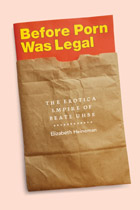 Before Porn Was Legal: The Erotica Empire of Beate Uhse
Elizabeth Heineman
University of Chicago Press, 2011 Struggling to survive in post–World War II Germany, Beate Uhse (1919–2001)—a former Luftwaffe pilot, war widow, and young mother—turned to selling goods on the black market. A self-penned guide to the rhythm method found eager buyers and started Uhse on her path to becoming the world’s largest erotica entrepreneur. Battling restrictive legislation, powerful churches, and conservative social mores, she built a mail-order business in the 1950s that sold condoms, sex aids, self-help books, and more. The following decades brought the world’s first erotica shop, the legalization of pornography, the expansion of her business into eastern Germany, and web-based commerce.
Uhse was only one of many erotica entrepreneurs who played a role in the social and sexual revolution accompanying Germany’s transition from Nazism to liberal democracy. Tracing the activities of entrepreneurs, customers, government officials, and citizen-activists, Before Porn Was Legal brings to light the profound social, legal, and cultural changes that attended the growth of the erotica sector. Heineman’s innovative readings of governmental and industry records, oral histories, and the erotica industry’s products uncover the roots of today’s sexual marketplace and reveal the indelible ways in which sexual expression and consumption have become intertwined.
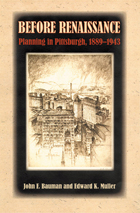 Before Renaissance: Planning in Pittsburgh, 1889-1943
John F. Bauman
University of Pittsburgh Press, 2006
Before Renaissance examines a half-century epoch during which planners, public officials, and civic leaders engaged in a dialogue about the meaning of planning and its application for improving life in Pittsburgh.
Planning emerged from the concerns of progressive reformers and businessmen over the social and physical problems of the city. In the Steel City enlightened planners such as Frederick Law Olmsted, Jr., and Frederick Bigger pioneered the practical approach to reordering the chaotic urban-industrial landscape. In the face of obstacles that included the embedded tradition of privatism, rugged topography, inherited built environment, and chronic political fragmentation, they established a tradition of modern planning in Pittsburgh.
Over the years a mélange of other distinguished local and national figures joined in the planning dialogue, among them the park founder Edward Bigelow, political bosses Christopher Magee and William Flinn, mayors George Guthrie and William Magee, industrialists Andrew Carnegie and Howard Heinz, financier Richard King Mellon, and planning luminaries Charles Mulford Robinson, Frederick Law Olmsted Jr., Harland Bartholomew, Robert Moses, and Pittsburgh’s Frederick Bigger. The famed alliance of Richard King Mellon and Mayor David Lawrence, which heralded the Renaissance, owed a great debt to Pittsburgh’s prior planning experience.
John Bauman and Edward Muller recount the city’s long tradition of public/private partnerships as an important factor in the pursuit of orderly and stable urban growth. Before Renaissance provides insights into the major themes, benchmarks, successes, and limitations that marked the formative days of urban planning. It defines Pittsburgh’s key role in the vanguard of the national movement and reveals the individuals and processes that impacted the physical shape and form of a city for generations to come.
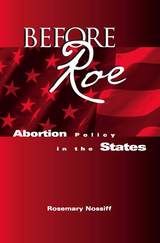 Before Roe: Abortion Policy in the States
Rosemary Nossiff
Temple University Press, 2000 Few issues in contemporary U.S> politics have remained on the public agenda so long and so divisively as abortion policy. The landmark Supreme Court decision of Roe v. Waade, which held that laws prohibiting first trimester abortions were illegal because they violated a woman's right to privacy, still generates heated controversy today, a quarter of a century after it was made. The seeds of that controversy were sown in the seven years immediately preceding Roe, when state legislatures tried to reconcile religious opposition to abortion and individuals' civil liberties.
In this groundbreaking book, Rosemary Nossiff examines the force that shaped abortion policy during those years, and the ways in which states responded to them. To provide in-depth analysis while still looking broadly at the picture, she studies New York, which passed the most permissive abortion bill in the country, and Pennsylvania, which passed one of the most restrictive. That these two states, which share similar demographic, political, and economic characteristics, should reach two such different outcomes provides a perfect case study for observing political dynamics at the state level.
Nossiff examines the medical, religious, and legal discourses employed on both sides of the debate, as well as the role played by feminist discourse. She looks at the role of the political parties in the campaigns, as well as such interest groups as the National Council of Catholic Bishops, the Clergy Consultation Service, the National Organization for Women, and the National Association for the Repeal of Abortion Laws. In addition, she analyzes the strategies used by both sides, as well as partisan and institutionalized developments that facilitated success or failure. Finally, in the Epilogue, she assesses the Roe decision and its aftermath, including an analysis of the pro-life movement in Pennsylvania.
As the author remarks, "Without question people's positions on abortion are shaped by a myriad of social, moral, and economic factors. But ultimately abortion policy is shaped in the political arena. This book examines how one of the most intimate decisions a woman makes, whether to continue or terminate a pregnancy, has become one of the most politicized issues in contemporary American politics.
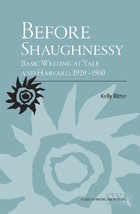 Before Shaughnessy: Basic Writing at Yale and Harvard, 1920-1960
Kelly Ritter
Southern Illinois University Press, 2009 In Before Shaughnessy: Basic Writing at Yale and Harvard, 1920–1960, Kelly Ritter uses materials from the archives at Harvard and Yale and contemporary theories of writing instruction to reconsider the definition of basic writing and basic writers within a socio-historical context. Ritter challenges the association of basic writing with only poorly funded institutions and poorly prepared students. Using Yale and Harvard as two sample case studies, Ritter shows that basic writing courses were alive and well, even in the Ivy League, in the early twentieth century. She argues not only that basic writers exist across institutional types and diverse student populations, but that the prevalence of these writers has existed far more historically than we generally acknowledge. Uncovering this forgotten history of basic writing at elite institutions, Ritter contends that the politics and problems of the identification and the definition of basic writers and basic writing began long before the work of Mina Shaughnessy in Errors and Expectations and the rise of open admissions. Indeed, she illustrates how the problems and politics have been with us since the advent of English A at Harvard and the heightened consumer-based policies that resulted in the new admissions criteria of the early twentieth-century American university. In order to recognize this long-standing reality of basic writing, we must now reconsider whether the nearly standardized, nationalized definition of “basic” is any longer a beneficial one for the positive growth and democratic development of our first-year writing programs and students.
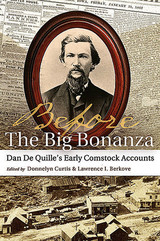 Before THE BIG BONANZA: Dan De Quille's Early Comstock Accounts
Edited by Donnelyn Curtis and Lawrence I. Berkove
University of Missouri Press, 2015
The discovery and mining of the Comstock Lode in Nevada forever changed the mining culture of the American West. Using the pen name Dan De Quille, in 1876 William Wright published The Big Bonanza, the best-known contemporary account of the Comstock Lode mines. Previously, however, in nearly fifty newspaper accounts from 1860 to 1863, De Quille had documented the development of the early Comstock with a frankness, abundance of detail, sense of immediacy, and excitement largely absent from his book. Donnelyn Curtis and Lawrence I. Berkove have gathered those accounts together in Before The Big Bonanza.
De Quille describes the amazing transformation of the Comstock in less than four years from miscellaneous tent camps and primitive mining sites to an incredible complex of underground shafts and tunnels beneath a group of wealth-producing cities, with modern buildings, state-of-the-art mills, orderly streets, and traffic jams. He captures the vitality of the inhabitants' resolution and resourcefulness as they survive destructive storms and being cut off from supplies and entertainment, and he chronicles the events that kept Nevada and California in the Union. While reporting the prevailing violence of brawling and dueling and anti-Indian prejudice, De Quille at the same time conveys his thoughtful observations on the significance to democracy and civilization of the existence of such license.
This trove of columns, collected from a variety of newspapers, is history in the making and additionally casts new light on the life and rapidly developing art of De Quille, the biographer of the Comstock and one of the most versatile and accomplished authors of the Old West.
 Before the Closet: Same-Sex Love from "Beowulf" to "Angels in America"
Allen J. Frantzen
University of Chicago Press, 1998 Allen J. Frantzen challenges the long accepted view that the early Middle Ages tolerated and even fostered same-sex relations and that intolerance of homosexuality developed only late in the medieval period. Frantzen shows that in early medieval Europe, the Church did not tolerate same-sex acts, in fact it was an age before people recognized the existence—or the possibility—of the "closet."
With its ambitious scope and elegant style, Before the Closet sets same-sex relations in Anglo-Saxon sources in relation to the sexual themes of contemporary opera, dance, and theatre. Frantzen offers a comprehensive analysis of sources from the seventh to the twelfth century and traces Anglo-Saxon same-sex behavior through the age of Chaucer and into the Renaissance.
"Frantzen's marvelous book . . . opens up a world most readers will never have even known was there. It's a difficult topic, but Frantzen's comprehensive, readable and even wryly funny treatment makes this an unexpected pleasure."—Publishers Weekly, starred review
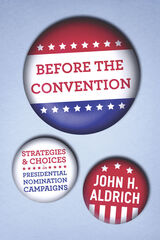 Before the Convention: Strategies and Choices in Presidential Nomination Campaigns
John H. Aldrich
University of Chicago Press, 1980 Campaigns to win the Democratic and Republican presidential nominations are longer, more complex, and more confusing to the observer than the general election itself. The maze of delegate-selection procedures includes state primaries and caucuses as well as the traditional "smoke-filled room." Complicated federal election laws govern campaign financing. Sometimes many candidates enter and drop out of the race, while sometimes a stable two-way contest occurs: the 1976 nomination campaigns of Jimmy Carter and Gerald Ford exemplified each extreme. Is it possible to propose general principles to explain the apparent chaos of our presidential nomination system? Can those principles account for two such starkly different campaigns as occurred in 1976? In Before the Convention, political scientist John H. Aldrich presents a systematic analysis of presidential nomination politics, based on application of rational-choice models to candidate behavior. Aldrich views the candidates as decision makers with limited resources in a highly competitive environment. From this perspective, he seeks to determine why and how candidates choose to run, why some succeed and others fail, and what consequences the nomination process has for the general election and, later, for the President in office.
Aldrich begins with a brief history of the presidential selection process, focusing on the continuing shift of power from political elites to the mass electorate. He then turns to a detailed analysis of the 1976 nomination campaigns. Using data from a variety of sources, Aldrich demonstrates that the very different patterns in these races both conform to the rational-choice model. The analysis includes consideration of numerous questions of strategy. Is there a "momentum" to campaigns? How does a candidate identify and exploit this intangible quality? How do candidates decide where to contend and where not to contend? What is the nature of policy competition among candidates? When does a candidate prefer a "fuzzy" position to a clearly stated one? Other topics include reforms in campaign financing and the expanded and changed role of news coverage.
Before the Convention fills a significant gap in the literature on presidential politics, and therefore should be of particular importance to specialists in this area. It will be ofinterest also to everyone who is concerned with understanding the "rules of the game" for a complicated but vitally important exercise of American democracy.
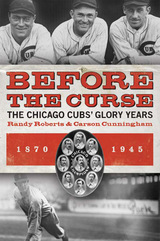 Before the Curse: The Chicago Cubs' Glory Years, 1870-1945
Edited by Randy Roberts and Carson Cunningham
University of Illinois Press, 2012 Before the Curse: The Chicago Cubs' Glory Years, 1870–1945 brings to life the early history of the much beloved and often heartbreaking Chicago Cubs. Originally called the Chicago White Stockings, the team immediately established itself as a powerhouse, winning the newly formed National Base Ball League's inaugural pennant in 1876, repeating the feat in 1880 and 1881, and commanding the league in the decades to come. The legendary days of the Cubs are recaptured here in more than two dozen vintage newspaper accounts and historical essays on the teams and the fans who loved them. The great games, pennant races, and series are all here, including the 1906 World Series between the Cubs and Chicago White Sox. Of course, Before the Curse remembers the hall-of-fame players--Grover Cleveland Alexander, Gabby Hartnett, Roger Hornsby, Dizzy Dean--who delighted Cubs fans with their play on the field and their antics elsewhere. Through stimulating introductions to each article, Randy Roberts and Carson Cunningham demonstrate how changes in ownership affected the success of the team, who the teams' major players were both on and off the field, and how regular fans, owners, players, journalists, and Chicagoans of the past talked and wrote about baseball.
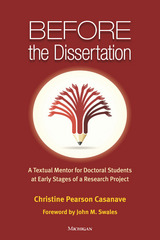 Before the Dissertation: A Textual Mentor for Doctoral Students at Early Stages of a Research Project
Christine Pearson Casanave
University of Michigan Press, 2014 “This very readable book is what every graduate student needs as they start a program. I wish my own MA and PhD students, during my 40 years of supervising, could have been demystified by having Casanave's ‘textual mentor' as a companion." --Merrill Swain, Professor Emerita, OISE, University of Toronto “Before the Dissertation is an insightful, relevant, and accessible resource for doctoral students at any stage. Full of reflections and advice not found in other books, it serves as an indispensable guide for students and their supervisors. And the dispelling of myths is a superb idea!” --Robert Kohls, PhD candidate, University of Toronto
Before the Dissertation concerns issues to consider before students start writing, indeed before they commit to a major high-stakes dissertation project, whether qualitative or quantitative or something in between. It is especially relevant for students who wish to do projects that involve a lengthy research period (which can add to stress), and that also involve reading, data collection, and writing in more than one language. From the earliest stages of doctoral work, even before the proposal stage, and during intermediate stages of preparation for a project as well, there are things to think about and discuss with friends, family, and advisers such as: Why do you want to pursue a doctoral degree? Do you fully understand what you are getting into? How will you manage to develop an appropriate topic? What will your role be in your project and what languages will you use with multilingual participants? How might you engage with reading, people, and personal writing at early stages in ways that will contribute to your project's development? How much attention should you pay to quality-of-life issues?
Before the Dissertation speaks to an audience in the social sciences, but in particular to doctoral students who have experience with and interest in international, multilingual, as well as native English speaking students and settings and who wish to investigate topics in (second) language and multicultural-transcultural education. Athough appropriate for use in English-dominant doctoral programs throughout the world, the book will relate more closely to students in the North American educational system than to ones, for example, in the British system. The main audience for this book is thus doctoral students who are first or second/additional users of English, who are interested in pursuing topics in one of the social sciences, including education and multilingual inquiry, and who may just be finishing course work in an English-dominant university and are wondering what might happen next.
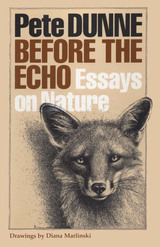 Before the Echo: Essays on Nature
By Pete Dunne
University of Texas Press, 1995 "The natural world is a lot like a game of musical chairs," observes Pete Dunne. "Everywhere you turn, everywhere you go, there are places where living things sit down, niches that support their specific needs. But just as in musical chairs, there aren't enough places to go around. Our species keeps removing them—forcing other creatures to leave the game." In these twenty-nine essays, one of America's top nature writers trains his sights on the beauties and the vulnerabilities of the natural world. Writing to infuse others with a sense of the richness and diversity that nature holds, Pete Dunne ranges over topics from the wonder of the year's first snowfall to the lost art of stargazing to the mysterious forces that impel people to hunt—and not to hunt. Running like a thread through all the essays is Dunne's desire to preserve all that is "natural" in nature, to stop our unthinking destruction of wild places and wild creatures before we humans find ourselves with "the last chair, in an empty room" on an impoverished earth.
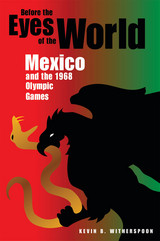 Before the Eyes of the World: Mexico and the 1968 Olympic Games
Kevin B. Witherspoon
Northern Illinois University Press, 2013
Mexican leaders eagerly anticipated the attention that hosting the world’s most visible sporting event would bring, yet they could not have predicted the array of conflicts that would play out before the eyes of the world during the notorious 1968 Mexico City Olympics. Following 20 years of economic growth and political stability—known as the “Mexican miracle”—Mexican policy makers escaped their prior image of being economically underdeveloped to successfully craft an image of a nation that was both modern and cosmopolitan but also steeped in culture and tradition. Buoyed by this new image, they set their sights on the Olympic bid, and they not only won but also prepared impressive facilities.
Prior to the opening ceremonies, several controversies emerged, the most glaring of which was a student protest movement that culminated in a public massacre, leaving several hundred students dead. Less dramatic were concerns that athletes would suffer harm in the high elevation and thin air, debates over the nature of amateurism, threats by nations opposing apartheid to boycott if South Africa was allowed to compete, and the introduction of drug and gender testing. Additionally the Olympics provided a forum for the United States and the Soviet Union to carry their Cold War rivalry to the playing field—a way to achieve victory without world destruction at stake.
During the Games, one of the most significant controversies occurred when two African American athletes, Tommie Smith and John Carlos, raised their fists in the Black Power salute while on the medal stand. This gesture brought worldwide attention to racism within the United States and remains a lasting image of both the Mexico City Olympics and the Civil Rights movement. Although the Olympics are intended to bring athletes of the world together for harmonious competition, the 1968 Games will long be remembered as fraught with discord. This ambitious and comprehensive study will appeal to those interested in U.S. history, Latin American history, sports history, and Olympic history.
 Before the Fire Dogs Steal the Sun: An Elegy
Crystal Mun-hye Baik
Duke University Press, 2026 In Before the Fire Dogs Steal the Sun, Crystal Mun-hye Baik offers an intimate cultural history of war, illness, banishment, and estrangement through the experiential lens of her family. Beginning with her father's death and mother's psychiatric hold in 2022, Baik situates her parents’ lives within the enmeshed narratives of Japanese colonialism, war, and transoceanic migration, examining Korean diasporic grief as a felt form of thinking and writing, rather than an object of study. In doing so, she reckons with diasporic genealogies of precarity that have configured the everyday lives of her parents and ancestral communities. Blending different genres from narrative prose to visual essay, epistles to ancestral mourning rites, Before the Fire Dogs Steal the Sun is a meditation on the personal and ethical entanglements scholars must confront when they are implicated in the histories of violence they study.
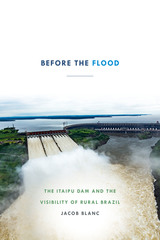 Before the Flood: The Itaipu Dam and the Visibility of Rural Brazil
Jacob Blanc
Duke University Press, 2019 In Before the Flood Jacob Blanc traces the protest movements of rural Brazilians living in the shadow of the Itaipu dam—the largest producer of hydroelectric power in the world. In the 1970s and 1980s, local communities facing displacement took a stand against the military officials overseeing the dam's construction, and in the context of an emerging national fight for democracy, they elevated their struggle for land into a referendum on the dictatorship itself. Unlike the broader campaign against military rule, however, the conflict at Itaipu was premised on issues that long predated the official start of dictatorship: access to land, the defense of rural and indigenous livelihoods, and political rights in the countryside. In their efforts against Itaipu and through conflicts among themselves, title-owning farmers, landless peasants, and the Avá-Guarani Indians articulated a rural-based vision for democracy. Through interviews and archival research—including declassified military documents and the first-ever access to the Itaipu Binational Corporation—Before the Flood challenges the primacy of urban-focused narratives and unearths the rural experiences of dictatorship and democracy in Brazil.
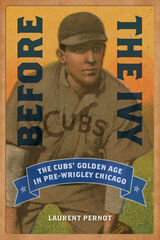 Before the Ivy: The Cubs' Golden Age in Pre-Wrigley Chicago
Laurent Pernot
University of Illinois Press, 2015 All Cub fans know from heartbreak and curse-toting goats. Fewer know that, prior to moving to the north side in 1916, the team fielded powerhouse nines that regularly claimed the pennant. Before the Ivy offers a grandstand seat to a golden age: BEHOLD the 1871 team as it plays for the title in nine different borrowed uniforms after losing everything in the Great Chicago Fire ATTEND West Side Grounds at Polk and Wolcott with its barbershop quartet MARVEL as superstar Cap Anson hits .399, makes extra cash running a ballpark ice rink, and strikes out as an elected official WONDER at experiments with square bats and corked balls, the scandal of Sunday games and pre-game booze-ups, the brazen spitters and park dimensions changed to foil Ty Cobb RAZZ Charles Comiskey as he adopts a Cubs hand-me-down moniker for his team's name THRILL to the poetic double-play combo of Tinker, Evers, and Chance even as they throw tantrums at umpires and punches at each other CHEER as Merkle's Boner and the Cubs' ensuing theatrics send the team to the 1908 World Series Rich with Hall of Fame personalities and oddball stories, Before the Ivy opens a door to Chicago's own field of dreams and serves as every Cub fan's guide to a time when thoughts of "next year" filled rival teams with dread.
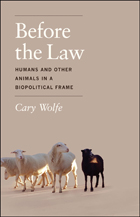 Before the Law: Humans and Other Animals in a Biopolitical Frame
Cary Wolfe
University of Chicago Press, 2012 Animal studies and biopolitics are two of the most dynamic areas of interdisciplinary scholarship, but until now, they have had little to say to each other. Bringing these two emergent areas of thought into direct conversation in Before the Law, Cary Wolfe fosters a new discussion about the status of nonhuman animals and the shared plight of humans and animals under biopolitics. Wolfe argues that the human-animal distinction must be supplemented with the central distinction of biopolitics: the difference between those animals that are members of a community and those that are deemed killable but not murderable. From this understanding, we can begin to make sense of the fact that this distinction prevails within both the human and animal domains and address such difficult issues as why we afford some animals unprecedented levels of care and recognition while subjecting others to unparalleled forms of brutality and exploitation. Engaging with many major figures in biopolitical thought—from Heidegger, Arendt, and Foucault to Agamben, Esposito, and Derrida—Wolfe explores how biopolitics can help us understand both the ethical and political dimensions of the current questions surrounding the rights of animals.
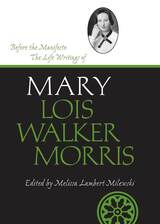 Before the Manifesto: The Life Writings of Mary Lois Walker Morris
Melissa Lambert Milewski
Utah State University Press, 2007 Mary Lois Walker Morris was a Mormon woman who challenged both American ideas about marriage and the U.S. legal system. Before the Manifesto provides a glimpse into her world as the polygamous wife of a prominent Salt Lake City businessman, during a time of great transition in Utah. This account of her life as a convert, milliner, active community member, mother, and wife begins in England, where her family joined the Mormon church, details her journey across the plains, and describes life in Utah in the 1880s. Her experiences were unusual as, following her first husband's deathbed request, she married his brother, as a plural wife, in the Old Testament tradition of levirate marriage.
Mary Morris's memoir frames her 1879 to 1887 diary with both reflections on earlier years and passages that parallel entries in the day book, giving readers a better understanding of how she retrospectively saw her life. The thoroughly annotated diary offers the daily experience of a woman who kept a largely self-sufficient household, had a wide social network, ran her own business, wrote poetry, and was intellectually curious. The years of "the Raid" (federal prosecution of polygamists) led Mary and Elias Morris to hide their marriage on "the underground," and her to perjury in court during Elias's trial for unlawful cohabitation. The book ends with Mary Lois's arrival at the Salt Lake Depot after three years in exile in Mexico with a polygamist colony.
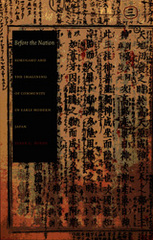 Before the Nation: Kokugaku and the Imagining of Community in Early Modern Japan
Susan L. Burns
Duke University Press, 2003 Exploring the emergence and evolution of theories of nationhood that continue to be evoked in present-day Japan, Susan L. Burns provides a close examination of the late-eighteenth-century intellectual movement kokugaku, which means "the study of our country.” Departing from earlier studies of kokugaku that focused on intellectuals whose work has been valorized by modern scholars, Burns seeks to recover the multiple ways "Japan" as social and cultural identity began to be imagined before modernity. Central to Burns's analysis is Motoori Norinaga’s Kojikiden, arguably the most important intellectual work of Japan's early modern period. Burns situates the Kojikiden as one in a series of attempts to analyze and interpret the mythohistories dating from the early eighth century, the Kojiki and Nihon shoki. Norinaga saw these texts as keys to an original, authentic, and idyllic Japan that existed before being tainted by "flawed" foreign influences, notably Confucianism and Buddhism. Hailed in the nineteenth century as the begetter of a new national consciousness, Norinaga's Kojikiden was later condemned by some as a source of Japan's twentieth-century descent into militarism, war, and defeat. Burns looks in depth at three kokugaku writers—Ueda Akinari, Fujitani Mitsue, and Tachibana Moribe—who contested Norinaga's interpretations and produced competing readings of the mythohistories that offered new theories of community as the basis for Japanese social and cultural identity. Though relegated to the footnotes by a later generation of scholars, these writers were quite influential in their day, and by recovering their arguments, Burns reveals kokugaku as a complex debate—involving history, language, and subjectivity—with repercussions extending well into the modern era.
 Before the Revolution: America's Ancient Pasts
Daniel K. Richter
Harvard University Press, 2011 America began, we are often told, with the Founding Fathers, the men who waged a revolution and created a unique place called the United States. We may acknowledge the early Jamestown and Puritan colonists and mourn the dispossession of Native Americans, but we rarely grapple with the complexity of the nation’s pre-revolutionary past. In this pathbreaking revision, Daniel Richter shows that the United States has a much deeper history than is apparent—that far from beginning with a clean slate, it is a nation with multiple pasts that stretch back as far as the Middle Ages, pasts whose legacies continue to shape the present.
Exploring a vast range of original sources, Before the Revolution spans more than seven centuries and ranges across North America, Europe, and Africa. Richter recovers the lives of a stunning array of peoples—Indians, Spaniards, French, Dutch, Africans, English—as they struggled with one another and with their own people for control of land and resources. Their struggles occurred in a global context and built upon the remains of what came before. Gradually and unpredictably, distinctive patterns of North American culture took shape on a continent where no one yet imagined there would be nations called the United States, Canada, or Mexico.
By seeing these trajectories on their own dynamic terms, rather than merely as a prelude to independence, Richter’s epic vision reveals the deepest origins of American history.
Before the Storm: A Year in the Pribilof Islands, 1941-1942
Fredericka Martin
University of Alaska Press, 2010 From June of 1941 through the following summer, Fredericka Martin lived with her husband, Dr. Samuel Berenberg, on remote St. Paul Island in Alaska. During that time, Martin delved into the complex history of the Unangan people, and Before the Storm draws from her personal accounts of that year and her research to present a fascinating portrait of a time and a people facing radical change. A government-ordered evacuation of all Aleuts from the island in the face of World War II, which Martin recounts in her journal, proved but the first step in a long struggle by native peoples to gain independence, and, as editor Raymond L. Hudson explains, Martin came to play a significant role in the effort.
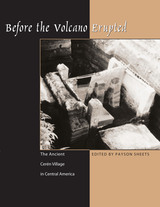 Before the Volcano Erupted: The Ancient Cerén Village in Central America
Edited by Payson Sheets
University of Texas Press, 2002 On an August evening around AD 600, residents of the Cerén village in the Zapotitán Valley of what is now El Salvador were sitting down to their nightly meal when ground tremors and loud steam emissions warned of an impending volcanic eruption. The villagers fled, leaving their town to be buried under five meters of volcanic ash and forgotten until a bulldozer uncovered evidence of the extraordinarily preserved town in 1976. The most intact Precolumbian village in Latin America, Cerén has been called the "Pompeii of the New World." This book presents complete and detailed reports of the excavations carried out at Cerén since 1978 by a multidisciplinary team of archaeologists, ethnographers, volcanologists, geophysicists, botanists, conservators, and others. The book is divided into sections that discuss the physical environment and resources, household structures and economy, special buildings and their uses, artifact analysis, and topical and theoretical issues. As the authors present and analyze Cerén's houses and their goods, workshops, civic and religious buildings, kitchen gardens, planted fields, and garbage dumps, a new and much clearer picture of how commoners lived during the Maya Classic Period emerges. These findings constitute landmark contributions to the anthropology and archaeology of Central America.
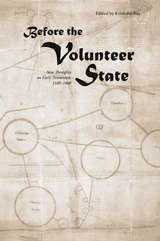 Before the Volunteer State: New Thoughts on Early Tennessee, 1540–1800
Kristofer Ray
University of Tennessee Press, 2014 Most general studies of Tennessee history begin with the arrival of Anglo-American settlers in the 1760s, with only a brief overview of the state’s “prehistory.” This welcome volume rethinks this narrative by placing Tennessee’s origins firmly in the seventeenth century. In ten thoughtful essays, scholars of trans-Appalachian and early American history address a number of issues that have been touched on only fleetingly within Tennessee historiography, including the dynamic balance of Native American concerns and European imperial interests, the complexity of Revolutionary-era struggles, and the associated challenges of jurisdiction, dominion, and identity formation. Collectively, the volume situates Tennessee more firmly within the context of regional, North American, and Atlantic World developments.
The essays are divided into two parts—the first focusing on the establishment and geopolitical complexities of seventeenth- and early-eighteenth-century life in and around the Tennessee River, and the second exploring the effects of the American Revolution in this geopolitical space. Topics in Part One include Indian life in the late Mississippian era, how contact with Europeans forced a process of migration and change, European understanding of Cherokee strength, and the importance of the Creeks, Cherokees, and Shawnees to early Tennessee history. Part Two offers articles about the confusing milieu into which the region was thrown during the Revolution, the central role of kinship networks for both Indians and whites, and the difficulties of identity formation as Euro-Americans expanded their presence on the Tennessee frontier. The work concludes by addressing the issue of myth and memory and how early Tennessee history was overtaken by nineteenth-century historical narratives that continue to serve as the foundation for understanding the state.
Taken together, these essays provide a gateway through which to reimagine early Tennessee history—a reimagining that demonstrates the significance of the Volunteer State within broader trends in early modern, southern, trans-Appalachian, and Atlantic World history.
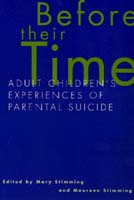 Before Their Time
Mary Stimming
Temple University Press, 1998 Before Their Time is the first work to present adult children survivors' (defined as eighteen or above at the time of the parent's death) accounts of their loss, grief, and resolution following a parent's suicide. In once section, the book offers the perspectives of sons and daughters on the deaths of mothers; in another, the perspectives of sons and daughters on the deaths of fathers. In a third section, siblings reflect on the shared loss of their mother.
Each of these survivors faces the common difficulties associated with losing a loved one by suicide. They also experience difficulties specific to their status as both adult and child. Topics such as the impact of the parent's suicide on adult children's personal and professional choices, marriages and parenting, sibling and surviving parent relationships are explored with sensitivity and insight. Various coping skills, including humor, are described.
The writers describe feelings of regret and responsibility related to their parent's suicide. They express concern about other family members' vulnerability to suicide. They speak openly about the fears and stresses they face and how they cope with them.
The authors ranged in age from nineteen to thirty-six at the time of the parent's death. Between one and twenty-five years have passed since that tragedy.
In addition to the first-person narratives, the book includes a resource section with a national listing of suicide survivor support groups; an overview of existing research on survivors of suicide by John L. McIntosh, past president of the American Association of Suicidology; and an essay on elderly suicide by David C. Clark, secretary-general, International Association for Suicide, and editor-in-chief of Crisis. The book is introduced with a Foreword by Rev. Charles Rubey, founder and director of Loving Outreach to Survivors of Suicide.
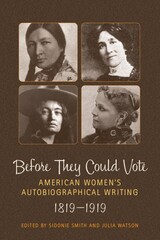 Before They Could Vote: American Women's Autobiographical Writing, 1819–1919
Edited by Sidonie A. Smith and Julia Watson
University of Wisconsin Press, 2006 The life narratives in this collection are by ethnically diverse women of energy and ambition—some well known, some forgotten over generations—who confronted barriers of gender, class, race, and sexual difference as they pursued or adapted to adventurous new lives in a rapidly changing America. The engaging selections—from captivity narratives to letters, manifestos, criminal confessions, and childhood sketches—span a hundred years in which women increasingly asserted themselves publicly. Some rose to positions of prominence as writers, activists, and artists; some sought education or wrote to support themselves and their families; some transgressed social norms in search of new possibilities. Each woman's story is strikingly individual, yet the brief narratives in this anthology collectively chart bold new visions of women's agency.
"This rich new anthology sets in motion an inter-textual conversation of remarkable vitality that will change the ways we understand gender, class, ethnicity, culture, and nation in nineteenth-century America."—Susanna Egan, author of Mirror-Talk
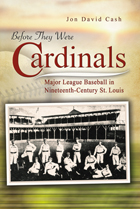 Before They Were Cardinals: Major League Baseball in Nineteenth-Century St. Louis
Jon David Cash
University of Missouri Press, 2002 Mark McGwire, Ozzie Smith, Lou Brock. These famous Cardinals are known by baseball fans around the world. But who and what were the predecessors of these modern-day players and their team? In Before They Were Cardinals, Jon David Cash examines the infancy of major-league baseball in St. Louis during the last quarter of the nineteenth century. His in-depth analysis begins with an exploration of the factors that motivated civic leaders to form the city's first major-league ball club. Cash delves into the economic trade rivalry between Chicago and St. Louis and examines how St. Louis's attempt to compete with Chicago led to the formation of the St. Louis Brown Stockings in 1875. He then explains why, three years later, despite its initial success, St. Louis baseball quickly vanished from the big-league map. St. Louis baseball was revived with the arrival of German immigrant saloon owner Chris Von der Ahe. Cash explains how Von der Ahe, originally only interested in concession rights, purchased a controlling interest in the Brown Stockings. His riveting account follows the team after Von der Ahe's purchase, from the formation of the American Association, to its merger in 1891 with the rival National League. He chronicles Von der Ahe's monetary downturn, and the club's decline as well, following the merger. Before They Were Cardinals provides vivid portraits of the ball players and the participants involved in the baseball war between the National League and the American Association. Cash points out significant differences, such as Sunday games and beer sales, between the two Leagues. In addition, excerpts taken from Chicago and St. Louis newspapers make the on-field contests and off-field rivalries come alive. Cash concludes this lively historical narrative with an appendix that traces the issue of race in baseball during this period. The excesses of modern-day baseball—players jumping contracts or holding out for more money, gambling on games, and drinking to excess; owners stealing players and breaking agreements—were all present in the nineteenth-century sport. Players were seen then, as they are now, as an embodiment of their community. This timely treatment of a fascinating period in St. Louis baseball history will appeal to both baseball aficionados and those who want to understand the history of baseball itself.
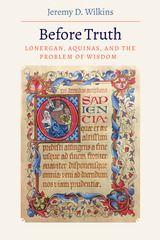 Before Truth: Lonergan, Aquinas, and the Problem of Wisdom
Jeremy Wilkins
Catholic University of America Press, 2018 It’s frequently said that we live in a “post-truth” age. That obviously can’t be true, but it does name a real problem on our hands. Getting things right is hard, especially if they’re complicated. It takes preparation, diligence, and honesty. Wisdom, according to Thomas Aquinas, is the quality of right judgment. This book is about the problem of becoming wise, the problem “before truth.” It is about that problem particularly as it comes up for religious, philosophical, and theological truth claims. Before Truth: Lonergan, Aquinas, and the Problem of Wisdom proposes that Bernard Lonergan’s approach to these problems can help us become wise. One of the special problems facing Christian believers today is our awareness of how much our tradition has developed. This development has occurred along a path shot through with contingencies. Theologians have to be able to articulate how and why doctrines, institutions, and practices that have developed—and are still developing—should nevertheless be worthy of our assent and devotion.
Before Virtue
Jonathan J. Sanford
Catholic University of America Press, 2015 Jonathan Sanford finds that despite the common origins of contemporary virtue ethics in Anscombe, the literature varies widely not just in its scope but in its basic commitments. What exactly is contemporary virtue ethics? In Before Virtue, Sanford develops strategies for describing contemporary virtue ethics accurately. He then assesses contemporary virtue approaches by the Anscombean dual standard which inspired them: the degree to which they avoid the pitfalls of modern moral philosophy and the extent to which they exemplify a successful recovery of an Aristotelian approach to ethics.
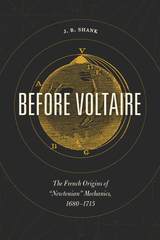 Before Voltaire: The French Origins of “Newtonian” Mechanics, 1680-1715
J.B. Shank
University of Chicago Press, 2017 We have grown accustomed to the idea that scientific theories are embedded in their place and time. But in the case of the development of mathematical physics in eighteenth-century France, the relationship was extremely close. In Before Voltaire, J.B. Shank shows that although the publication of Isaac Newton’s Principia in 1687 exerted strong influence, the development of calculus-based physics is better understood as an outcome that grew from French culture in general.
Before Voltaire explores how Newton’s ideas made their way not just through the realm of French science, but into the larger world of society and culture of which Principia was an intertwined part. Shank also details a history of the beginnings of calculus-based mathematical physics that integrates it into the larger intellectual currents in France at the time, including the Battle of the Ancients and the Moderns, the emergence of wider audiences for science, and the role of the newly reorganized Royal Academy of Sciences. The resulting book offers an unprecedented cultural history of one the most important and influential elements of Enlightenment science.
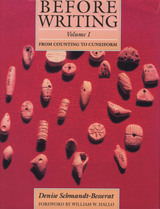 Before Writing, Vol. I: From Counting to Cuneiform
By Denise Schmandt-Besserat
University of Texas Press, 1992 A fascinating book on the origins of writing.
Before Writing gives a new perspective on the evolution of communication. It points out that when writing began in Mesopotamia it was not, as previously thought, a sudden and spontaneous invention. Instead, it was the outgrowth of many thousands of years' worth of experience at manipulating symbols. In Volume I: From Counting to Cuneiform, Denise Schmandt-Besserat describes how in about 8000 B.C., coinciding with the rise of agriculture, a system of counters, or tokens, appeared in the Near East. These tokens—small, geometrically shaped objects made of clay—represented various units of goods and were used to count and account for them. The token system was a breakthrough in data processing and communication that ultimately led to the invention of writing about 3100 B.C. Through a study of archaeological and epigraphic evidence, Schmandt-Besserat traces how the Sumerian cuneiform script, the first writing system, emerged from a counting device. In Volume II: A Catalog of Near Eastern Tokens, Schmandt-Besserat presents the primary data on which she bases her theories. These data consist of several thousand tokens, catalogued by country, archaeological site, and token types and subtypes. The information also includes the chronology, stratigraphy, museum ownership, accession or field number, references to previous publications, material, and size of the artifacts. Line drawings and photographs illustrate the various token types.
 Before Writing, Vol. II: A Catalog of Near Eastern Tokens
By Denise Schmandt-Besserat
University of Texas Press, 1992 Before Writing gives a new perspective on the evolution of communication. It points out that when writing began in Mesopotamia it was not, as previously thought, a sudden and spontaneous invention. Instead, it was the outgrowth of many thousands of years' worth of experience at manipulating symbols. In Volume I: From Counting to Cuneiform, Denise Schmandt-Besserat describes how in about 8000 B.C., coinciding with the rise of agriculture, a system of counters, or tokens, appeared in the Near East. These tokens—small, geometrically shaped objects made of clay—represented various units of goods and were used to count and account for them. The token system was a breakthrough in data processing and communication that ultimately led to the invention of writing about 3100 B.C. Through a study of archaeological and epigraphic evidence, Schmandt-Besserat traces how the Sumerian cuneiform script, the first writing system, emerged from a counting device. In Volume II: A Catalog of Near Eastern Tokens, Schmandt-Besserat presents the primary data on which she bases her theories. These data consist of several thousand tokens, catalogued by country, archaeological site, and token types and subtypes. The information also includes the chronology, stratigraphy, museum ownership, accession or field number, references to previous publications, material, and size of the artifacts. Line drawings and photographs illustrate the various token types.
The Beforeland: A Novel
Corinna Vallianatos
Acre Books, 2020 In The Beforeland, a boy’s desperate act of rebellion against his grandmother reverberates outward, causing rifts and reckonings in the lives of others: a man fleeing his own troubled family who becomes the grandson’s unwitting accomplice; a poet struggling with the limitations of language and his wife’s distance; the proprietor of a dying motel; and the grandmother herself, who finds love for the first time as she recuperates from her injury. Set in the Mojave Desert and the suburbs of Southern California, this revelatory novel moves swiftly among characters who are caught between the deprivations of the past and the mysteries of the future. With unflinching precision, Vallianatos unearths the vulnerability and volatility at our cores.
Befriending: The American Samaritans
Monica Dickens
University of Wisconsin Press, 1996 This book relates the founding in America, and evaluates the effectiveness of, a branch of the worldwide organization of volunteers known as the Samaritans, committed to the prevention of suicide through the simple means of “listening therapy.” Great-granddaughter of Charles Dickens, Monica Dickens was best known in England as a novelist; in America, as the founder of the U.S. Samaritans. Today Samaritans are in every large city of the country. Volunteers work twenty-four hours a day, answering telephones or meeting troubled people, to try to give them, in nonjudgmental ways, the help they need to get their lives back in order.
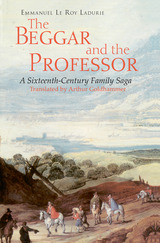 The Beggar and the Professor: A Sixteenth-Century Family Saga
Emmanuel Le Roy Ladurie
University of Chicago Press, 1997 From a wealth of vivid autobiographical writings, Emmanuel Le Roy Ladurie reconstructs the extraordinary life of Thomas Platter and the lives of his sons. With masterful erudition, Le Roy Ladurie deepens and expands the historical contexts of these accounts and, in the process, brings to life the customs, perceptions, and character of an age poised at the threshold of modernity.
"Le Roy Ladurie paints a remarkably contemporary picture of life in the sixteenth century. . . . It's a good story, told with a deft narrative touch."—Michael S. Kimmel, The Nation
"Le Roy Ladurie is a master of the representative detail and uses the Platters' lives as a means to see a whole century 'through a glass, darkly'."—The Independent
"Le Roy Ladurie has not only thoroughly sketched out the Platters' particular brand of gusto, he has also made it seem a defining characteristic of the sixteenth century."—The New Republic
"All [of] the drama and pathos of a Disney film."—Emily Eakin, Lingua Franca
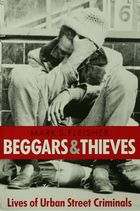 Beggars and Thieves: Lives of Urban Street Criminals
Mark S. Fleisher
University of Wisconsin Press, 1995 As the incidence of violent crime rises in the United States, so does the public demand for a solution. But what will work?
Mark S. Fleisher has spent years among inmates in jails and prisons and on the streets with thieves, gang members, addicts, and life-long criminals in Seattle and other cities across the country. In Beggars and Thieves, he writes about how and why they become and remain offenders, and about the actual role of jails and prisons in efforts to deter crime and rehabilitate criminals. Fleisher shows, with wrenching firsthand accounts, that parents who are addicts, abusers, and criminals beget irreversibly damaged children who become addicts, abusers, and criminals. Further, Fleisher contends that many well-intentioned educational and vocational training programs are wasted because they are offered too late to help. And, he provides sobering evidence that many youthful and adult offenders find themselves better off in prison—with work to do, medical care, a clean place to sleep, regular meals, and stable social ties—than they are in America’s cities.
Fleisher calls for anti-crime policies that are bold, practical, and absolutely imperative. He prescribes life terms for violent offenders, but in prisons structured as work communities, where privileges are earned through work in expanded, productive industries that reduce the financial burden of incarceration on the public. But most important, he argues that the only way to prevent street crime, cut prison growth, and reduce the waste of money and human lives is to permanently remove brutalized children from criminal, addicted, and violent parents.
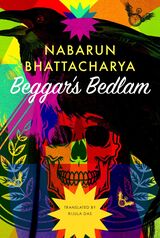 Beggar’s Bedlam
Nabarun Bhattacharya
Seagull Books, 2024 A hilarious and absurdist take on the political landscape of West Bengal, India.
Beggar’s Bedlam is a surreal novel that unleashes the chaos of the carnival on the familiar. Part literary descendent of Bulgakov’s The Master and Margarita and part a reconstruction of lost Bengali history, Nabarun Bhattacharya’s masterpiece is a jubilant, fizzing wire of subaltern anarchy and insurrection.
Marshall Bhodi Sarkar and his lieutenant Sarkhel surreptitiously dig on the banks of the Ganges River looking for crude oil reserves. Instead, they unearth curved daggers, rusty broadswords, and a Portuguese cannon. Bhodi is an occasional military man and the lead sorcerer of the secret black-magic sect named Choktar. He joins forces with the flying Flaperoos—men with a predilection for alcohol and petty vandalism—to declare outright war against the Marxist–Leninist West Bengal government. In a bloodless revolution that is fascinating in its utter implausibility, a motley crew of yet more implausible characters come together in a magic-realist fictional remapping of Calcutta.
Begging for It
Alex Dimitrov
Four Way Books, 2013 In his debut collection of poems, Begging for It, Alex Dimitrov leads us through the streets, bridges, and bedrooms of New York City, sometimes as far away as Buenos Aires and Iceland, and as close as our own darkest corners. A Bulgarian immigrant, Dimitrov writes as both observer of and fervent participant in this “American Youth,” as his speakers navigate both the physical and emotional landscapes of desire, intimacy, and longing—whether for a friend, a lover, or a self, “Saint or stranger, I still recklessly seek you.”
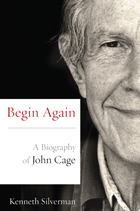 Begin Again: A Biography of John Cage
Kenneth Silverman
Northwestern University Press, 2012 A man of extraordinary and seemingly limitless talents—musician, inventor, composer, poet, and even amateur mycologist—John Cage became a central figure of the avant-garde early in his life and remained at that pinnacle until his death in 1992 at the age of eighty. Award-winning biographer Kenneth Silverman gives us the first comprehensive life of this remarkable artist. Silverman begins with Cage’s childhood in interwar Los Angeles and his stay in Paris from 1930 to 1931, where immersion in the burgeoning new musical and artistic movements triggered an explosion of his creativity. Cage continued his studies in the United States with the seminal modern composer Arnold Schoenberg, and he soon began the experiments with sound and percussion instruments that would develop into his signature work with prepared piano, radio static, random noise, and silence. Cage’s unorthodox methods still influence artists in a wide range of genres and media. Silverman concurrently follows Cage’s rich personal life, from his early marriage to his lifelong personal and professional partnership with choreographer Merce Cunningham, as well as his friendships over the years with other composers, artists, philosophers, and writers.
Drawing on interviews with Cage’s contemporaries and friends and on the enormous archive of his letters and writings, and including photographs, facsimiles of musical scores, and Web links to illustrative sections of his compositions, Silverman gives us a biography of major significance: a revelatory portrait of one of the most important cultural figures of the twentieth century.
Begin Here: The Forgotten Conditions of Teaching and Learning
Jacques Barzun
University of Chicago Press, 1991 In this powerful, eloquent, and timely book, Jacques Barzun offers guidance for resolving the crisis in America's schools and colleges. Drawing on a lifetime of distinguished teaching, he issues a clear call to action for improving what goes on in America's classrooms. The result is an extraordinarily fresh, sensible, and practical program for better schools.
"It is difficult to imagine a more pungent, perceptive or eloquent commentary on contemporary American education than this collection of 15 pieces by Jacques Barzun."—Jonathan Yardley, Washington Post Book World
"Mr. Barzun's style is elegant, distinctive, philosophically consistent and much better-humored than that of many contemporary invective-hurlers."—David Alexander, New York Times Book Review
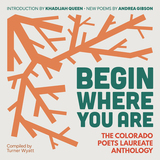 Begin Where You Are: The Colorado Poets Laureate Anthology
Turner Wyatt
University Press of Colorado, 2025 Begin Where You Are: The Colorado Poets Laureate Anthology is a book of firsts. It is the first ever US state poet laureate anthology. It is the first poetry collection featuring all ten Colorado poets laureate (the second oldest state poet laureateship, established in 1919). And it is the first place readers can discover unpublished poems by Andrea Gibson—bestselling author and one of the most influential spoken word artists of our generation.
This book contains celebrated works from Thomas Hornsby Ferril and others, alongside never-before-published pieces from Bobby LeFebre, Joseph Hutchison, David Mason, and Mary Crow. Contemporary poets offer perspectives on how serving as Colorado poet laureate shaped their writing and worlds.
Spearheaded by award-winning social entrepreneur Turner Wyatt, this book is a movement with a mission: A portion of the proceeds will fund poetry programming in underserved Colorado schools, libraries, and rural areas, making each purchase an investment in expanding access to this essential art form.
Featured poets: Andrea Gibson, Bobby LeFebre, Joseph Hutchison, David Mason, Mary Crow, Thomas Hornsby Ferril, Milford E. Shields, Margaret Clyde Robertson, Nellie Burget Miller, Alice Polk Hill
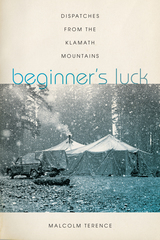 Beginner's Luck: Dispatches from the Klamath Mountains
Malcolm Terence
Oregon State University Press, 2018 In the late 1960s, Malcolm Terence left his job as a reporter for the Los Angeles Times to look for adventure and may have found more than he bargained for. The era had triggered unprecedented social and political changes in America, tectonic shifts that challenged war and the social order that oppressed people along lines of class, gender, and race. One branch was a back-to-the-land movement, and Terence, who had just traveled for a year managing a rock band, strayed into Black Bear Ranch, a commune just starting in a remote corner of the Klamath Mountains near the California-Oregon border.
Black Bear Ranch still exists, but many of its early residents eventually returned to urban civilization. A few, Terence among them, stayed on in neighboring river towns. Some tried logging, others gold mining, and some tried growing marijuana, all with mixed success. The local mining and timber communities had a checkered opinion of their new hippie neighbors, as did the Native tribes, but it was the kind of place where people helped each other out, even if they didn’t always agree.
When wildfires grew large, Terence and other veterans of the commune joined the fire crews run by the US Forest Service. In between, the Black Bear expats built homesteads, planted gardens, delivered babies, and raised their children. They gradually overcame the skepticism of the locals and joined them in political battles against the use of herbicides in the forest and the Forest Service’s campaign to close all the mining claims. As in the best of organizing efforts, the organizers learned as much as they led.
Beginner’s Luck will appeal to anyone who experienced life on a commune in the 1960s–1970s or who wants to learn about this chapter in modern American history. Terence offers insight into environmental activism and the long history of conflict between resource exploitation and Native American rights without lecturing or pontificating. With wit, humor, and humility, his anecdotal essays chronicle a time and place where disparate people came together to form an unlikely community.
Beginning Again with the Classical Orders: Rhythms of Justice, Nature, and Architecture
Antonios Thodis
Harvard University Press Beginning Again with the Classical Orders reconsiders well-established understandings of the Corinthian, Doric, and Ionic architectural orders that emerged during the Archaic and Classical periods in ancient Greece. The orders were significant not only in architecture, but also in myth and ritual, cosmology, and philosophical thought, informed by the ancient Greeks’ relation to nature as kosmos, “orderly, harmonious arrangement.” Antonios Thodis looks at uses of the orders in temples and material remains as well as in ancient literature, showing their relationship to practical affairs and cultural practices such as the hōrai, “hours and seasons,” dikē, “justice,” and temenos, “sacred space.” The orders were compatible and complementary, tied through the overarching theme of seasonality.
 Beginning at the End: Decadence, Modernism, and Postcolonial Poetry
Robert Stilling
Harvard University Press, 2018 During the struggle for decolonization, Frantz Fanon argued that artists who mimicked European aestheticism were “beginning at the end,” skipping the inventive phase of youth for a decadence thought more typical of Europe’s declining empires. Robert Stilling takes up Fanon’s assertion to argue that decadence became a key idea in postcolonial thought, describing both the failures of revolutionary nationalism and the assertion of new cosmopolitan ideas about poetry and art.
In Stilling’s account, anglophone postcolonial artists have reshaped modernist forms associated with the idea of art for art’s sake and often condemned as decadent. By reading decadent works by J. K. Huysmans, Walter Pater, Henry James, and Oscar Wilde alongside Chinua Achebe, Derek Walcott, Agha Shahid Ali, Derek Mahon, Yinka Shonibare, Wole Soyinka, and Bernardine Evaristo, Stilling shows how postcolonial artists reimagined the politics of aestheticism in the service of anticolonial critique. He also shows how fin de siècle figures such as Wilde questioned the imperial ideologies of their own era.
Like their European counterparts, postcolonial artists have had to negotiate between the imaginative demands of art and the pressure to conform to a revolutionary politics seemingly inseparable from realism. Beginning at the End argues that both groups—European decadents and postcolonial artists—maintained commitments to artifice while fostering oppositional politics. It asks that we recognize what aestheticism has contributed to politically engaged postcolonial literature. At the same time, Stilling breaks down the boundaries around decadent literature, taking it outside of Europe and emphasizing the global reach of its imaginative transgressions.
Beginning Hindi: A Complete Course
Joshua H. Pien and Fauzia Farooqui
Georgetown University Press, 2013 Beginning Hindi is designed to help first-year learners acquire the language by using it in real-life situations. The book and its accompanying audio files–available on the Press website–include clear explanations of language structures, engaging activities, and an organizational format that makes it easy to chart student progress.
 The Beginning of History: Value Struggles and Global Capital
Massimo De Angelis
Pluto Press, 2007 Francis Fukuyama may declare the "end of history," and neoliberal capital embraces this belief. However, the diverse struggles for commons and dignity around the planet reveal a different reality: that of the beginning of history. The clash between these two perspectives is the subject matter of this book. This book analyzes the frontline of this struggle. On one side, a social force called capital pursues endless growth and monetary value. On the other side, other social forces strive to rearrange the web of life on their own terms. This book engages with alternative modes of coproduction recently posed by the alter-globalization movement, and it examines what these movements are up against. This passionate account explores groundbreaking new critical political economic theory and its role in bringing about radical social change. This book is a must for all political activists and students of political theory.
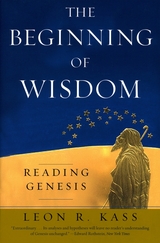 The Beginning of Wisdom: Reading Genesis
Leon R. Kass
University of Chicago Press, 2006 As ardent debates over creationism fill the front pages of newspapers, Genesis has never been more timely. And as Leon R. Kass shows in The Beginning of Wisdom, it’s also timeless. Examining Genesis in a philosophical light, Kass presents it not as a story of what happened long ago, but as the enduring story of humanity itself. He asserts that the first half of Genesis contains insights about human nature that “rival anything produced by the great philosophers.” Kass here reads these first stories—from Adam and Eve to the tower of Babel—as a mirror for self-discovery that reveals truths about human reason, speech, freedom, sexual desire, pride, shame, anger, and death. Taking a step further in the second half of his book, Kass explores the struggles in Genesis to launch a new way of life that addresses mankind’s morally ambiguous nature by promoting righteousness and holiness. Even readers who don’t agree with Kass’s interpretations will find The Beginning of Wisdom acompelling book—a masterful philosophical take on one of the world’s seminal religious texts. “Extraordinary. . . . Its analyses and hypotheses will leave no reader’s understanding of Genesis unchanged.” —New York Times
“A learned and fluent, delightfully overstuffed stroll through the Gates of Eden. . . . Mix Harold Bloom with Stephen Jay Gould and you’ll get something like Kass. A wonderfully intelligent reading of Genesis.”—Kirkus Reviews, starred review
“Throughout his book, Kass uses fruitful, fascinating techniques for getting at the heart of Genesis. . . . Innumerable times [he] makes a reader sit back and rethink what has previously been tediously familiar or baffling.”—Washington Post
“It is important to state that this is a book not merely rich, but prodigiously rich with insight. Kass is a marvelous reader, sensitive and careful. His interpretations surprise again and again with their cogency and poignancy.”—Jerusalem Post
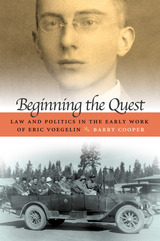 Beginning the Quest: Law and Politics in the Early Work of Eric Voegelin
Barry Cooper
University of Missouri Press, 2009 Beginning the Quest by Barry Cooper provides an analysis of the legal and political writings of Eric Voegelin during the 1920s and 1930s. The subject matter of his analyses during this time period was quite distinct from the focus of his concerns thirty years later.
It has often been noted that Voegelin was a pupil of Hans Kelsen, the author of the postwar Austrian constitution and one of the great legal minds of the twentieth century. The significance of the fact that Voegelin began his academic life as a legal scholar has not, however, been emphasized, though his background provides a strong contrast with that of his contemporaries Leo Strauss and Hannah Arendt.
Beginning the Quest opens with Voegelin’s efforts, following the trauma of defeat in World War I, at understanding the relation of law and the study of law (Staatslehre) to what he then called “sociohistorical reality.” Much of this writing consisted of methodological analysis and criticism centered chiefly on the status of neo-Kantian philosophy as the basis for what we now call the social sciences. Voegelin wished to push the scientific understanding of sociohistorical reality beyond the scope afforded by German social science.
Cooper discusses Voegelin’s first systematic effort to bring together the principles of philosophical anthropology (including philosophy of history) with his understanding of comparative social science and a theory of law more comprehensive than Kelsen’s. In developing his argument, Voegelin discovered the centrality of what he called “political ideas.”
Cooper also deals with Voegelin’s The Authoritarian State (1936), which argues that Austria was more an administrative unit than a body politic. It was, to say the least, a startling analysis, but one that reappeared in later writings as well, especially in The New Science of Politics.
As a final point, Cooper deals with the concept of “political religions” that Voegelin developed in the 1938 book of that name. Just as the Austrians were groping toward the formation of a body politic, so too were the Germans. Instead of the authoritarian state being the form that the German “political people” attained, it was, as Voegelin showed in his race books, quite different. Voegelin developed the term political religion to describe the animating core of the National Socialist regime. The formation of this concept reveals that Voegelin had moved from a focus on the legal structure of a polity to its spiritual order—in the example of Nazi Germany, an unquestionably “Satanic” order.
Cooper concludes that just as the great crisis of Voegelin’s youth—World War I and its aftermath—led him to question the received premises of the Staatslehre tradition in which he was schooled, so did the crisis resulting in World War II lead him to develop ever-more-comprehensive accounts of the disorder and political convulsions of the day. The “quest” of the title of this study continued until Voegelin’s death.
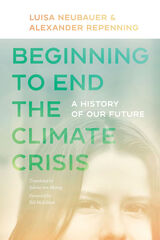 Beginning to End the Climate Crisis: A History of Our Future
Luisa Neubauer and Alexander Repenning
Brandeis University Press, 2023 There is no planet B. Activists share how we must inform and organize ourselves to save the future.
“Act as though your house is on fire. Because it is.” Following Greta Thunberg, millions of young climate activists have been taking to the streets around the globe as part of the Fridays For Future movement. They demand that we “unite behind the science,” as, for too long, climate scientists have been ringing the alarm bells about rising temperatures, tipping points, and the devastating consequences of extreme weather—but politicians do nothing.
So how do you begin to end the climate crisis? Luisa Neubauer and Alexander Repenning begin by telling stories. Neubauer cofounded the youth climate activist group in Germany and has become its most prominent voice. In this book she and Repenning weave in personal accounts of their evolution as climate activists with a thorough analysis of how climate change impacts their generation, and what every one of us can and must do about it. The young and old in the United States and around the world can learn valuable lessons from their European counterparts.
Beginning to See the Light: Sex, Hope, and Rock-and-Roll
Ellen Willis
University of Minnesota Press, 2012 From the New Yorker’s inimitable first pop music critic comes this pioneering collection of essays by a conscientious writer whose political realm is both radical and rational, and whose prime preoccupations are with rock ’n’ roll, sexuality, and above all, freedom. Here Ellen Willis assuredly captures the thrill of music, the disdain of authoritarian culture, and the rebellious spirit of the ’60s and ’70s.
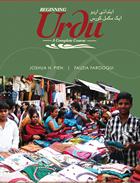 Beginning Urdu: A Complete Course
Joshua H. Pien and Fauzia Farooqui
Georgetown University Press, 2016 eTextbooks are now available through VitalSource.com! Beginning Urdu is a complete first-year textbook designed to help learners acquire the language by actively using it in real-life situations. The book and its accompanying audio files–available on the Press website–contain all that is needed to complete one full year of study, including clear explanations of language structures; useful, fun, and engaging activities; and an organizational format that makes it easy to chart student progress. FEATURES
• Develops all four skills—listening, speaking, reading, writing—through a wide range of tasks and activities, including role plays, games, and short conversations
• Beautifully illustrated with full-color, authentic images and written in an accessible style
• Introduces the sound system and script of Urdu
• Organized around functional themes such as home and family, everyday life, the marketplace, personal responsibilities, and travel
• Features straightforward grammatical explanations and topically organized vocabulary lists for each of the 34 chapters
• Integrates cultural information within the thematic units and also presents culture through aphorisms, poetry, and photographs
• Provides an activity set for each unit along with review activities, including tips for increasing fluency and sets of questions to help personalize learning
• Contains Urdu–English and English–Urdu glossaries
• Includes three appendices—Urdu numbers, additional grammatical structures for moving to advanced levels of proficiency, and a suggested syllabus
Beginning Urdu covers approximately 150 contact hours and is designed to bring learners to the ACTFL proficiency level of mid- to high-intermediate in all four skills. The book also serves as a valuable resource for independent learners.
 Beginning with Plato: Poems
Joseph Warren Beach
University of Minnesota Press, 1944
Beginning with Plato was first published in 1944. Minnesota Archive Editions uses digital technology to make long-unavailable books once again accessible, and are published unaltered from the original University of Minnesota Press editions.
These selected poems of Joseph Warren Beach range in time from the present year to the age of Pericles; in place from California to Shangri-La, from Paris to the Middle West; in theme from current political issues to the timeless problems of Greek philosophy; in mood from tender love to trenchant satire. In these fifty-odd poems is a rich variety—Anthony Eden and Cordell Hull, the French capital in the summer preceding the first World War, the skylines of the American West, the skylines of Minneapolis, soldier and swan maiden, and the inner life of man wherever lived. Mr. Beach can tell home truths without bitterness, and handle nostalgic emotion without sentimentality.
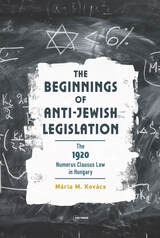 The Beginnings of Anti-Jewish Legislation: The 1920 Numerus Clausus Law in Hungary
Mária M. Kovács
Central European University Press, 2024 The Nazi 1933 Civil Service Law and the 1935 Nuremberg Laws are often considered the first anti-Jewish decrees in interwar Europe. Mária M. Kovács convincingly argues that Hungary’s numerus clausus law of 1920, which introduced a Jewish quota at Hungary’s institutions of higher learning, was, in fact, interwar Europe’s first antisemitic law. By defining—and discriminating against—Jews as a separate “racial” or “national” group, it abrogated the principle of equal rights that had been enshrined into law; as such, it marked an abrupt reversal of Jewish emancipation in Hungary. Moreover, the numerus clausus law set the stage for subsequent “Jewish Laws” (in the late 1930s and early 1940s) that sought to solve Hungary’s “Jewish Question” by means of extraordinary legal measures that targeted Jews alone. This book examines the origins and implementation of the numerus clausus, as well as the attempts to dampen its impact on Hungary’s international reputation, focusing on the debates surrounding it promulgation (1920), its modification (1928) and its eventual application to other areas of Jewish life (1938–45).
 The Beginnings of Social Understanding
Judy Dunn
Harvard University Press, 1988 When does our acknowledgment of the social contract really begin? When do young children first display an understanding of their social world? When and why do they begin to grasp that other people have feelings and thoughts like their own, yet different? In this pathbreaking work Judy Dunn explores several aspects of the early process of social discovery: children's recognition of the feelings of others, their ability to interpret and anticipate the behavior and relationships of others, and their comprehension of the prohibitions and accepted practices of their world.
Dunn's work brings into focus an apparent paradox in our current view of the very young child's social understanding. Whereas research on infancy reveals that babies are born with a predisposition to learn about other people, and appear sensitive to the emotions and behavior of others, experimental studies suggest that children of three, four, and five years of age have difficulty gauging the feelings, intentions, and perceptions of others. Why should this social intelligence--which might be expected to be high on the developmental agenda--proceed so slowly? Is the social understanding of young children really so limited? Dunn pursues answers to these questions through close observation of children in their homes, in the complex social world of the family; her findings suggest a sophistication that has not yet been appreciated or documented.
The Beginnings of Social Understanding draws upon observations and analyses from three longitudinal studies of children during the transition from infancy to childhood, examining children's disputes, jokes, play, their questions and narratives about others. The book demonstrates children's increasing subtlety as members of a cultural world, and argues that emotional relationships and family discourse play crucial roles in the development of this understanding. Dunn breaks through traditional notions of child development as she sets forth a refreshingly original perspective from which to view the social potential of children.
The Beginnings of the Cinema in England, 1894-1901: Volume 1: 1894-1896
John Barnes
University of Exeter Press, 2014 Describing in detail one of the most inventive periods in the history of English cinema, the volumes in this celebrated series are already established as classics in their field. Each volume details the highlights of a single cinematic year, including details of production, manufacturers of equipment, dealers, and exhibitors. This is augmented by numerous carefully chosen illustrations and a comprehensive filmography of English films, fiction and nonfiction, for the year. Particular attention is also paid to the ways in which the cinema of other countries affected the English industry. Volumes 1 is edited and introduced by Richard Maltby and has a foreword by David Robinson.
The Beginnings of the Cinema in England, 1894-1901: Volume 2: 1897
John Barnes
University of Exeter Press, 2014 Describing in detail one of the most inventive periods in the history of English cinema, the volumes in this celebrated series are already established as classics in their field. Each volume details the highlights of a single cinematic year, including details of production, manufacturers of equipment, dealers, and exhibitors. This is augmented by numerous carefully chosen illustrations and a comprehensive filmography of English films, fiction and nonfiction, for the year. Particular attention is also paid to the ways in which the cinema of other countries affected the English industry.
The Beginnings of the Cinema in England, 1894-1901: Volume 3: 1898
John Barnes
University of Exeter Press, 2014 Describing in detail one of the most inventive periods in the history of English cinema, the volumes in this celebrated series are already established as classics in their field. Each volume details the highlights of a single cinematic year, including details of production, manufacturers of equipment, dealers, and exhibitors. This is augmented by numerous carefully chosen illustrations and a comprehensive filmography of English films, fiction and nonfiction, for the year. Particular attention is also paid to the ways in which the cinema of other countries affected the English industry.
The Beginnings of the Cinema In England, 1894-1901: Volume 4: 1899
John Barnes
University of Exeter Press, 2014 Describing in detail one of the most inventive periods in the history of English cinema, the volumes in this celebrated series are already established as classics in their field. Each volume details the highlights of a single cinematic year, including details of production, manufacturers of equipment, dealers, and exhibitors. This is augmented by numerous carefully chosen illustrations and a comprehensive filmography of English films, fiction and nonfiction, for the year. Particular attention is also paid to the ways in which the cinema of other countries affected the English industry.
The Beginnings of the Cinema in England, 1894-1901: Volume 5: 1900
John Barnes
University of Exeter Press, 2014
Describing in detail one of the most inventive periods in the history of English cinema, the volumes in this celebrated series are already established as classics in their field. Each volume details the highlights of a single cinematic year, including details of production, manufacturers of equipment, dealers, and exhibitors. This is augmented by numerous carefully chosen illustrations and a comprehensive filmography of English films, fiction and nonfiction, for the year. Particular attention is also paid to the ways in which the cinema of other countries affected the English industry. Volume 5 is edited and introduced by Richard Maltby.
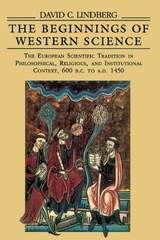 The Beginnings of Western Science: The European Scientific Tradition in Philosophical, Religious, and Institutional Context, 600 B.C. to A.D. 1450
David C. Lindberg
University of Chicago Press, 1992 This landmark book represents the first attempt in two decades to survey the science of the ancient world, the first attempt in four decades to write a comprehensive history of medieval science, and the first attempt ever to present a full, unified account of both ancient and medieval science in a single volume. In The Beginnings of Western Science, David C. Lindberg provides a rich chronicle of the development of scientific ideas, practices, and institutions from the pre-Socratic Greek philosophers to the late-medieval scholastics.
Lindberg surveys all the most important themes in the history of ancient and medieval science, including developments in cosmology, astronomy, mechanics, optics, alchemy, natural history, and medicine. He synthesizes a wealth of information in superbly organized, clearly written chapters designed to serve students, scholars, and nonspecialists alike. In addition, Lindberg offers an illuminating account of the transmission of Greek science to medieval Islam and subsequently to medieval Europe. And throughout the book he pays close attention to the cultural and institutional contexts within which scientific knowledge was created and disseminated and to the ways in which the content and practice of science were influenced by interaction with philosophy and religion. Carefully selected maps, drawings, and photographs complement the text.
Lindberg's story rests on a large body of important scholarship produced by historians of science, philosophy, and religion over the past few decades. However, Lindberg does not hesitate to offer new interpretations and to hazard fresh judgments aimed at resolving long-standing historical disputes. Addressed to the general educated reader as well as to students, his book will also appeal to any scholar whose interests touch on the history of the scientific enterprise.
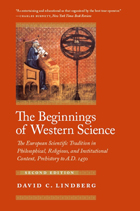 The Beginnings of Western Science: The European Scientific Tradition in Philosophical, Religious, and Institutional Context, Prehistory to A.D. 1450, Second Edition
David C. Lindberg
University of Chicago Press, 2008 The most comprehensive account of ancient and medieval science, a standard work for understanding the history of science
The Beginnings of Western Science is a landmark, the best book to ever to present a unified account of both ancient and medieval science in a single volume. Chronicling the development of scientific ideas, practices, and institutions from pre-Socratic Greek philosophy to late-Medieval scholasticism, David C. Lindberg surveys all the most important themes in the history of science, including developments in cosmology, astronomy, mechanics, optics, alchemy, natural history, and medicine. In addition, he offers an illuminating account of the transmission of Greek science to medieval Islam and subsequently to medieval Europe. For decades this book has shaped the way students and scholars understand these critically formative periods of scientific development, and it continues to be essential to an understanding of the field. this updated second edition includes revisions on nearly every page, as well as several sections that have been completely rewritten. For example, the section on Islamic science was thoroughly retooled to reveal the magnitude and sophistication of medieval Muslim scientific achievement. And the book now reflects a sharper awareness of the importance of Mesopotamian science for the development of Greek astronomy. In all, the second edition of The Beginnings of Western Science captures the current state of our understanding of more than two millennia of science and promises to continue to inspire both students and general readers.
 The Beguine, the Angel, and the Inquisitor: The Trials of Marguerite Porete and Guiard of Cressonessart
Sean L. Field
University of Notre Dame Press, 2012
On 31 May 1310, at the Place de Grève in Paris, the Dominican inquisitor William of Paris read out a sentence that declared Marguerite “called Porete,” a beguine from Hainault, to be a relapsed heretic, released her to secular authority for punishment, and ordered that all copies of a book she had written be confiscated. William next consigned Guiard of Cressonessart, an apocalyptic activist in the tradition of Joachim of Fiore and a would-be defender of Marguerite, to perpetual imprisonment. Over several months, William of Paris conducted inquisitorial processes against them, complete with multiple consultations of experts in theology and canon law. Though Guiard recanted at the last moment and thus saved his life, Marguerite went to her execution the day after her sentencing.
The Beguine, the Angel, and the Inquisitor is an analysis of the inquisitorial trials, their political as well as ecclesiastical context, and their historical significance. Marguerite Porete was the first female Christian mystic burned at the stake after authoring a book, and the survival of her work makes her case absolutely unique. The Mirror of Simple Souls, rediscovered in the twentieth century and reconnected to Marguerite's name only a half-century ago, is now recognized as one of the most daring, vibrant, and original examples of the vernacular theology and beguine mysticism that emerged in late thirteenth-century Christian Europe.
Field provides a new and detailed reconstruction of hitherto neglected aspects of Marguerite’s life, particularly of her trial, as well as the first extended consideration of her inquisitor's maneuvers and motivations. Additionally, he gives the first complete English translation of all of the trial documents and relevant contemporary chronicles, as well as the first English translation of Arnau of Vilanova’s intriguing “Letter to Those Wearing the Leather Belt,” directed to Guiard's supporters and urging them to submit to ecclesiastical authority.
"Sean Field's new book is top-of-the-line historical scholarship, exquisitely written, and deeply satisfying on more than one level: for its research, for the quality of the documentation and argument, but also for its careful organization and smooth exposition, which transform a complicated story into a scholarly page-turner." —Walter P. Simons, Dartmouth College
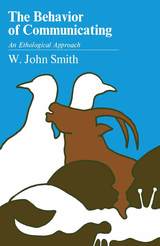 The Behavior of Communicating: An Ethological Approach
W. John Smith
Harvard University Press, 1977 In this book, W. John Smith enlarges ethology's perspective on communication and takes it in new directions. Traditionally, ethological analysis has focused on the motivational states of displaying animals: What makes the bird sing, the cat lash its tail, the bee dance? The Behavior of Communicating emphasizes messages. It seeks to answer questions about the information shared by animals through their displays: What information is made available to a bird by its neighbor's song, to a cat by its opponent's gesture, to a bee by its hivemate's dancing? What information is extracted from sources contextual to these displays? How are the responses to displays adaptive for recipients and senders? What evolutionary processes and constraints underlie observed patterns of animal communication?
Smith's approach is deeply rooted in the ethological tradition of naturalistic observations. Detailed analysis of observed displays and display repertoires illuminates the theoretical discussion that forms the core of the book. A taxonomy and interpretative analysis of messages made available through formalized display behavior are also developed. Smith shows that virtually all subhuman animal displays may be interpreted as transmitting messages about the communicator--not the environment--and, more specifically, that messages indicate the kinds of behavior the displaying animal may choose to perform. The most widespread behavioral messages are surprisingly general, even banal, in character; yet they make public information that is not readily available from other sources and that would otherwise be essentially private to the communicator. Taken along with information from sources contextual to the displays, the messages made available may permit responses that are markedly specific. By taking advantage of contextual specificity, a species expands the capacity of its display behavior to be functional in numerous and diverse circumstances.
After developing the concept of messages and discussing their forms, the responses made to them, and the functions engendered, Smith turns to the evolution of display behavior--the ways in which acts become specialized for communication and the nature of the evolutionary constraints affecting the ultimate forms of displays. He revises the traditional ethological concept of displays, and in a final chapter develops the further concept of formalized interactions. Here he extends the discussion to formal patterns of behavior that, unlike displays, are beyond the capabilities of individual performers. Human nonverbal communication, which is considered from time to time throughout the book, provides the richest examples of communication flexibly structured at this level of complexity.
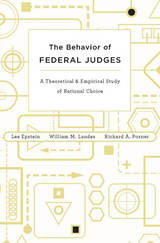 The Behavior of Federal Judges: A Theoretical and Empirical Study of Rational Choice
Lee Epstein, William M. Landes, and Richard A. Posner
Harvard University Press, 2012 Judges play a central role in the American legal system, but their behavior as decision-makers is not well understood, even among themselves. The system permits judges to be quite secretive (and most of them are), so indirect methods are required to make sense of their behavior. Here, a political scientist, an economist, and a judge work together to construct a unified theory of judicial decision-making. Using statistical methods to test hypotheses, they dispel the mystery of how judicial decisions in district courts, circuit courts, and the Supreme Court are made.
The authors derive their hypotheses from a labor-market model, which allows them to consider judges as they would any other economic actors: as self-interested individuals motivated by both the pecuniary and non-pecuniary aspects of their work. In the authors' view, this model describes judicial behavior better than either the traditional “legalist” theory, which sees judges as automatons who mechanically apply the law to the facts, or the current dominant theory in political science, which exaggerates the ideological component in judicial behavior. Ideology does figure into decision-making at all levels of the federal judiciary, the authors find, but its influence is not uniform. It diminishes as one moves down the judicial hierarchy from the Supreme Court to the courts of appeals to the district courts. As The Behavior of Federal Judges demonstrates, the good news is that ideology does not extinguish the influence of other components in judicial decision-making. Federal judges are not just robots or politicians in robes.
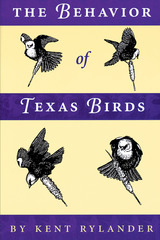 The Behavior of Texas Birds
By Kent Rylander
University of Texas Press, 2002 Whether it's the sudden, plunging dives of Brown Pelicans, the singing and aerial displays of Northern Mockingbirds, or the communal nesting of Purple Martins, innate and learned behaviors are some of the most fascinating things to observe in Texas birds. Even casual birdwatchers eventually ask, "why do they do that?" while serious birders and ornithologists seek to understand all the behaviors involved in feeding, flying, mating, and rearing young. But until now, it has been hard to find this information in one handy source. In this comprehensive, yet easy-to-use book, Kent Rylander distills data from many sources to provide an authoritative guide to the behavior of Texas birds. He begins by explaining the principles of animal behavior and illustrating how they can be applied to interpreting bird behaviors in the field. The majority of the book is devoted to accounts of more than 400 species of birds that are most likely to be encountered by Texas birdwatchers. Each account describes such behaviors as feeding, courtship, parenting, and other behaviors that are significant for that species. References to interesting and important articles from scientific journals are incorporated in the species accounts where appropriate, and line drawings illustrate some of the behaviors described.
 The Behavior of the Earth: Continental and Seafloor Mobility
Claude Allègre
Harvard University Press, 1988 Well over a century after Darwin gave biology its unifying theory of evolution, the earth sciences experienced a similar revolution and the theory of plate tectonics took hold. Plate tectonics posed the idea that the earth's crust is divided into a number of large, thin plates always in motion relative to one another. In The Behavior of the Earth, world-renowned earth scientist Claude Allègre sets forth the exciting events in this contemporary revolution from its first stirrings in the nineteenth-century and Alfred Wegener's original model of continental drift (1912) through the development of its full potential in modern plate-tectonic theory.
Few scientific theories have been so all-encompassing, and none has surpassed plate tectonics in explaining such a wide variety of geological phenomena, from the origins of mountain building to the formation of the ocean floor. As it integrated our knowledge of the earth's surface with the investigation of its interior, plate tectonics fused two previously autonomous strains of scientific inquiry. Continental mobility changed for all time our view of the earth from a static globe to an evolving, living planet, and allowed us to see that changes in the earth's surface are but exterior manifestations of a dynamic interplay of forces within the crust and the mantle.Allègre casts his lucid exposition of this scientific theory within the historical context of its struggle for acceptance. As he introduces us to the huge cast of personalities and researchers who contributed to the theory, he illuminates the complex role that the scientific community plays in the proliferation and acceptance of new ideas. Allègre is as insightful in discussing the human motivation for scientific endeavor as he is skillful in presenting the science that results from this effort. Richly illustrated and including a glossary, this book offers the reader rare access both to the central theory of plate tectonics and to the constellation of problems and possibilities that preoccupy earth scientists today.
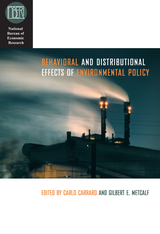 Behavioral and Distributional Effects of Environmental Policy
Edited by Carlo Carraro and Gilbert E. Metcalf
University of Chicago Press, 2001 Most people would agree that it makes sense to tax a company that pollutes in a way that directly reflects the amount of environmental and social damage it has done. Yet in practice, such taxes are fraught with difficulty and have far-reaching implications. A company facing a new tax may lay off workers, for example, exacerbating an unemployment problem. This volume focuses on such external issues and examines in detail the trade-offs involved in designing policies to deal with environmental problems. Reflecting the broad nature of the subject, the contributors include leading economists in the areas of public finance, industrial organization, and trade theory, as well as environmental economists. Integrating both theoretical and empirical methods, they examine environmental policy design as it relates to location decisions, compliance costs, administrative costs, effects on research and development, and international factor movements. Shedding light on an extraordinarily complex and important topic, this collection will be of interest to all those involved in designing effective environmental policy.
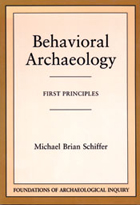 Behavioral Archaeology
Michael Brian Schiffer
University of Utah Press, 1995 Behavioral archaeology is an emerging branch of anthropology emphasizing the study of relationships between human behavior and artifacts (material culture) in all times and places. As such, it aspires to make contributions beyond the confines of archaeology to other behavioral sciences and to society in general.
Behavioral Archaeology is a selection of writings by Michael Schiffer, one of the field’s primary proponents. The chapters include important works published between 1972 and 1987, the formative period of behavioral archaeology. Schiffer has crafted a lengthy introduction to the coume, a personal history that contextualizes the development of these works. Also new is the last chapter, which lists—and keys to the preceding chapters—the field’s most important principles, tenets, and premises.
Readers will discover that although behavioral archaeologist have put archaeological inference on a scientific footing and have fostered the growth of experimental archaeology and ethnoarchaeology as research strategies, behavioral archaeology is not confined to methodology.
Indeed, cultivation of the fields established here is leading to the development of new behavioral science focused on studies of people-artifact interactions. By closely juxtaposing method and theory, principles and applications, science and history, this book illustrates the coherence and scope of behavioral archaeology’s conceptual framework.
The Behavioral Ecology of Efe Pygmy Men in the Ituri Forest, Zaire
Robert C. Bailey
University of Michigan Press, 1991 Robert C. Bailey reports on his observations of sixteen Efe Pygmy men in northeastern Zaire. Bailey lived and worked with the men and their families in the northern Ituri Forest from March 1980 to January 1982—his research was part of a multidisciplinary project called the Ituri Project. Bailey presents data on food production, subsistence behaviors, hunting techniques, relationships between hunters and village dwellers, and other aspects of the Efe society. Foreword by John D. Speth.
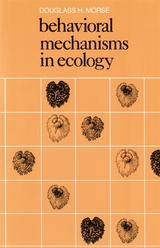 Behavioral Mechanisms in Ecology
Douglass H. Morse
Harvard University Press, 1980 This readable text represents a much needed synthesis of ecological insight into animal behavior. The field of behavioral ecology is relatively new, having evolved from a combination of classical ethology, as developed by Lorenz and Tinbergen, and population ecology. Now for the first time, a single author integrates the vast literature on animal ecology and behavior into a conceptual whole.
Exploring the theme of resource acquisitions, Douglass H. Morse combines the comparative approach to biology with models based on evolutionary theory. Secondary consequences of sexual selection and other selective pressures are considered in detail. Discussion of interspecific interactions and constraints is especially rich, as is the treatment of foraging theory, kinship theory, habitat selection and predator avoidance. Perhaps the book’s greatest achievement, however, is its unparalleled ecological and evolutionary analysis of individual differences.
Behavioral Mechanisms in Ecology will meet the teaching and reference needs of an extremely broad audience of professional biologists.
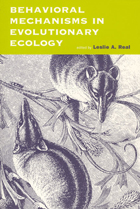 Behavioral Mechanisms in Evolutionary Ecology
Leslie A. Real
University of Chicago Press, 1994 The first book-length exploration of behavioral mechanisms in evolutionary ecology, this ambitious volume illuminates long-standing questions about cause-and-effect relations between an animal's behavior and its environment. By focusing on biological mechanisms—the sum of an animal's cognitive, neural, developmental, and hormonal processes—leading researchers demonstrate how the integrated study of animal physiology, cognitive processes, and social interaction can yield an enriched understanding of behavior.
With studies of species ranging from insects to primates, the contributors examine how various animals identify and use environmental resources and deal with ecological constraints, as well as the roles of learning, communication, and cognitive aspects of social interaction in behavioral evolution. Taken together, the chapters demonstrate how the study of internal mechanistic foundations of behavior in relation to their ecological and evolutionary contexts and outcomes provides valuable insight into such behaviors as predation, mating, and dispersal.
Behavioral Mechanisms in Evolutionary Ecology shows how a mechanistic approach unites various levels of biological organization to provide a broader understanding of the biological bases of behavioral evolution.
The Behavioral Origins of War
D. Scott Bennett and Allan C. Stam
University of Michigan Press, 2003 In The Behavioral Origins of War, D. Scott Bennett and Allan C. Stam analyze systemic, binary, and individual factors in order to evaluate a wide variety of theories about the origins of war.
Challenging the view that theories of war are nothing more than competing explanations for observed behavior, this expansive study incorporates variables from multiple theories and thus accounts for war's multiplicity of causes. While individual theories offer partial explanations for international conflict, only a valid set of theories can provide a complete explanation. Bennett and Stam's unconventional yet methodical approach opens the way for cumulative scientific progress in international relations.
D. Scott Bennett is Professor of Political Science at the Pennsylvania State University. Allan C. Stam is Associate Professor in the Government Department at Dartmouth College.
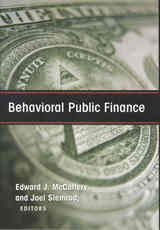 Behavioral Public Finance
Edward J. McCaffery
Russell Sage Foundation, 2006 Behavioral economics questions the basic underpinnings of economic theory, showing that people often do not act consistently in their own self-interest when making economic decisions. While these findings have important theoretical implications, they also provide a new lens for examining public policies, such as taxation, public spending, and the provision of adequate pensions. How can people be encouraged to save adequately for retirement when evidence shows that they tend to spend their money as soon as they can? Would closer monitoring of income tax returns lead to more honest taxpayers or a more distrustful, uncooperative citizenry? Behavioral Public Finance, edited by Edward McCaffery and Joel Slemrod, applies the principles of behavioral economics to government's role in constructing economic and social policies of these kinds and suggests that programs crafted with rational participants in mind may require redesign. Behavioral Public Finance looks at several facets of economic life and asks how behavioral research can increase public welfare. Deborah A. Small, George Loewenstein, and Jeff Strnad note that public support for a tax often depends not only on who bears its burdens, but also on how the tax is framed. For example, people tend to prefer corporate taxes over sales taxes, even though the cost of both is eventually extracted from the consumer. James J. Choi, David Laibson, Brigitte C. Madrian, and Andrew Metrick assess the impact of several different features of 401(k) plans on employee savings behavior. They find that when employees are automatically enrolled in a retirement savings plan, they overwhelmingly accept the status quo and continue participating, while employees without automatic enrollment typically take over a year to join the saving plan. Behavioral Public Finance also looks at taxpayer compliance. While the classic economic model suggests that the low rate of IRS audits means far fewer people should voluntarily pay their taxes than actually do, John Cullis, Philip Jones, and Alan Lewis present new research showing that many people do not underreport their incomes even when the probability of getting caught is a mere one percent. Human beings are not always rational, utility-maximizing economic agents. Behavioral economics has shown how human behavior departs from the assumptions made by generations of economists. Now, Behavioral Public Finance brings the insights of behavioral economics to analysis of policies that affect us all.
|
|
